DICTIONARY OF OLD SCHOOL AEROSOL ART. Staffan Jacobson, Ph.D. Art History.
(TTP) stands for Tags,Throw-ups, Pieces; (TG) stands for Traditional Graffiti, (SA) for Street Art. All continents. All photos are by the author except when so noted. Revision continues. All valorisation is mine. So here we go — back to the ’70:s, ’80:s and ’90:s!
 A B C D E F G H I J K L M N O P Q R S T U V W X Y Z
A B C D E F G H I J K L M N O P Q R S T U V W X Y Z
3D-graffiti. Three dimensional expression which treat the letter as a sculptural object. See » Daim, 3D. 3D English writer, close friend to Goldie and Banksy. Image Courtesy 3D.
3D English writer, close friend to Goldie and Banksy. Image Courtesy 3D.

4 elements of hip-hop. While there is some debate over the number of elements of hip-hop, there are four elements that are considered to be its pillars: deejaying, or “turntabling”; rapping, also known as “MCing” (emceeing) or “rhyming”; graffiti painting, also known as “graf” or “writing”; and break dancing, or “B-boying,”
5points. Landlord Wolkoff started leasing the space as artists’ studios in the 1990s. The building’s exterior was covered with street art, and the building became renowned worldwide for the art on its wall. Originally known as Fun Factory, the building was renamed ”5 Pointz” in 2002 when the graffiti artist Jonathan Cohen began curating the exterior murals. The new name represents the confluence of the five boroughs of New York City. The murals were exhibited mainly on the exterior walls of the building, while the interior was occupied by about 200 artists’ studios. In 2013, Wolkoff made the controversial decision to demolish 5 Pointz and replace it with a residential complex, resulting in protest. Without giving any warning, Wolkoff had the murals whitewashed overnight, which led the artists to file a lawsuit against Wolkoff. The 5 Pointz building was demolished completely in 2014. Construction on the new building complex started in 2015, with expected completion in early 2020. In February 2018, Wolkoff was ordered by a judge to pay $6.7 million in damages to 21 artists. (Below 5points. Courtesy Wikimedia Commons).

156 crew. International high status crew initiated by Jon 1 and with lots of loose members all over.
ABC (TTP) Art Bombing Clan crew in Münich, Germany was started 1988. Won – known for his much advanced (usually red pink) characters – is one of the members, as are Cowboy 69 and Vince from München and it also includes writers from Basel. Other members through the years are Rebel, Shame, Gawky, Crash, Cash, Gjeli, Maroc, Craze, Zope, Mosart und Chromz (R.I.P.) A famous huge piece is ”ABC ́s Crazy Orman Monsdare” by Won, Cowboy 69, Vince, Dare, Show. München Hall of Fame 1992. Lit.: Schluttenhafner/Klaußenborg (ed.): Graffiti Art. Deutschland – Germany. Schwartzkopf, Berlin 1995; Won: Colour Kamikaze. Ed. Kunst der Comics, Germany 1999; Juice nr 8/1999. Website: http://www.studio-now.de/abc-graffiti/abc.htm
Below: WON/ABC in his studio in München. Image:Wikimedia Commons.
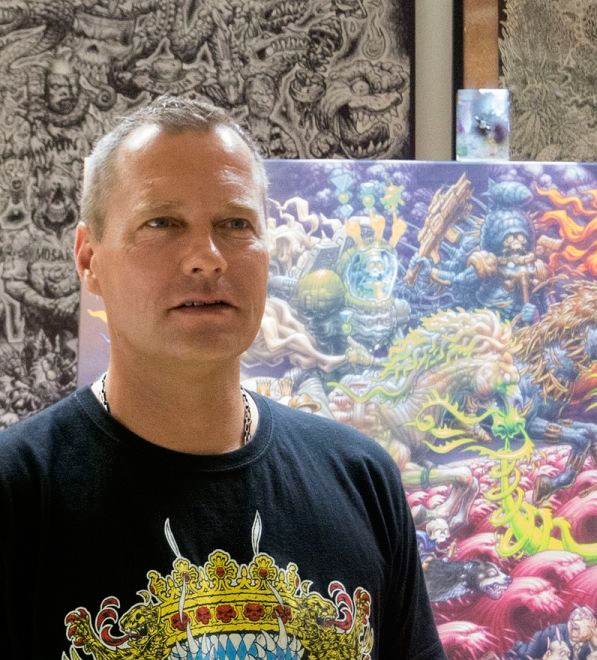
ABC No Rio Dinero. Lit.: ABC No Rio Dinero.The Story of a Lower East Side Art Gallery. Ed: Alan More, Marc Miller. (Catalogue.) Abc No Rio, N.Y. 1985. 195 p.
Ace 137 Early Old school tagger from N.Y.
Admiror, (TG) Paries, te non cecidisse ruinis, qui tot scriptorium taedia sustineas – latin graffiti scratching from Pompeii 79 A.C that could be translated “I admire you, wall, that by all this scribble you do not fall, you, the dumping-ground for all writers!”
Adolescent Art Is there an Art of the Young? Children ́s Art and drawing development has been carefully described (by Kelloggs a.o) and it also inspired artists such as Klee and Dubuffet. But the common opinion has been that these aesthetically dynamic early years come to an end in the pre- puberty phase, which has been described as regressive and utterly self critical. Some take up comix influences or look for “realism”; too many young people quit drawing completely during this stage. But with the 1970s and 80s this situation has been changed to a high degree. The TTP-movement has borne a new interest for pictorial creativity by many thousand youngsters over the world, and this time it will be useless to deny that even teenagers can make art. Lit. Hartwig, Hellmut: Jugendkultur – Ästhetische Praxis in der Pubertaät. Rowohlt, Hamburg 1980. 381 p. and Hartwig, Hellmut: “Graffiti als stellvertreter affekte.” In: S. Müller: Graffiti – Tätowirte Wände. Bielefelt 1985, p. 133-141.
Adrenalin 1. C9H13NO3, a hormone which increases heart rate, blood pressure and blood sugar level, and what really hits you when you are doing » tags, » throw-ups or» pieces.
2. The title of an exhibition of Aerosol Art held at City Gallery in Melbourne, Australia July 9 – July 23,1988 with Jme, Prime, Spy, Zikos, Peril, Ransom, Jule, Wisp, Guy and Jay.
Aeroplane, writing on (TTP) The first to tag an aeroplane was > Cornbread. He wrote his name on the wings of a TWA aircraft which left Philadelphia Airport for the south in the late 60 ́s. There have been some similar occasional events since then. But the first ”whole plane” piece, from tail to cockpit, was done in early January 27, 2001 by Danish writers on a white Fokker plane at Kastrup Airport, Copenhagen. And in 2014 Os Gemeos was comissioned to paint a Boeing 737 to celebrate the soccer world cup in Brazil (below). Lit.: Padwe, Sandy: The Aerosol Autographers – Why They Do It. Philadelphia Inquirer Magazine, May 2, 1971; Fly overmalet med graffiti. Politiken 27/1 2001; Klint, Lars: Flygplan täcktes med graffiti. Expressen 29/1 2001.
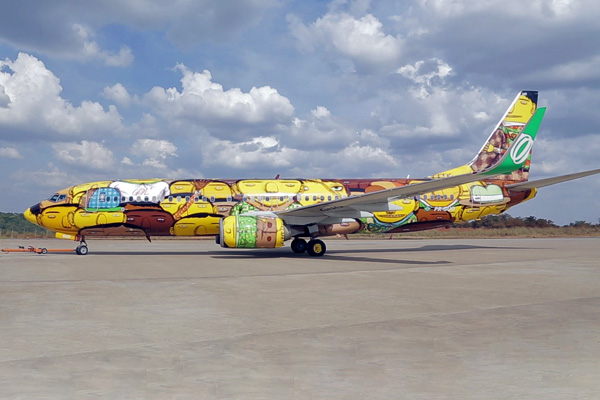
The Os Gemeos jet plane. Photo courtesy World Airline News.
Aerosol Art (TTP) One of the synonyms of Tags/Throw-ups/Piece (TTP); Spraycan Art, Spray Art, Subway Art (see these words) and similar expressions are also used. Definition: It means the historically new and independent kind of graffiti originated by youngsters in Philadelphia and New York in the late 1960s/ early 1970s which spread over the world in the 1980s – doing» tags,» throw- ups and» pieces with marker and spray paint on walls and trains, mainly under subcultural and unlawful circumstances. The motif is primarily the letter, sometimes with characters, and the concept is one of style. » Wild style lettering is one of the most prolific, complex and original contributions from youth culture to art history ever. Aerosol Art also includes legal and socially accepted forms such as spray art on canvas or commissioned wall art. Lit: Jacobson, Staffan: The Spray-Painted Image. (Diss.) Aerosol Art Archives, Lund University, Sweden 1996.
Aerosol Kingdom The title of a famous burner by »Vulcan, N.Y. 1986. Lit.: Chalfant/Prigoff: Spraycan Art. T&H, London 1987. He also initiated the worlds first Hall of Fame (HoF) at a school yard on 106 str. in Spanish Harlem, N.Y. which was followed of HoF:s all over the world.

Aerosoul Magazine (TTP) Note the spelling! Fanzine in full colours, published in Rihen, Switzerland since 1993.
Aesthetics of Graffiti. (TTP) TTP has a very special art criticism of its own. The means of the painting should be rational (see Technique) but the result ought to be “impressive”. The most wanted response is a “Wow!” and a state of visual shock and physical excitement, not an intellectuel reaction. When writers judge each other ́s pieces, the following criteria are usually taken under consideration:
1) technique, 2) fantasy and originality, 3) style 4) colours, 5) size, 6) physical difficulty and effort , 7) location , 8) risk, 9) time, 10) total impression..
Out of those criteria an objective judgment is possible: to divide the good work from the not so good . But that does not mean judgement is necessary, because one could also look at a piece in many other ways, as is done in pictorial analyses or when reviewed by non-writers. But knowledge and experience, and an open mind nonetheless, heighten the reception for everybody. Then, you can have just as good a time watching the piece as the writer had doing it!
Afghan Trucks (SA) A very special public art form exists in Afghanistan and Pakistan where drivers decorate their private truck vehicles with Arabic calligraphy (even in 3-D style!), ornaments, patterns and romantic, somewhat naive pictures of modern life and technology, religious motifs, women or landscapes in bright colours. Lit.: Blanc, Jean-Charles: Afghan Trucks. Stonehill, N.Y. 1976. Image Wikmedia Commons.

Ahearn, Charlie (TTP) *1951, N.Y; known as the author of the film » “Wildstyle” 1982. Also runs Pow Wow Productions in N.Y.
Ahearn, John (SA) * 1951, N.Y. Painter and sculptor, known above all for 50 life- cast portraits of Bronx inhabitants 1979, organising» The Times Square Show 1980 and cooperating with COLAB and» Fashion Moda.
AIO (TTP) All In One is originally the crew of the Swedish writers Circle (letters) and Weird (characters), and it includes writers from Denmark and Germany, such as Bates and Side. The group is known for big murals like “Fascinate” 1989 and “Apocalypse” 1991, for a “clean” letter style and sometimes of Arabic art influences in characters.”Fascinate” was later to become an officially preservd cultural memory..

Airbrush (TTP) Invented in the 1890s by Joe Binks for fast white-washing and improved with a breakthrough in 1923 that brought more suitable colours. This tool, as well as the spray gun, is far more sophisticated – and also constitutes heavier equipment – than a spray can, and is mostly used for commercial art and speciality painting on cars etc. It gives a smooth and slick image with acrylics and a glossy surface with enamels. Writers sometimes use it on T-shirts, jackets or fancy works on cars. Lit.: Peacock, Ian: Airbrushing and spray painting manual. Argus Books, England (1984) 1989.
AIS (TTP) Atlantic Island Warriors, contemporary German crew.
Ak, Edith de (TTP) Art critic who made the most essential interview so far with Rammellzee in the article Train as Book, Letter as Tank, Character as Dimension in Art Forum, May 1983, p. 88-93. One of the few intellectuals in this art movement. She also wrote about» Dondi in Dondi White. , Feb 1983, p. 83-84.
AK-47 (SA) Chinese Street Art artist Zhang Dali write ”AK-47” or ”18K” in the urban Beijing environment in the late 1990 ́s. Lit.: Stuart, Lyn: Dialog- the graffiti art of 18K.” Bejing Scene, Vol 5, Issue 4, 1999.
Akay (TTP) Swedish writer, together who with News, Thrill and Dudge are the original members in the » VIM crew, (Vandals In Motion) started 1988. In Spring 1990 VIM painted Sweden ́s first whole-train – 8 whole cars ( 200 meters) by Akay, Ceios, Dudge, News and Terror. The slogan ”akayism” appears to be tagged posters in of various kinds, applied with glue on the wall, stencil letters, stickers and spraypaint applied together in a conscious and creative street-art manner on the urban consumistic evironment. Sometimes there is a message: ”I scribble therefore I am”, ”I want my planet back” or a pleasantly puzzling one like ”Akayism is your only protection”. Akayism has become a concept in it self and for a radical transgression of Swedish graffiti. Lots of pictures on www.akayism.com Lit.: Malm, Rasmus: Public Space. A Guerilla Art Attack hits Stockholm. Adbusters magazine, June/July 2000. http://adbusters.org/campaigns/urbanspace/stockholm.html

Alfresco History (TG) Review of William McLean ́s book » Contribution a L’etude de L’iconographie Populaire de L’erotisme. Lit.: Alfresco History . Time, April 13, 1970, p. 41.
Alienation is both a structural and a mental state , caused by the compart mentalization of work, life and relationships which prevent perspective and understanding and make us feel like soulless consumers with no power over our own lives. An non-alienated act among others could be a creative and subversive one, an “art crime”, like writing graffiti. Lit.: Internationale Situationniste. Nr 1/1958 – 12/1969. Ed.: Guy Debord. Éditions Champs Libre, Paris 1975. and Israel, Joachim: Alienation – från Marx till modern sociologi. Lund 1968.
Alinovi, Francesca (TTP) Italian art critic who wrote the famous article “Twenty-First Century Slang”, since then translated into many languages, for the »Arte di Frontiera exhibition catalogue Lit.: Arte di Frontiera – New York Graffiti. Mazzota, Milano 1984.
All City (TTP) Describes writers who tag ubiquitously. Cornbread in Philadelphia was the first “tagger” and the first all city writer, Taki 183 was first in New York with this ambition (even though Julio started tagging before him in the same city). Lit.: Stewart, Jack: Subway Graffiti: An aesthetic study of graffiti on the subway system of New York City, 1970-1978. New York University, N.Y. 1989. ; and Ley, David & Cybriwsky, Roman: Urban Graffiti as Territory
Antarctic graffiti (TG) According to Walter Sullivan in his book “Quest for a Continent”, the name “Finn Ronne” was written by his father Martin Ronne in an Antarctic camp during the first successful expedition, and recognised during a later expedition in 1933. Lit.: Reisner, Robert: Graffiti. Two Thousand Years of Wall Writing. Cowles, N.Y. 1971, p. 15.
Anti-fascist Art in Spain. (TG) Anti-fascist Art in Spain. The Anarcho-Syndicalist Spanish Revolution 1936-1939 during the Civil War against Franco was also a movement with huge artistic creativity, as can be seen in the excellent colored propaganda posters, the wall paintings – and even the painted trains (!) and other vehicles, ”agitprop” (see below). Pablo Picasso’s enormous protest painting ”Guernica” (1936) on the nazibombning of this small Spanish city remains one of the worlds most famous masterpieces. .http://picturebook.nothingness.org/pbook/1936/display/57

Anti-Graffiti (TTP) » Graffiti Prevention. Anti-Graffiti Network Organisation started in Philadelphia 1984 by its mayor ; see also » NGIN. Long since defeated with the decline of Zero Tolrance against Graffiti. ”Harm reduction” and a broad acceptance would follow instead. Still, it is a rebellious art form.
A-One (TTP) Anthony Clark, * 1964, Manhattan, N.Y., writer and painter with several successful exhibitions in USA and Europe. Lit.:Parmesani, Loredana: A One. Flash Art 116, March 1984, p. 44.
Arctic graffiti (TTP) The first T-2-B train piece at the Arctic pole circle was done in 1993 by the finnish writers Hiv, Poe and Egs. Lit.: Monmagnon, Olivier: Sabotage! Florent-Massot, Paris 1995. (The chapter of Finland, last pages.)
Arris (TTP) South African writer in the TVA tribe (The Villainous Animators) crew in South Africa.
Arrow, the (TTP) 1) The arrow, designed in a personal way, is an important detail in» Wildstyle lettering to add life and motion to the letter-picture. It is seen in both traffic signs and Islamic» calligraphy, but how it got into Wildstyle is not quite clear. However, Cool Earl used the arrow – according to Jack Stewart – in Philadelphia as early as 1966!
2) The Arrow (TTP) – a writer-organised, major exhibition (50-80 big canvases) of contemporary aerosol art, held in Stockholm July 27 – Aug. 9, 1998, including live painting, American guests, a daily guided tour and video documentation. Organisers » Twisted Minds (Denmark) Roots Org. and Stocktown 98 (Sweden).

Art There is hardly any definition of “art” accepted by everyone, but there are several possible ones. “The institutional definition” by George Dickie goes:
“A work of art in the classificatory sense is 1) an artifact 2) upon which some person or persons acting on behalf of a certain social institution (the art world) has conferred the status of a candidate for appreciation.”
TTP as an underground movement which at the same time has been accepted in the galleries, by critics and therefore by the art world seems to be art by this definition. TG could be seen as > Art Brute (“raw art”) according to the French informal painter Dubuffet. Both forms have been an important source of inspiration for academic trained and/or successful artists, as TTP for Keith Haring and Jean-Michel Basquiat and TG for Picasso and Klee. Lit.:Dickie, George: Aesthetics. An Introduction. Pegasus, N.Y. 1971.
Art After Midnight The title of a book by Steven Hager, which in a lively way describes the bohemian avant garde night life at the New Wave clubs and graffiti galleries of the Lower East , Manhattan in the mid-80:s, during the “art boom”, a melting pot that created contacts between the young students from School of Visual Arts and the Bronx writers and led to the so-called Street Art phenomena and the interest for spray art on canvas. Lit.: Hager, Steven: Art After Midnight. St. Martins Press, N.Y. 1986. See also: Fashion Moda.
Art and Life is One. Quotation (of high validity for TG and TTP) by Tristan Tzara,1896-1963, French-Romanian author, one of the founders of the DADA movement in Zürich 1916.
Art Brut (“raw art”) French term used by > Dubuffet, representing certain informal art in reaction against the academic taste. Dubuffet in 1947 began collecting art by non-professionals like art of the insane, of children, so called “primitive” art and by amateurs. The Collection de l’Art brut has 5000 pictures and sculptures by 200 artists, and is now a museum in the city of Lausanne.
Art Crimes The largest (30.000 visitors per day) graffiti site on the Internet contains TTP-actualities and world-wide pieces, available at the Internet on http://graffiti.org. Susan > Farrell was its originator in 1994 and it is still run by Susan and Brett Webb. Art Crimes also has links to most other graffiti-sites in the world.
Art Nouveau» Mucha» Psychedelic Art.
Arte di Frontiera (TTP) An exhibition of Aerosol Art held at Galleria communala d ́arte moderna in Bologna, Italy in March-April 1984 with Futura 2000, J-M Basquiat, K. Haring, K.Scharf, Koor, Lee, Jenny Holzer, Lady Pink, Richard Hambleton, John Ahearn and others.
Art World. The elitist network institution (curators, critics, art dealers, gallery owners etc.) with a consensus decide what to appreciate as Art (see: Dickie). Banksy says: ”The Art World is the biggest joke of all. It´s a retirement för the over-priviliged and the prententious.” A sociological survey of this power group could be very revealing. A future research project!
The interaction with and integration of the writers from Bronx and the down town galleries’ Art World in the 1980:s had some undesired complications. Fashion Moda, a Bronx non-elitist gallery, did everything right. But most galleries did it in an unproper way: the writers was seen as exotic and with no cultural capital; the hiphop culture was overseen. Some of the writers did cope, some did not as suddenly it was all about money and sell-out. Aerosol Art can very well be on canvas and commissions and legal spaces are OK, but city walls and trains are the superior surroundings for this free art form, done just for the joy of it. Integrity is king!
See: Art.
Ash II (TTP) *1968 in Madrid, member of the» BBC crew, known for his excellent canvas work.

Ask (TTP) Swedish writer of the late 1990:s, known for excellent colouring in characters, and his cute monsters. Cooperating with Marvel who does the letters.
Astor, Patti (TTP) Gallery owner from N.Y, participant in the film»“Wildstyle” 1982 in the role of a slightly naive journalist.
At 149 st. (TTP) A New York City website done by writers in memory of the Writers Bench at 149 st. Authentic information. On: www.at149st.com
Atom (TTP) Writer from Brooklyn, N.Y. (SCA. p. 37). There is also a contemporary German writer (born 1972) who has taken the name AtomOne.
Avelon 31 (TTP) Danish fine arts painter, former writer in the Dark Roses crew with» Romance and now in the Killing Fields crew. Lit.: Poulsen, Rasmus: Graffiti i Danmark. Klematis, Denmark 1997. Below a painting in Berlin 2019 by Alm 1, Avelon 31, DoggeDoe & Noz / Dark Roses. http://www.thedarkroses.com/

http://www.studio-now.de/abc-graffiti/abc.htm
ABC No Rio Dinero. Lit.: ABC No Rio Dinero.The Story of a Lower East Side Art Gallery. Ed: Alan More, Marc Miller. (Catalogue.) Abc No Rio, N.Y. 1985. 195 p.
Ace 137 Early Old school tagger from N.Y.
Admiror, (TG) paries, te non cecidisse ruinis, qui tot scriptorium taedia sustineas – latin graffiti scratching from Pompeii 79 A.C that could be translated “I admire you, wall, that by all this scribble you do not fall, you, the dumping-ground for all writers!”.
Adolescent Art Is there an Art of the Young? Children ́s Art and drawing development has been carefully described (by Kelloggs a.o) and it also inspired artists such as Klee and Dubuffet. But the common opinion has been that these aesthetically dynamic early years come to an end in the pre- puberty phase, which has been described as regressive and utterly self critical. Some take up comix influences or look for “realism”; too many young people quit drawing completely during this stage. But with the 1970s and 80s this situation has been changed to a high degree. The TTP-movement has borne a new interest for pictorial creativity by many thousand youngsters over the world, and this time it will be useless to deny that even teenagers can make art. Lit. Hartwig, Hellmut: Jugendkultur – Ästhetische Praxis in der Pubertät. Rowohlt, Hamburg 1980. 381 p. and Hartwig, Hellmut: “Graffiti als stellvertreter affekte.” In: S.Müler: Graffiti – Tätowirte Wände. Bielefelt 1985, p. 133-141.
Adrenalin 1). C9H13NO3, a hormone which increases heart rate, blood pressure and blood sugar level, and what really hits you when you are doing » tags,» throw-ups or» pieces.
2). The title of an exhibition of Aerosol Art held at City Gallery in Melbourne, Australia July 9 – July 23,1988 with Jme, Prime, Spy, Zikos, Peril, Ransom, Jule, Wisp, Guy and Jay.
Aerosol School (TTP) or the Aerosolskolan was an independent graffiti community centre in Uppsala, Sweden in early 1990:s which was very successful for 2 years. Wellknown writers as Code (headmaster), Dwane and Pike were teaching art class basics and spray can technique on a regular and well-organised basis. The school also initiated similar activities in several other cities , made a project painting in Katowice, Poland (the first in that country) and in autumn 1992 held a major convention with the BBC crew, Africa Bambaataa, James Prigoff and writers from all Europe. During this period of the Schools activities, the illegal graffiti in the city decreased at a significant rate, which was also the case at» Kungsholmens Graffitiskola in Stockholm 1989. Lit.:Aerosol School Goes to Katowice. Erik Olsson/IOR/Studiefrämjandet/Hip Hop Corporation, Uppsala 1991. Videogram, documentary, 25 min. Below: Prigoff & Pärra & Bambaata at the Aerosol School Summt in Uppsala. To the Right: One of the notorious Graffiti kids.
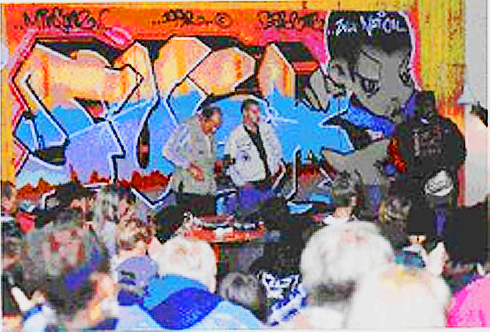

Aerosoul Magazine (TTP) Note the spelling! Fanzine in full colours, published in Rihen, Switzerland since 1993.
Aesthetics of Graffiti. (TTP) TTP has a very special art criticism of its own. The means of the painting should be rational (see Technique) but the result ought to be “impressive”. The most wanted response is a “Wow!” and a state of visual shock and physical excitement, not an intellectuel reaction. When writers judge each other ́s pieces, the following criteria are usually taken under consideration:
1) technique, 2) fantasy and originality, 3) style 4) colours, 5) size, 6) physical difficulty and effort , 7) location , 8) risk, 9) time, 10) total impression.
Out of those criteria an objective judgment is possible: to divide the good work from the not so good . But that does not mean judgement is necessary, because one could also look at a piece in many other ways, as is done in pictorial analyses or when reviewed by non-writers. But knowledge and experience, and an open mind nonetheless, heighten the reception for everybody. Then, you can have just as good a time watching the piece as the writer had doing it!
Ahearn, John * 1951, N.Y. Painter and sculptor, known above all for 50 life-cast portraits of Bronx inhabitants 1979, organizing» The Times Square Show 1980 and cooperating with COLAB and» Fashion Moda.
AIO (TTP) All In One is originally the crew of the Swedish writers Circle (letters) and Weird (characters), and it includes writers from Denmark and Germany, such as Bates and Side. The group is known for big murals like “Fascinate” 1989 and “Apocalypse” 1991, for a “clean” letter style and sometimes of Arabic art influences in characters.
Airbrush (TTP) Invented in the 1890s by Joe Binks for fast white-washing and improved with a breakthrough in 1923 that brought more suitable colours. This too l, as well as the spray gun, is far more sophisticated – and also constitutes heavier equipment – than a spray can, and is mostly used for commercial art and speciality painting on cars etc. It gives a smooth and slick image with acrylics and a glossy surface with enamels. Writers sometimes use it on T-shirts, jackets or fancy works on
cars. Lit.: Peacock, Ian: Airbrushing and spray painting manual. Argus Books, England (1984) 1989.
AIS (TTP) Atlantic Island Warriors, contemporary German crew.
Ak, Edith de (TTP) Art critic who made the most essential interview so far with Rammellzee in the article Train as Book, Letter as Tank, Character as Dimension. in Art Forum, May 1983, p. 88-93. She also wrote about» Dondi in Dondi White. , Feb 1983, p. 83-84.
AK-47 (SA) Chinese Street Art artist Zhang Dali write ”AK-47” or ”18K” in the urban Beijing environment in the late 1990 ́s. Lit.: Stuart, Lyn: Dialog- the graffiti art of 18K.” Bejing Scene, Vol 5, Issue 4, 1999.
Akay (TTP) Swedish writer, together who with News, Thrill and Dudge are the original members in the » VIM crew, started 1988. In Spring 1990 VIM painted Sweden ́s first whole-train – 8 whole cars ( 200 meters) by Akay, Ceios, Dudge, News and Terror. The slogan ”akayism” appears to be tagged posters in of various kinds, applied with glue on the wall, stencil letters, stickers and spraypaint applied together in a conscious and creative street-art manner on the urban consumistic evironment. Sometimes there is a message: ”I scribble therefore I am”, ”I want my planet back” or a pleasantly puzzling one like ”Akayism is your only protection”. Akayism has become a concept in it self and for a radical transgression of Swedish graffiti. Lots of pictures on http://www.akayism.com Lit.: Malm, Rasmus: Public Space. A Guerilla Art Attack hits Stockholm. Adbusters magazine, June/July 2000. http://adbusters.org/campaigns/urbanspace/stockholm.htm
Almaraz» Chicano Art
Aman (TTP) * 1973, Swedish writer who does small and intricate pieces. Below, Aman & Pker.
Amen (TTP) Swedish Christian writer, who collaborated with Zappo and Circle on the huge mural “Admire the Nature”, Norrköping 1991.
Amici della Catacombe (TG) The Vatican society for preservation of the Roman » catacombs. See also» Bosio.
Amok (TTP) German writer, King of Style in Berlin 1985-1991.

Anarchy, the symbol of (TG) The word “anarchy” comes from Greek “an”-  without, and “archos” – ruler, and it properly means a direct democratic society with no state, capitalism or hierarchy. One of the most frequent political graffiti symbols is the A inscribed in a circle. A is for Anarchy and the circle O is for Order, as in Kropotkin ́s proverb. There is photographic evidence from the Spanish Civil War 1936-39 where this sign was seen on a helmet; and 1956, on November 25, the Alliance Ouvriere Anarchiste (AOA) adopted this symbol. In recent time this symbol was championed by the magazine Jeunesses Libertaires in France, April 1964, as a suggestion for a graphic symbol of anarchism. Some influence from the > peace-sign is clear. 1966 it was used by the Sacco-Vanzetti group in Milan, and from the May revolt of Paris 1968 it was visible everywhere. In Europe it was from time to time connected with the > Punk movement and the squatter movement, (BZ). Today it is a generally accepted and widely spred symbol of anarchist ideas and of the new generation Anarchist and Autonomy activists. Lit.: Peter Peterson: ”Flag, Torch, and Fist: The Symbols of Anarchism”, Freedom, vol. 48, No. 11, p. 8. ; ”Geschichten des A.” Karin Kramer Verlag, Berlin 1982. On the history of the philosophy and the social movements : Woodcock, George: ”Anarchism”. The World Publ. Comp., N.Y. 1962. http://www.infoshop.org/faq/append2.html See also» BZ-graffiti.
without, and “archos” – ruler, and it properly means a direct democratic society with no state, capitalism or hierarchy. One of the most frequent political graffiti symbols is the A inscribed in a circle. A is for Anarchy and the circle O is for Order, as in Kropotkin ́s proverb. There is photographic evidence from the Spanish Civil War 1936-39 where this sign was seen on a helmet; and 1956, on November 25, the Alliance Ouvriere Anarchiste (AOA) adopted this symbol. In recent time this symbol was championed by the magazine Jeunesses Libertaires in France, April 1964, as a suggestion for a graphic symbol of anarchism. Some influence from the > peace-sign is clear. 1966 it was used by the Sacco-Vanzetti group in Milan, and from the May revolt of Paris 1968 it was visible everywhere. In Europe it was from time to time connected with the > Punk movement and the squatter movement, (BZ). Today it is a generally accepted and widely spred symbol of anarchist ideas and of the new generation Anarchist and Autonomy activists. Lit.: Peter Peterson: ”Flag, Torch, and Fist: The Symbols of Anarchism”, Freedom, vol. 48, No. 11, p. 8. ; ”Geschichten des A.” Karin Kramer Verlag, Berlin 1982. On the history of the philosophy and the social movements : Woodcock, George: ”Anarchism”. The World Publ. Comp., N.Y. 1962. http://www.infoshop.org/faq/append2.html See also» BZ-graffiti.

Animal ornaments (TTP) The Nordic animal ornaments style was used in handicrafts in the Scandinavian countries during the Vendel period, 550-800 A.D. There are some astonishing  similarities between this style and of TTP and its “camouflage” method , not in influences or historic circumstances, but in the execution: the animal shape (instead of the letter shape in TTP) was abstracted and rearranged to such an extent that just a decorative, rhythmic pattern was left in the picture. Still, the original shape could be discearned by training. Some of this is also true for Celtic Art, but in the above-mentioned case it is obvious. Lit.: Jacobson, Staffan: The Spray-Painted Image. (Diss.) Aerosol Art Archives, Lund University, Sweden 1996.

Antarctic graffiti (TG) According to Walter Sullivan in his book “Quest for a Continent”, the name “Finn Ronne” was written by his father Martin Ronne in an Antarctic camp during the first successful expedition, and recognised during a later expedition in 1933. Lit.: Reisner, Robert: Graffiti. Two Thousand Years of Wall Writing. Cowles, N.Y. 1971, p. 15. There is also an indogenic innuit TTP graffiti in Greenland.
Anti-Graffiti (TTP) » Graffiti Prevention
Anti-Graffiti Network Organisation started in Philadelphia 1984 by its mayor ; see also » NGIN.
A-One (TTP) Anthony Clark, * 1964, Manhattan, N.Y., writer and painter with several successful exhibitions in USA and Europe. Lit.:Parmesani, Loredana: A One. Flash Art 116, March 1984, p. 44.
Arctic graffiti (TTP) The first T-2-B train piece at the Arctic pole circle was done in 1993 by the finnish writers Hiv, Poe and Egs. Lit.: Monmagnon, Olivier: Sabotage! Florent-Massot, Paris 1995. (The chapter of Finland, last pages.)
Arris (TTP) South African writer in the TVA tribe (The Villainous Animators) crew in South Africa.
Arrow, the (TTP) 1) The arrow, designed in a personal way, is an important detail in» Wildstyle  lettering to add life and motion to the letter-picture. It is seen in both traffic signs and Islamic» calligraphy, but how it got into Wildstyle is not quite clear. However, Cool Earl used the arrow – according to Jack Stewart – in Philadelphia as early as 1966!
2) The Arrow – a writer-organised, major exhibition (50-80 big canvases) of contemporary graffiti art, held in Stockholm July 27 – Aug. 9, 1998, including live painting, American guests, a daily guided tour and video documentation. Organisers » Twisted Minds (Denmark) Roots Org. and Stocktown 98 (Sweden).
Art There is hardly any definition of “art” accepted by everyone, but there are several possible. “The institutional definition” by George Dickie is:
“A work of art in the classificatory sense is 1) an artifact 2) upon which some person or persons acting on behalf of a certain social institution (the art world) has conferred the status of a candidate for appreciation.”
TTP as an underground movement which at the same time has been accepted in the galleries, by critics and therefore by the art world seems to be art by this definition. TG could be seen as > Art Brute (“raw art”) according to the French informal painter Dubuffet. Both forms have been an important source of inspiration for academic trained and/or successful artists, as TTP for Keith Haring and Jean-Michel Basquiat and TG for Picasso and Klee. Lit.:Dickie, George: Aesthetics. An Introduction. Pegasus, N.Y. 1971.
Art After Midnight The title of a book by Steven Hager, which in a lively way describes the bohemian avant garde night life at the New Wave clubs and graffiti galleries of the Lower East , Manhattan in the mid-80:s, during the “art boom”, a melting pot that created contacts between the young students from School of Visual Arts and the writers and led to the so-called Street Art phenomena and the interest for spray art on canvas. Lit.: Hager, Steven: Art After Midnight. St. Martins Press, N.Y. 1986.
Art and Life is One. Quotation (of high validity for TG and TTP) by Tristan Tzara,1896-1963, French-Romanian author, one of the founders of the DADA movement in Zürich 1916.
Art Brut (“raw art”) French term used by > Dubuffet, representing certain informal art in reaction against the academic taste. Dubuffet in 1947 began collecting art by non-professionals like art of the insane, of children, so called “primitive” art and by amateurs. The Collection de l’Art brut has 5000 pictures and sculptures by 200 artists, and is now a museum in the city of Lausanne.

Art Crimes The largest (30.000 visitors per day) graffiti site on the Internet contains TTP-actualities and world-wide pieces, available at the Internet on http://graffiti.org. Susan > Farrell was its originator in 1994 and it is still run by Susan and Brett Webb. Art Crimes also has links to most other graffiti-sites in the world.
Art Nouveau» Mucha» Psychedelic Art.
Arte di Frontiera An exhibition of Aerosol Art held at Galleria communala d ́arte moderna in Bologna, Italy in March-April 1984 with Futura 2000, J-M Basquiat, K. Haring, K.Scharf, Koor, Lee, Jenny Holzer, Lady Pink, Richard Hambleton, John Ahearn and others.
Astor, Patti (TTP) Gallery owner from N.Y, participant in the film»“Wildstyle” 1982 in the role of a somewhat naive journalist.
Astronaut graffiti (TG) Visiting the Russian Mir Space Station, astronaut David Wolf wrote in a letter home in Oct. 13, 1997:
”Signatures and instruction placards written by the hands of over a decade of cosmonauts who maintained and lived in this true marvel of human achievement”. Since the first space journeys began there are occasionally rumors of graffiti on the Moon but thus far with no photographic evidence.
But sooner or later Kilroy most certainly will appear. 🙂 Below: Grafftti inside Apollo 11 (right) and a cartoon on the subject (left).
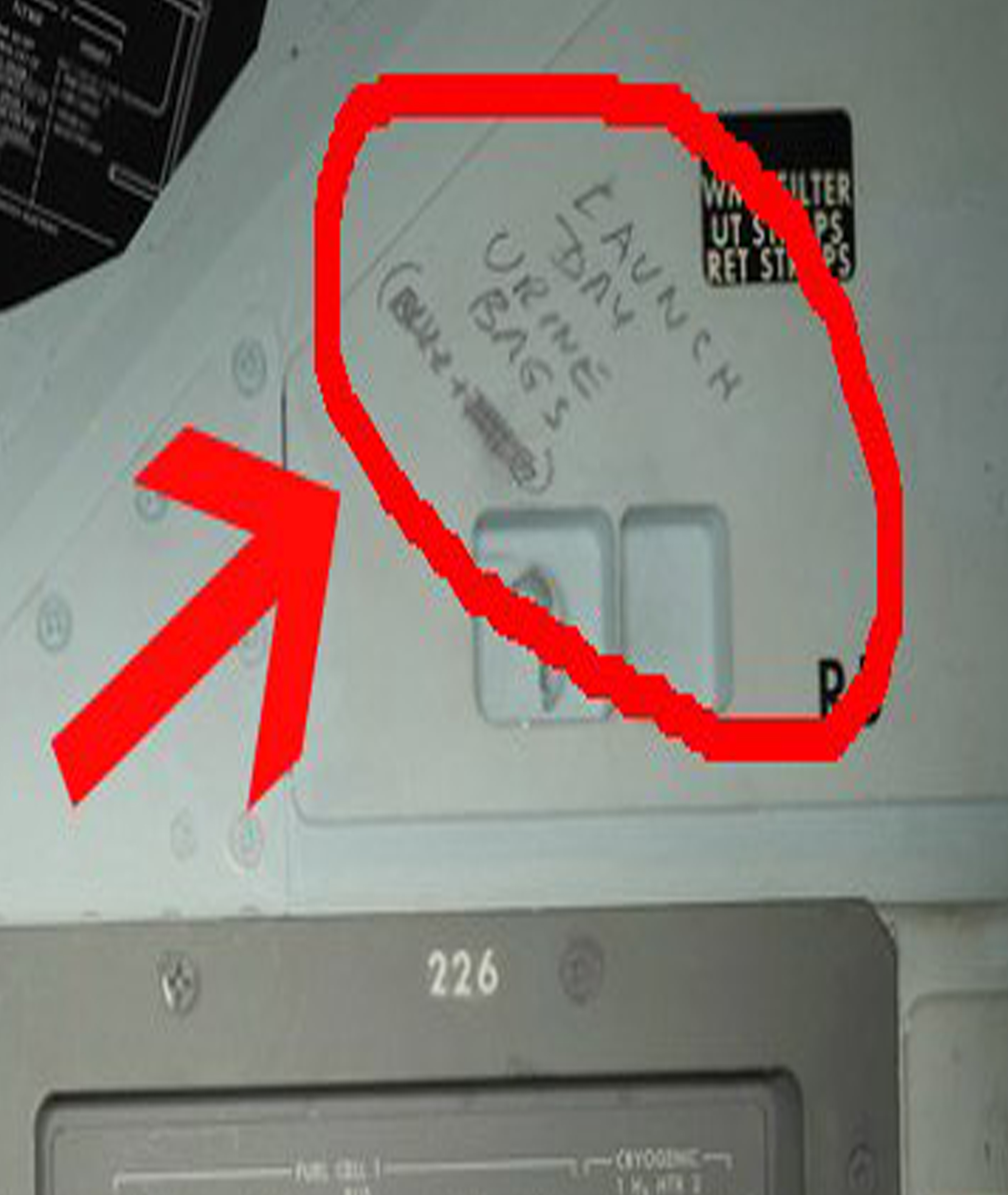
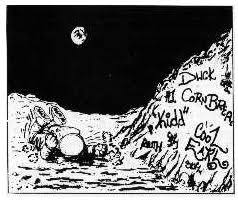
At 149 st. (TTP) A New York City website done by writers in memory of the Writers Bench at 149 st. Authentic information. On: www.at149st.com
Atom (TTP) Writer from Brooklyn, N.Y. (SCA. p. 37).
Avelon (TTP) Danish fine arts painter, former writer in the Dark Roses crew with» Romance and now in the Killing Fields crew. Lit.: Poulsen, Rasmus: Graffiti i Danmark. Klematis, Denmark 1997.
Baby Face 86 (TTP) Early Old school tagger from N.Y.
Back-piece (TTP) A back-piece is a trapezoidal piece of canvas, decorated with a graffiti motif and made to be sewn onto the the back of a jeans jacket. The materials used are textile posca pencil, paint pen, acrylics, airbrush or even oil paint.
Bad (TTP) Good.
Bad News Jimmy (TTP) One of the early writers in Philadelphia and friend of> Cornbread. Jimmy,>Top Cat and others moved to New York in the late 1960:s and brought style influences along with them. Lit.:Padwe, Sandy: The Aerosol Autographers – Why They Do It. Philadelphia Inquirer Magazine, May 2, 1971, p.8-10, 12, 44.
Bakunin, Michail (TG) (1814-1876) Russian revolutionary anarchist, agitator 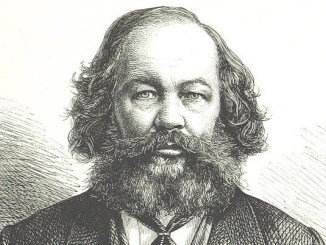 and author, who once said that “the desire of destruction is also a creative desire.” Active in the 1848 Paris events, in the 1st International in opposition to Marx and in various uprisings around the world. At the stock market building of Zürich in 1853 he wrote graffiti that says, in translation: No God, No State, No Slave!
and author, who once said that “the desire of destruction is also a creative desire.” Active in the 1848 Paris events, in the 1st International in opposition to Marx and in various uprisings around the world. At the stock market building of Zürich in 1853 he wrote graffiti that says, in translation: No God, No State, No Slave!
Bama (TTP) Also wrote AMRL, legendary old school writer from N.Y, member of the original> UGA and one of> Craig Castleman ́s main sources in his book “Getting up”.
Bambaataa, Africa (TTP) Real name Bambaataa Kahyan Aasim, * 1957, Bronx, N.Y. DJ who initiated the> hip hop movement with the groups “The Zulus” 1973 and “The Zulu Nation” 1975 with breakdance, rapping, DJ:ing and later on graffiti becoming an alternative to drugs, violence and racism – indeed a historic achievement. The term ”hip hop” was invented by DJ Starsky.

Bando (TTP) Starting up with the famous > Dondi White in N.Y., this French-American painter founded the French crew> TCA (The Chrome Angelz) in Paris 1987 together with Mode 2, Pride, Zaki and Scribla . Bando in Paris and> Shoe in Amsterdam were the two real letter style innovators in Europe. Bando still holds his reputation as a Style King and has had an enormous influence on European TTP, as have all of the TCA members. His crew now is>CTK with Boxer. Lit.: A moment with Bando. (Outlines & Interview in English/Francais.) Molotov Cocktail nr 5, Paris 1998, p.14-17.

Banksy (SA) active since the 1990s, is an English-based graffiti artist, political activist and film director whose real identity is unknown. His satirical street art and subversive epigrams combine dark humour with graffiti executed in a distinctive stenciling technique. His works of political and social commentary have been featured on streets, walls, and bridges of cities throughout the world. Born 1974 and emerging from the 1990:s Bristol anarchism, graffiti and music culture he is considered a genius and the no 1 contemporary artist, but he also holds a clear and critical distance to the Artworld and the commercial art business: he is no sell-out. The Artworld, on the other hand, loves him. See also: 3D, Goldie, Street Art. https://en.wikipedia.org/wiki/List_of_works_by_Banksy
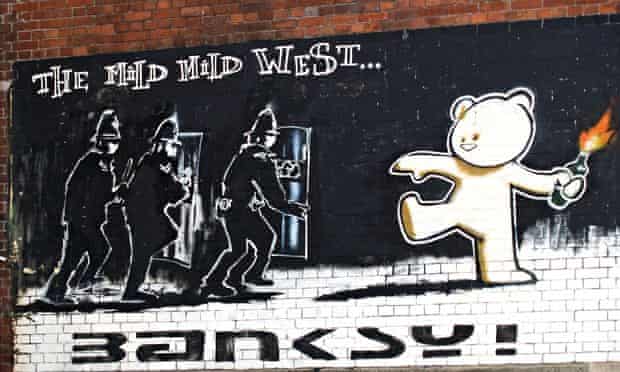
Barbara 62 and Eva 62 (TTP) Early female incredibly active taggers in the 1970s who, according to> Bama, wrote their names on every single bus stop on the New York-Florida line.
Barks, Carl * 1901, the American cartoonist who created Donald Duck and his friends and the classic adventures in the 1950s. Barks became known after he retired in 1966, and was allowed (!) by the company to use his own name. The influence of Barks in early TTP characters is sometimes obvious. One west coast writers name is Dizney.
Bars (TTP) Rectangular elements used for instance in the “camouflage” technique introduced by >Kase 2 when sketching a wild style outline. The bars are integrated with the letter shape, and the aim is to confuse the eye and split up the letter body, which makes it harder to read but nicer to look at.
Basquiat, Jean-Michel (TTP) (1960-1988) Born in Brooklyn to a father from  Haiti and a mother from Puerto Rico. He did some early illegal pieces. Writing “Samo” on SoHo walls 1978-80,working for Mary Boone ́s Gallery from 1982, cooperating with Andy Warhol from 1984. Basquiat did not see himself as a graffiti writer but, although self trained, as a fine arts painter like > Keith Haring and > Kenny Scharf, moving in the New Wave and graffiti-influenced circles in Lower East, East Village and SoHo in New York. His acrylic paintings on canvas contain neo-expressionistic scribbled figures and crossed-over sentences with bright colours, often with ethnic references, and they quickly brought him an international reputation. His alltooshort existence (27 years) became the subject for a film by Julian Schnabel, where David Bowie also brilliantly played Andy Warhol. See also > Penck, A.R. Lit.: Liu, Catherine: The Umbilicus of Limbo. Flash Art 134, May 1987, p. 93. ; DK: Jean-Michel Basquiat. Artforum, March 1989, p. 130-131. ; Hoban, Phoebe: Basquiat. A quick killing in Art. Quartet Books, London 1998.
Haiti and a mother from Puerto Rico. He did some early illegal pieces. Writing “Samo” on SoHo walls 1978-80,working for Mary Boone ́s Gallery from 1982, cooperating with Andy Warhol from 1984. Basquiat did not see himself as a graffiti writer but, although self trained, as a fine arts painter like > Keith Haring and > Kenny Scharf, moving in the New Wave and graffiti-influenced circles in Lower East, East Village and SoHo in New York. His acrylic paintings on canvas contain neo-expressionistic scribbled figures and crossed-over sentences with bright colours, often with ethnic references, and they quickly brought him an international reputation. His alltooshort existence (27 years) became the subject for a film by Julian Schnabel, where David Bowie also brilliantly played Andy Warhol. See also > Penck, A.R. Lit.: Liu, Catherine: The Umbilicus of Limbo. Flash Art 134, May 1987, p. 93. ; DK: Jean-Michel Basquiat. Artforum, March 1989, p. 130-131. ; Hoban, Phoebe: Basquiat. A quick killing in Art. Quartet Books, London 1998.

Bates (TTP) Danish writer, one of the most skilled and active for several years, took his name from a character in the SF-series “V” and is one of the best writers of the entire period since TTP first came to Denmark in 1984. Member of AiO, WR, WCA and STEM crews. In his œvre art and life are one. His pieces always contain his name, and his style is very physical with horizontal stretched-out flourishes. Below a piece done in Los Angeles, courtesy Bates.
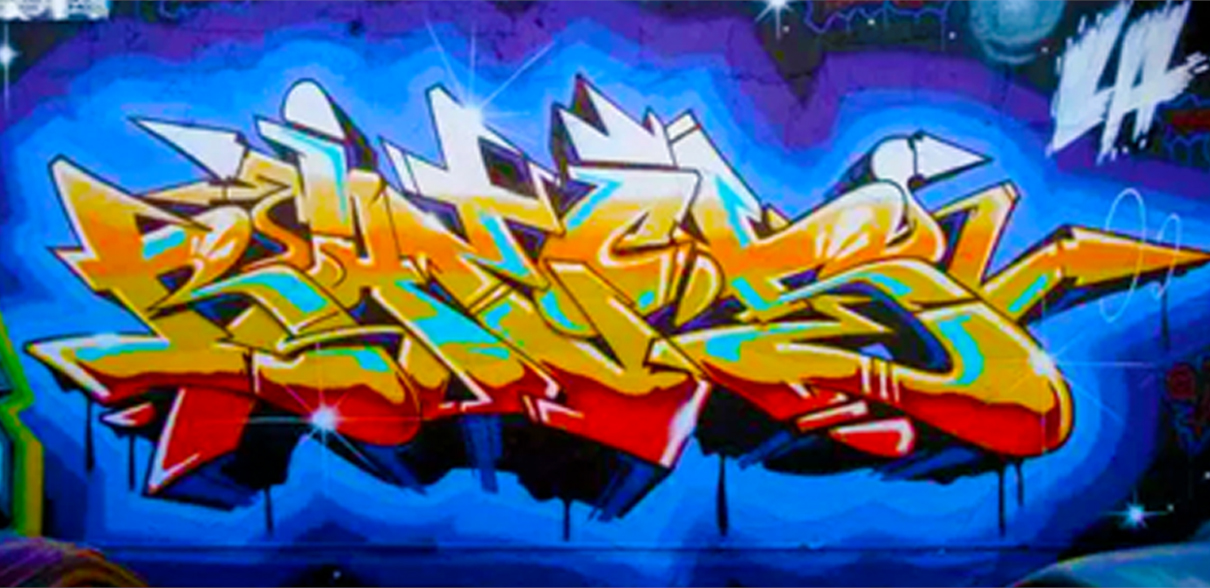
Battle (TTP) A battle is an aesthetic competition used to solve conflicts between hip hop groups or individuals. The antagonists show their best and the spectators are the judge and jury. Some of the battling rules are said to been taken from basketball.> Africa Bambaataa used this method to cool off the aroused feelings in the streets, as a basic of the> Zulu Nation ideology with its “anti-violence, anti-drug, anti-racism” concept. It did work and is still in practice now and then, as for instance the CDC-HTS crew battle in Stockholm 1988 and the> Hex and Slick individual battle in Los Angeles 1989.
BBC (TTP) Bad Boys Crew: French-German group with Jonone 156, Skki, Jay, Ash II, which combine hardcore painting and canvas work. Except several major exhibitions they have also done pieces on the Berlin Wall, for TV and in movies. Lit.: Nabi, Adrian: Ash Jay One Skki / BBC. Wanderer Werbedruck, Bad Münder 1991.; and Bad Boys Crew. Underground Productions 4/feb 1993, p.14. (Interview with BBC.)
B-boy (TTP) 1) A member of the hip hop culture.
2) “The B-boy”-character is a highly stylised drawing of a “typical” grim looking type with the outfit, the spraycan, making the hiphop sign.
BCP (TTP) The Belgian crew Brussel City Painters with Eros, the latter known for enormous straight- letter pieces.
Bear 167 (Kwame Monroe) Old school N.Y. writer and artist, mentor of > Shoe, Amsterdam.
Beat Street (TTP) Film by Stan Lathan and Harry Belafonte. Orion Pictures, 1984, 106 min. The film was viewed the same year all over Europe and was one of the kickoffs for > hiphop culture there.
Berlin scene (TTP) If Philadelphia was the graffiti capitol of the 1960s, New York of the 1970s and Amsterdam / Paris of the 1980:s, then Berlin certainly is the graffiti capitol of the 1990s with its 10 000 writers (including the toys), the 24 hour rolling train gallery of pieces and the tagging of every (im)possible spot in the city. But, they have good writers in München, too. Lit.: Henkel/Domentat/Westhoff: Spray City. Graffiti in Berlin. Schwartzkopf, Berlin 1994; Jacobson, Staffan: Breaking the Wall – real Art is Free. Underground Productions nr 15, p. 33. Gold spray picture below by Sheas, Park, Loomit and the Sao Paolo writers >Os Gemeos at Mauerpark Hall of Fame, Berlin.

Berlin Wall, the (TG) was erected between West and East Berlin in Germany on August 15, 1961; 4.5 metres high and 166 kilometres long, “an anti-fascist bulwark” as it was said from the DDR side, and it would last for 28 years, 2 months and six days. Sporadic political graffiti was the most usual decoration of the wall during the 1970:s, but in the 80:s the wall become completely covered up by a democratic folkloristic mixture of all kinds of art, including > Harald Naegeli (the Zürich Sprayer), > Keith Haring, stencil art, slogans, > brigade paintings done with brushes and, from 1984, tags, throw- ups and pieces done with spraypaint and style. The peak was reached in 1986. In November 9, 1989 the wall was opened, torn down and kept or sold in small pieces as souvenirs, while the unification of Germany and the end of the Cold War was at hand. Lit.:Waldenburg, Hermann: The Berlin Wall Book. Thames& Hudson, London 1990 (colour plates) and Hebell, Claus: “Conditio Humana. Die Berliner Mauer als spruchband.” Kultur nr 8, 1984, p. 31-34. ( Registration of all messages written at the Berlin Wall at a particular time in 1983.) Below (over): Berlin Wall, West Side, 1986 executed without spraypant. Photo courtesy Noir/Wikimedia Commons. (Under): the spaypainted West Side Gallery today, the only remained part of The Wall (Wikmedia Commons).
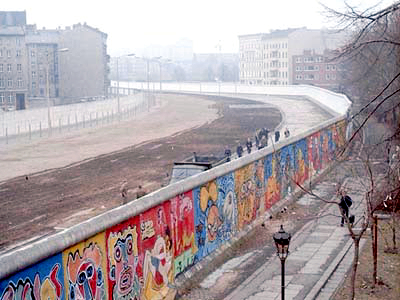

Betty Blue (TTP), (SA) later ”Blue”, (Karolina Falkholt) Swedish female writer who took her name from
 the well known movie; a good stylist who does not hesitate to do risky things. Carolina Falkholt (Blue) has painted with Lady Pink and now have an international career, focusing on feminist subjects, female and male organs and beutiful grid forms in her pieces. (Images courtesy Blue).
the well known movie; a good stylist who does not hesitate to do risky things. Carolina Falkholt (Blue) has painted with Lady Pink and now have an international career, focusing on feminist subjects, female and male organs and beutiful grid forms in her pieces. (Images courtesy Blue).

Bil Blast (TTP) (William Cordero)* 1964. High School of Art & Design 1981, Parsons School of design 1984, since 1986 working as artist for Joan of Arc Junior High School in New York. American writer, known for the piece “Sky ́s the limit”, N.Y 1982, who has had many successful exhibitions in the USA and Europe.
Bite (TTP) Writer ́s name for plagiarism, to take another writer’s style or letter shape without giving proper credit to the inventor.
Bits (TTP) Writer ́s name for tiny decorative elements in a piece like small sticks, not to be confused with> bars.
Black-book (TTP) Originally this is the name of the writer ́s sketch-book, where the outlines were elaborated and where other writer friends could leave their tag. But it can also contain the writer ́s photos, used as a portfolio.
Blade (TTP) (Steven Ogburn) *1958. Legendary old-school writer from N.Y., who was the first to use “tumbling letters” in pieces and had an active role in the stylistic development of the art form. Also does very specific personly canvas work. He claims 5000 train paintings with photografic evidence. Website: http://www.bladekingofgraf.com/ Below: Canvas work.

Blek le Rat (SA) *1951 in Paris, art educated pioneer in stencil-graffiti/pochoir from 1981 and forward, with many followers. Below: ”Last Tango in Paris”.
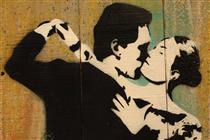
Blending colours (TTP) Spray paint can be blended by a writer-invented technique (Poulsen 1997). Except for the> fading technique, there was no way of mixing spray paint to get the right colour before. First you put can no 1 in the refrigerator for 1 hour. Then you take it out and turn it upside down, holding it over can no 2. Take off the caps on both cans. Between the cans you carefully install a thin tube which fits into the spray tube ́s openings. The industrial spray cans has the kind of tube you need to connect the two spray cans, but a cut-off empty ball-point pen ́s tube is O.K. Be careful.Watch out so you don ́t over-pressure and explode the can! Now the paint goes from one can to the other and the paint is blended! Lit.:Poulsen, Rasmus: Graffiti i Danmark. Klematis, Denmark 1997, p. 59-60.
Blind (TTP) Stockholm writer who contributed to the Swedish stylistic evolution with certain decorative stencil patterns details in the piece. As an intellectual he has contributed to the concept of this movement.

Bristle (TG) Bristol, UK (Banksys hometown) also have lots of political graffiti, displayed in the 2005 photo compilation book ”Bristle. Political Street Expression In Bristol and South West, 1998-2005”.
Blindheim, Martin (TG) orwegian art historian who has described the mediaeval graffiti scratched with knife in wood, both pictorial and signs, by those who built the Norwegian stave churches.He shows the similarity between the exterior decorations of the churches and the scratchings – they seem to have been executed in spare time by the workers who built and decorated the church. Below: scratchings from Gol Stave church, Norway. Lit.: Blindheim, Martin: Graffiti in Norwegian Stave Churches c. 1150-1350. Universitetsforlaget, Oslo 1985.
Bode ̄, Vaughn (1941-1975) This American underground cartoonist created  figures like Cheech Wizard and SF worlds like Sunpot and Deadbone, and he had an intense career, resulting in numerous drawings, major awards (such as the HUGO) and a multimedia performance at The Louvres, Paris. The bizarre and eccentric humour and the elegant sketch work with “cute” round letter shaping in his art made him the No 1 comic artist for the writers, and his comics are still reprinted. His son Mark Bode ̄ makes graffiti and other art works, and he has a his own tattoo studio. He continues the work Vaughn Bode ̄ started by finishing the ”Wizard of Oz”, a new Cheek Wizard book forthcoming. Lit.: Newport News 1976. Vaughn Bode ̄ Index 1976. http://www.cheechwizard.com and http://www.markbode.com.
figures like Cheech Wizard and SF worlds like Sunpot and Deadbone, and he had an intense career, resulting in numerous drawings, major awards (such as the HUGO) and a multimedia performance at The Louvres, Paris. The bizarre and eccentric humour and the elegant sketch work with “cute” round letter shaping in his art made him the No 1 comic artist for the writers, and his comics are still reprinted. His son Mark Bode ̄ makes graffiti and other art works, and he has a his own tattoo studio. He continues the work Vaughn Bode ̄ started by finishing the ”Wizard of Oz”, a new Cheek Wizard book forthcoming. Lit.: Newport News 1976. Vaughn Bode ̄ Index 1976. http://www.cheechwizard.com and http://www.markbode.com.
Bomb (TTP) To tag or do quick pieces in quantity.
Bomber Magazine (TTP) The first regular Dutch TTP fanzine, founded in Abhilvrenbeek, The Netherlands 1988.
Mode 2
Bombing L.A. (TTP) s the title of a documentary on video made by Gary Glaser, Glaser Productions, Beverly Hills, California 1989.
Boone, Daniel (TG) (1734-1820) American pioneer, founder of the first permanent settlement in Kentucky, Boonesborough. In Tennessee a scratching in a beech tree by knife still remains, saying (in erratic spelling) that Daniel Boone killed a bear on that spot in 1775. It also appears in the movie ”Sergeant York” from 1941 with Gary Cooper ; director Howard Hawks.
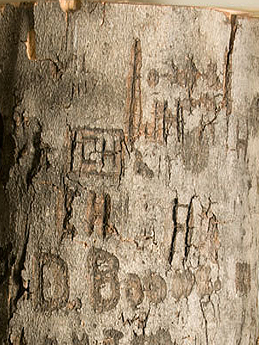
Bosius, Antonius (TG) (1575-1629) was the first to do serious research on graffiti. His 656-pages folio book Roma sotterranea….nella quale si tratta de sacri cimeterii di Roma, del sito, forma et uso antico di essi, de cubicoli, oratorii, imagini ieroglifici, iscrittioni et epitaffi…. Rome 1593, published 1632 after his death, has lots of illustrations of inscriptions and of maps of the secret underground > catacombs in Rome, once a meeting place for the first Christians. Bosius also left his own “tag” in the Priscilla Catacomb, see below.

Bostons Graffiti Board (TG) was erected in 1971 as a follower of the first of its kind in Stockholm, March 16 1968, but “it just didn ́t work”. A graffiti board is a legal wall for scribbles. Bratly, Carol: Bostons Graffiti Board. The American City, Apr 1971, p. 138,140.
Boxer (TTP) Apparently Paris ́most frequent tagger, he is part of the French crew Crime Time Kings together with Bando, Senz, Sign and Squat. See also> Mode 2.
Brain (TTP) Swedish writer known for good self-confidence and commercial success with canvas work.
Brassai (TG) Real name Guyla Halasz, 1899-1984 Hungarian-French painter  and photographer, friend of Dali, Braque and Picasso; the latter encouraged him to photograph graffiti scratchings on Paris house fronts 1932-38. His book “Zwei Gespräche mit Picasso” (1960, in French 1961) contains those pictures and a conversation on the subject between the two of them. Brassai ́s photos were shown at MoMA, N.Y. 1956-57. See also> Picasso. Lit.:Brassai (Guyla Halasz): Du mur des cavernes au mur d’usine. Minotaure 3/4, Paris 1933, p. 6-7. and Brassai (Guyla Halasz): Conversations avec Picasso. Gallimard, Paris 1964.
and photographer, friend of Dali, Braque and Picasso; the latter encouraged him to photograph graffiti scratchings on Paris house fronts 1932-38. His book “Zwei Gespräche mit Picasso” (1960, in French 1961) contains those pictures and a conversation on the subject between the two of them. Brassai ́s photos were shown at MoMA, N.Y. 1956-57. See also> Picasso. Lit.:Brassai (Guyla Halasz): Du mur des cavernes au mur d’usine. Minotaure 3/4, Paris 1933, p. 6-7. and Brassai (Guyla Halasz): Conversations avec Picasso. Gallimard, Paris 1964.
Breakdance Breakdance (or B-boying) is an acrobatic street dance, originated by teenagers in the Bronx in the mid-1970:s. It has influences from so diverse sources as Brazil dances, mimers and James Brown and has been elaborated since then, forming a part of the hip hop culture together with rapping, scratching, mixing, DJ-ing and graffiti. One of the legendary break dancers is Crazy Legs of the Rock Steady Crew. Break dancing came to Europe c:a 1983, along with the film> Beat Street and TTP-graffiti about a year later. See also> hip hop.
Brewer, Devon (TTP) American sociologist who in a couple of studies analysed the strategies and effects of common graffiti prevention, as chemical-technical / punishment by the law – and of alternative methods, like graffiti community centres / legal walls, and compared them. The result was positive for alternative methods. Lit.:Brewer, Devon: “Bombing and Burning. The Social Organisation and Values of Hip Hop Graffiti Writers.” Deviant Behaviour 11/1990, p. 345-369. and Brewer, Devon: “Hip Hop Graffiti Writers Evaluations of Strategies to Control Illegal Graffiti.” Human Organisation, Vol 51, No 2, 1992. p. 188-196.
Bricollage This term originates from the French structuralist Claude Levi-Strauss and has been used in youth research for some years; it means a counter definition of symbolic meanings or a re-arrangement of symbols in a way that they constitute a new totality. One example is the youth fashion of certain subcultures, and another could in some senses be the spray-painted picture, bringing together familiar but diverse elements to create a new visual concept with a new meaning ´cause there is meaning!
Brigada Ramona Parra (SA) This was the first illegal painters’ > brigade in Chile. The leader was Danilo Bahamondes, and one of its most famous paintings was a 500 x 4 meter stylised political mural at the Mapacho wall in 1972.
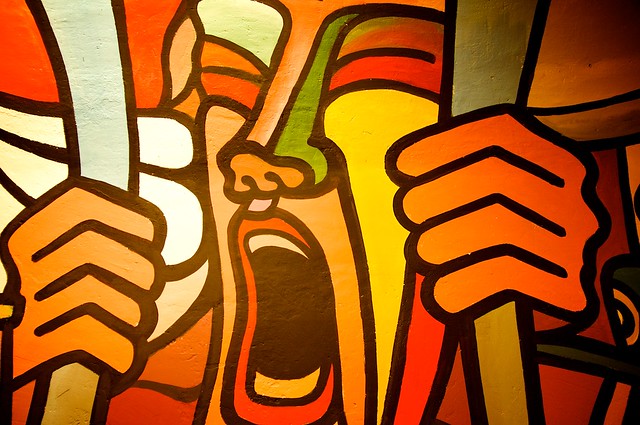
Brigade paintings (SA) A painters ́ brigade is a group of political activists, artists and amateurs, aiming to do a political wall painting, mostly done with social realism characters and slogans, executed illegally, protected with guards , done with brushes. This public art form was blossoming from the late 1960:s (like > The Wall of Respect in Chicago, 1967) to the latter part of 1970:s (like the painting on Hornsgatan, Stockholm 1979) with roots in> Mexican muralismo and Cuban posters It was brought to Europe by refugees from Chile after the coup against president Allende in 1973. Brigade paintings also played a crucial roll in the Nicaraguan and Portuguese revolutions. Legal forms close to this are ”neighbourhood murals” supported by community workshops and > commercial murals, done by artists. See also > Street Art. Below: Höken, Stockholm 1978 (left) Smålands nation, Lund 1995 (right).


Broke (TTP) Australian writer known for his characters and for running the > Hype Magazine (Brisbane, Australia 1988 – ) with his twin brother Seiz.
Bronx (TTP) The first major population to settle down in the area between Harlem River and Bronx River was the Irish, who came in many thousands because of the big potato plague in Ireland 1840. 1860 they were 25% of the total white population in New York. The population grew during the railroad expansion, and 1910 there were four ethnic close bound groups in Bronx: Jews, Irish, Italian and German. The great inhabitant reconstruction of the 50s and the regression which followed is still a trauma for the Bronx, now an area for poor working class people. Robert Moses cut the neighbourhood in two pieces with the Cross-Bronx Expressway in the early 60s, and the white population left South Bronx for the north. 170 000 more black and Puerto Ricans came when their Harlem ghettos were torn down. This was the situation in the 1970s: a 25 square kilometre slum, where buildings were burned instead of rebuilt, in hope of insurance money. As if things could not get much worse, the gang violence increased. And now, as a counter reaction, there are several remarcable events coming up: the graffiti boom was created here and in the close north Manhattan neighbourhood Washington Heights. And the Bronx DJ >Africa Bambaataa organised his first group The Zulus in 1973. His message was anti-drug, anti-racism, anti-violence, and the creative forces of the young were triumphing over the gang destructiveness. In 1975 there were rapping, break dance and DJ:ing coming out of the South Bronx street culture, and together with graffiti a new and very vital movement was reclaiming the streets and getting ready to conquer the world: Hiphop. Lit.: Jacobson, Josef: När bokstäverna lärde sig att dansa. Paper, KM, Malmö Hogskola, Malmö 2001; Handlin, Oscar : The Newcomers -Negroes and Puerto Ricans in a Changing Metropolis. Harvard University Press, Cambridge, Mass., 1959, p. 134; The Encyclopaedia of New York, p.145.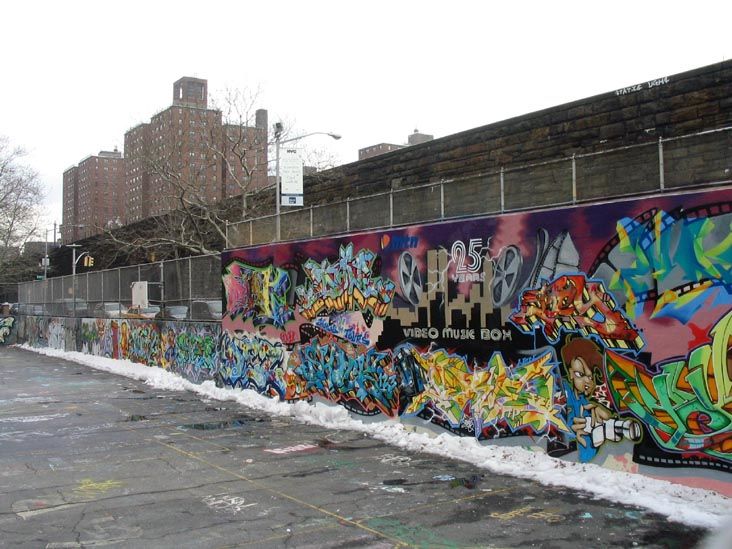
Bubble letters, ”softies” (TTP) This letter type, first seen on the LP-cover of  Beatles “Rubber Soul” 1965 and then in underground comics, was introduced and elaborated in TTP by> Phase II, in N.Y. in the early 1970:s. Lit.: Hager, Steven: The Cultural Origins of Graffiti. In: Coming from the Subway – New York Graffiti Art. Groninger Museum, Groningen Oct 4 1992 – Jan 10 1993.
Beatles “Rubber Soul” 1965 and then in underground comics, was introduced and elaborated in TTP by> Phase II, in N.Y. in the early 1970:s. Lit.: Hager, Steven: The Cultural Origins of Graffiti. In: Coming from the Subway – New York Graffiti Art. Groninger Museum, Groningen Oct 4 1992 – Jan 10 1993.
Buff (TTP) The “buff” originally was the writers’ name for the chemical graffiti-removal subway-car wash which was introduced by the MTA in New York, March 1977. It caused health and environmental problems and was later replaced with other methods. Now the the term ”buff” is used to describe the removal or painting-out of graffiti on any surface. Litt: Haitch, Richard: “Subway Graffiti.“ The New York Times, Sunday, March 20, 1977, p. 45.(”…a new automatic’graffiti wash’- – – for subway cars”).
Burn, burner (TTP) To burn is to beat other writers in style, and the result is a burner – the best piece of its kind, original, fresh colours and excellent in all ways. Lke in Puppets piece ”‘I’ll burn ya all!”
Burning desire : Art of the Spraycan (TTP) was the name of an exhibition by Hex, Slick and Mandoe, held at the Mexican Museum in San Francisco 1991.
Bushnell, John: (TG) Bushnell described the Russian traditional > football-graffiti with all these supporter-symbols and gangs in the book “ Moscow Graffiti. Language and subculture.” Unwin Hyman Ltd, London 1990.
Button graffiti (TG) Are the messages on buttons, pins and badges, blossoming since the late 60s, really graffiti? Maybe not by their commodity appearance, but sometimes by their content: humoristic slogans and political symbols. In a way, this is the TG counterpart to the gallery art phenomena in TTP. Lit.: Reisner, Robert: Great Wall Writing and Button Graffiti. Conyon, N.Y. 1967. Below: the authors collection.

Byron, Lord (TG) George Gordon Byron, Lord 1798, was one of the most famous poets of English and world literature (1788-1824), known e.g. for “Don Juan” 1819. He went to Greece to join the liberation war 1823 and wrote the graffiti “Byron” on the Temple of Poseidon, Cape Sounion, which still remains.
BZ-graffiti (TG) The militant German and Danish squatter movement, with roots in the West Berlin ́s Kreuzberg alternative movement of the 1970s, used to paint related symbols such as the >anarchist-A inscribed in a circle and as in the illustration below, a z-arrow inscribed in a circle, on liberated empty buildings in the 1980s and later. This practice was then widely spread to other European cities with squatters.

BZK (TTP) Stands for the wellknown contemporary Spanish crew Barcelona Zombie Killers.
Caine (TTP) as one of the famous writers in N.Y. together with Mad 103 and Flame One who did the first whole-train ever, 11 whole-cars, the so called Freedom Train in July 4, 1976, in the number 7 yard. This historic event has till this day not been beaten; it is an all time record. An interesting statement by Caine titled “Preface” written in the mid-1970:s, is reprinted in Jack Stewart (1989) p.xxvi, Introduction.
Calligraphy From Greek kallos (beautiful) and grafein (writing).
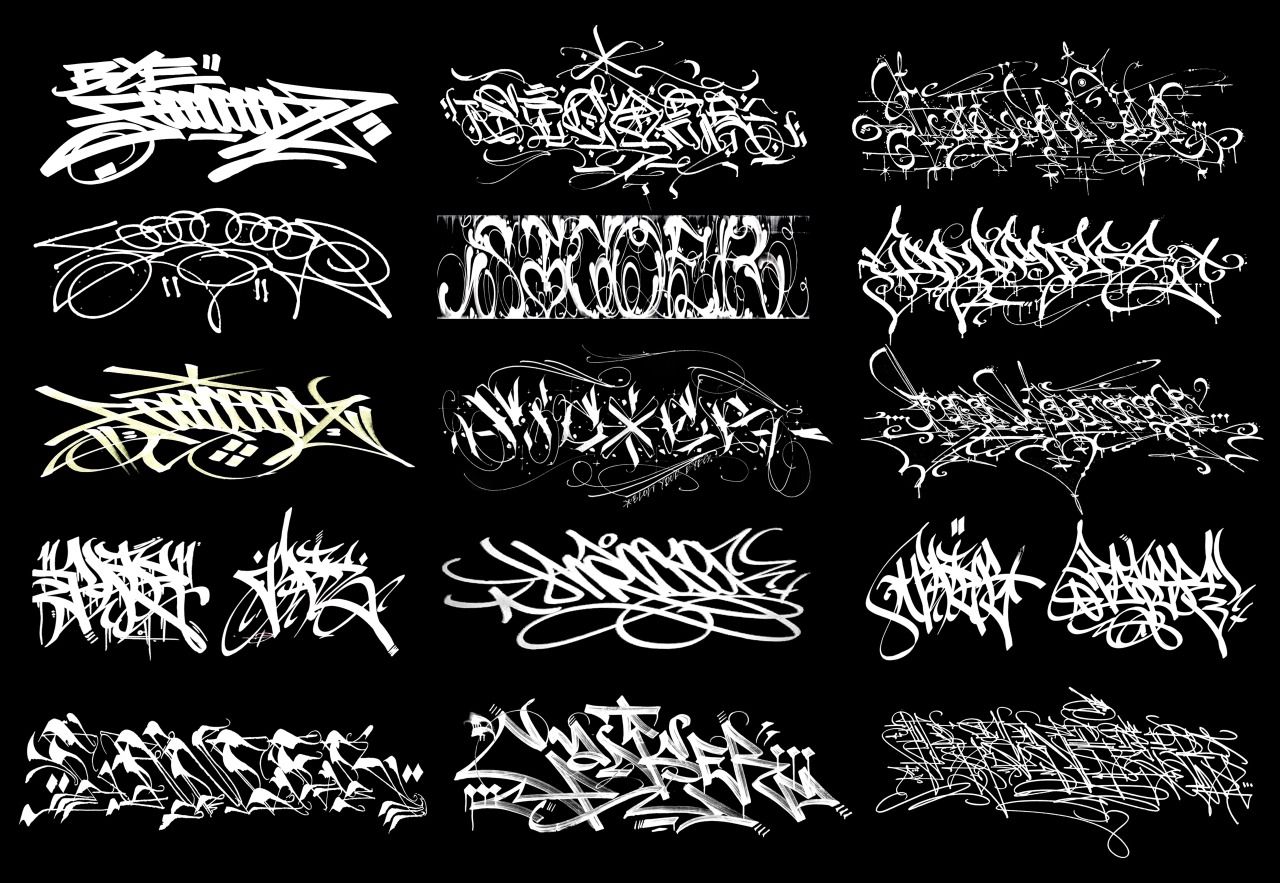
1) European. Calligraphy was important in medieval book-painting and illuminated manuscripts, and executed by monks in the scriptorium at monasteries. Many famous hand-written Bibles remain, as the Book of Kells, the Book of Durham and the Lindisfarne Gospels. Despite the different ductus of each writer, the letter types are more or less conform. But in the initials any kind of experiment seems to have been accepted, and those are beautiful, with complicated ornaments, knot-works and pictures within the single capital letter. The art of printing books wiped out the specialist of fine handwriting. Modern calligraphy often belongs to book design and advertisement, and has a free form in comparison to the traditional. But as an art form it was hardly accepted, even though there are such virtuous calligraphers as Edward Johnstone. Lit.: Johnstone, Edward: Writing & Illuminating & Lettering.Pitman & Sons Ltd, London 1927.
2) Asian. In China, Japan, Korea, Vietnam and other Asian countries calligraphy has been seen for many thousands of years as a separate art form, with strict rules and sometimes requiring a life-long training. There are, for example, 8 basic ways to paint a point and 32 basic ways of how to paint a line(!). Zen calligraphy could in some senses be compared to tachism and expressionism in modern art. The development of the ball point pen, the typewriter and the computer has not broken the tradition of Chinese calligraphy. Lit.:Chang, Léon Long-Yien / Miller, Peter: Four Thousand Years of Chinese Calligraphy. Univ. of Chicago Press, Chicago 1990.
3) Islamic calligraphy had a dominant place in Islamic art partly because of the iconoclasm. It has been used as decorative elements, as paintings, drawings,in textiles and daily goods and in architecture. Poets write of the beauty of the single sign, and especially in the kufic script there is ornamentation within the letter. “The name of God offered infinite possibilities to artists, who would fill in the space between the to ‘lam ’ (ll) with knots, flowers, stars and other designs. ”The tendency to embellish the name of God—” says Schimmel, Annemarie, in Calligraphy and Islamic Culture. I B Tauris & Co Ltd, London 1990, p.9. And there is a clear calligraphic quality in the TTP art form, as for example illustrated by >Rammellzee (below).

Camel Brands (TG) and Graffiti from Iraq, Syria, Jordan, Iran and Arabia. Supplement [to the] Journal of the American Oriental Society, Nr 15, Oct-Dec 1952. was written by Henry Field. Besides the summary of oriental graffiti he also discusses early graffiti as a possible forerunner to the earliest written script.
Camouflage > see Bars
Can (TTP) History. The spray can. That is, a can filled with paint, pressure packed with gas where the paint is let out of a tube up to the ventilator and comes out as a mist, “aerosol”, from the nozzle, is said (according to Tulissio 1986) to have been invented in 1947. However, in Backjumps magazine nr 14 Norwegian writers presented a sketch of the original spraycan done by the Norwegian engineer Eric Rotheim in 1930, and they claim his first patent is dated in October 8, 1926. This is confirmed by an article in Illustrerad Vetenskap, nr 5/2001, p. 80, with a photo from the Smithsonians collections (below, left).
The industrial production (we are not talking about sprayguns) must have come later. An early variant was used during the US jungle wars in 2nd WW for combating insects, but it was also used for products by the paint industry. 1949 Rustoleum had two colours on the market: black and white. In the 1970:s there were 2.800 different colours to choose from, and in 1973 were 5,9 billion spray cans produced – 65% for cosmetics. Since 1979 there has been no freon gas in the can, so that spray painting could not harm the ozone-layer. There has also been some attempt to use less toxic acrylic colour in spray cans. Recent developments of the can has been made by > Mice, Sweden. Lit.: Tulissio, David: The Triumph of the Spraycan School. MA thesis, Philadelphia 1986. P. 19, footnote 27. Nabi, Adrian (ed.): Backjumps. Nr
Berlin, Germany. P. 3. Norrman satte burken under tryck. Illustrerad Vetenskap, nr 5/2001, p. 80. See also> Cap and> Technique. Below: (left): 1:st spraycan; (right) some contemporary Krylon spraycans purchased in Canal Str, N.Y., by the author and then imported to Europe. Very smooth and opaque brand in my opinion.


Can Control (TTP) Fanzine in full colour edited by Power since 1990; the follow up of Ghetto Art which was published 1987-89. After a 2 years delay Can Control published a 2001 issue.
Canvas (TTP) is synonym for a piece on canvas or Masonite, that is, a painting executed to a gallery exhibition and for sale. Other materials and methods beyond spray paint are used, and the motif is often a “free-style” which does not necessarily contains letters or characters, for example as in> Futura 2000 or> JonOne 156’s pictures. See also> Exhibitions.
Caos (Kaos) * Early 1970:s, Swedish writer with enormous fantasy and untraditional letter solutions. Started writing in a small town outside Stockholm in 1985. In an UP interview (Nr 5, 1993) he calculated that he had finished 300 train paintings including 50 whole-cars by himself. And many unfinished ones too, like the double whole-train (16 cars) which was about to be completed when interrupted by the guards. 1989 was a most productive year. In an electrical accident he was thrown several meters over the yard. He was unconscious for a while but woke up and continued painting. Unstoppable, one might say.
Cap (TTP) 1) The cap of a spray can means the nozzle. From other cans writers take nozzles which provide special qualities: Fat cap for wider spread, normal for normal and skinny cap for tiny lines. There are also other ones, like “gold cap” > Phantom cap and stencil tips.
2) ”Cap” was also the name of the marauder in “Stylewars”, who rapidly went over others ́ pieces with his own throw-up, which caused much anger. “Not the best but the most” was his motto.
Carlofon (TTP) is a brand of spray paint that is known in Europe for good quality and used for a thin outline.
Cars (TTP) Castleman counts 6 kinds of pieces on cars: Top-to-Bottom (T-2-B), End-to End (E-2-E), Panel piece, Window-down, Whole-car (T-2-B + E-2-E). Whole Train is a full set of whole-cars.
Case 2 ee > Kase 2
Caster (TTP) Swedish writer with a very twisted and complicated, good-looking letter style. He has always done something different than other writers, and in the 1990:s he contributed with a compact letter picture with drip-like flaps.

Castleman, Craig made the first sociology study on graffiti, “Getting Up” in 1982. It is descriptive and precise , “writing on graffiti without writing over it” as B. Serious says in an review. The structure of the crews , writers’ techniques and the authorities combating are well documented. The story of Lee, The Fabulous Five and the Christmas Train is a classic. This thesis gives lots of inside information, but as Louis Forsdale is quoted in the foreword it is more asking “how” than “why”. One of the most valuable sources of this field. Lit.:Castleman, Craig: Getting Up. Subway Graffiti in New York. MIT Press, Cambridge, Mass. 1982, 3:rd ed. 1986.
Cat 22 (TTP) The former name for Pone, a Dutch writer in the very elite INC crew with Delta and others during the 1980s and 1990s. He has done lots of hardcore graffiti as well as commissions, and has a great talent for controlling the colours. Below: window down Pone at Amsterdam subway.
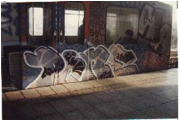
Cat 87 (TTP) Old school writer from N.Y., one of the original members of UGA in the early 1970:s.
Catacombs (TG) The catacombs of Rome were built as an underground cemetery during the 1:st and 2:nd century A.D. The different catacombs were dig out 20 metres under ground with a length up to 12 kilometres and had Roman, Christian and Jewish departments. The early Christians are said to have hidding there from the Roman persecution during 65-195 A.D. but that is not for sure; what we know is that Christians met here at the funerals and left lots of graffiti, names, religious symbols and Bible quotations in the tunnels.
Below: ”Map over secret tunnels in the catacombs” by A. Bosius, Rome 1593 aa, p. 591b. See > Bosius, Antonius.

Cave paintings (TG) The bull and horses pictures known from Altamira, Lascaux and other places have no direct connection with traditional graffiti. It is well developed art of its time (40-20 000 B.C.), long before ”art” was a concept. But the graffiti tradition probably traces back to the simple signs for male and female, hand prints, hearts and so on in the paleolitic art. Those and similar signs have remained through history to present days with very few changes. The real origins of graffiti start with early ideographic scribblings, 5-3000 years ago in Egypt and above all in Ancient Greece and Rome with alphabetic letters. Graffiti became a widely spread daily life reflection phenomena, but the word is used first with 1800:s archeologist Raphael> Garrucchi. From then on there was no radical change in the subjects or the execution until the 2nd World War – and the great TTP revolution in the late 1960s! See: Graffiti och grottkonst (Swedish): https://anarchyisorder.wordpress.com/2012/07/25/graffiti-och-grottkonst/
Cay 161 (TTP) Old school tagger from N.Y.
CBS (TTP) Can ́t Be Stopped , contemporary crew in Los Angeles, USA.
CDC (TTP) Control Da City, late Finnish crew.
Code/Ruskig/Pärra Andreasson (TTP) was the headmaster on the > Graffiti School in Uppsala, where he made many innovations. Active writer for a very long time with a clean somewhat geometric style and portraits on walls. Below an antiracist graffiti mural decoration in Nybro, Sweden. ”Children (of different colors) plays best together”.
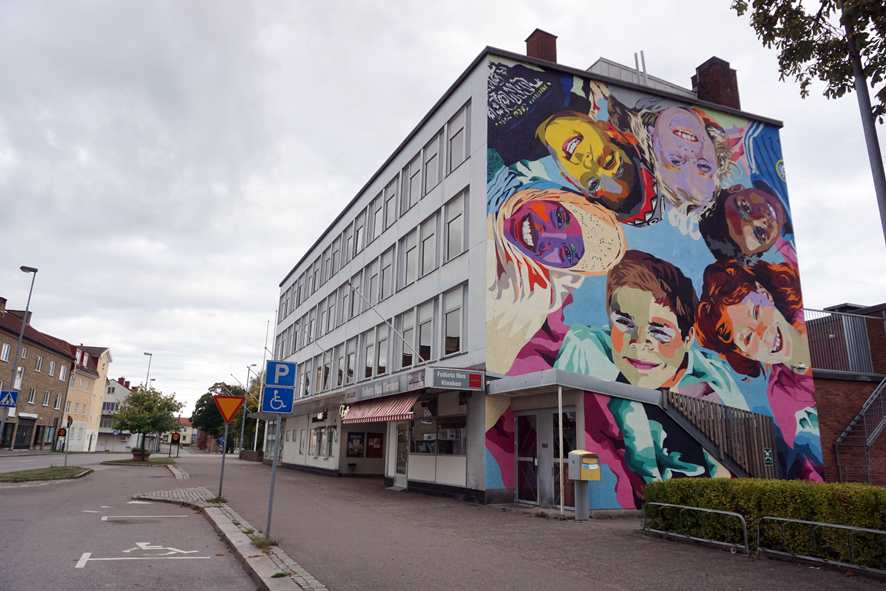
Cemnoz (TTP) German writer and artist with an extremely aggressive, pointed 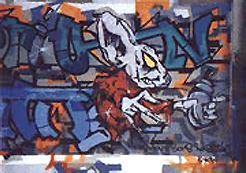 and hard-edged letter picture, very well worked out. Cemnoz wrote since 1987, as a member of the >FBI crew, and with Scum from 1989 as member of The Fantastic Partners. He is a very good 3D-stylist, and has also taken part in several exhibitions; see >Style Only Workgroup. Lit.:Van Treeck, Bernhard: Hall of Fame. Graffiti in Deutschland. Edition Aragon, Moers 1995. Unpag.
and hard-edged letter picture, very well worked out. Cemnoz wrote since 1987, as a member of the >FBI crew, and with Scum from 1989 as member of The Fantastic Partners. He is a very good 3D-stylist, and has also taken part in several exhibitions; see >Style Only Workgroup. Lit.:Van Treeck, Bernhard: Hall of Fame. Graffiti in Deutschland. Edition Aragon, Moers 1995. Unpag.
Chaka (TTP) (Daniel Ramos) Californian writer who was sentenced for having put his tag on up to 10.000 (as it was said, not everyone agrees) places between San Francisco and San Diego.
Chalfant, Henry Sculptor and photographer, co-author of the three works> Subway Art, with> Martha Cooper, > Spraycan Art, with> James Prigoff and the movie> Stylewars, with Tony Silver. Henry studied classical Greek at Stanford University, lived in Spain and Italy for some years and began carving in stone in the early 1970s in Manhattan. There he came to know the ”writers” and started photograph the whole-cars and pieces with his own technique. His studio became a meeting place for writers, and besides the books and the filming he had photografic exhibitions worldwide. In the 1990s Henry took up studying again while Martha released another book and James Prigoff continued the documentation, now with focus on murals.
Chalk drawings (TG) has been used mostly by children – who got the chalk in school – to outline rules of games on the pavement and for graffiti. One of the most attractive descriptions on this subject is Levitt, Helen: In the street. Chalk drawings and messages. New York City 1938-1948. Duke Univ. Press, N. Carolina 1987. (1:st ed.1965.) In 106 pages excellent b/w photos she shows childrens games, scribblings and drawings on streets, fences and walls in the 1930- and 40s of New York. See also Virianen, Leea: “The teasing tradition.” In: Childrens Lore. Studia Fennica, Review of Finnish Linguistics and Ethnology 22, Helsinki 1978. p. 59-71. (Graffiti related to childrens play.) Chalk drawings were also used by> Keith Haring, on the vacant advertisement boards in subway station entrances of New York.
Champions (TTP) is the title of an major exhibition at Tony Shafrazi Gallery , N.Y., in January 1983, with Futura 2000, J-M Basquiat, Keith Haring, Kenny Scharf, John Ahearn and others.
Characters (TTP) Simple decorations, symbols, stick-men and even profiles were there from the beginning of TTP. One of the very first writers to really use characters in the piece was Tracy 168.The figures were most often borrowed from Vaughn Bode ̃ or other comics in those days, and were seldom as well executed as the letters. But later they became more integrated: Lee`s “Doomsday Piece” in January 31, 1976 shows a complete visual environment for the first time. But the use of characters in TTP did not fully catch up with the letters until the 1980:s. The “B-Boy” was a very common and self-produced pictorial theme. First with> Mode 2 (Paris) could the self taught realistic character play an independent role, and with> Pike (Sweden),> Hex (Los Angeles),> Won (Germany) and others the characters for a few years in early 1990:s took over the dominant role in the picture. Since then, the importance of the letter in constituting the piece is once again on the rise. The pieces on> canvas with Futura 2000, Dondi, JonOne 156 and Ash are great examples that are usually more abstract and less letter-dominated than the ordinary, illegal pieces.
Charmin (TTP) Early female tagger in N.Y., known anecdotical for being the first to tag on the top of Statue of Liberty.
Chaz Bojorquez An artist in L.A. who has elevated the Chicano graffiti style to the level of fine art. His paintings are collected by the Smithsobian and other museums and his letter style is highly respected by the witers.
http://www.drunknmonkey.com/chaz.html
See also> Chicano graffiti.
Che 159 (TTP) Early Old school tagger in N.Y.
Chew 127 (TTP) Early Old school tagger in N.Y.
Chewy (TTP) Early tagger contemporary of > Cornbread in Philadelphia.
Chicano graffiti (TG) The gang graffiti on the American West coast among Mexican-Americans is sometimes called “Chicano-graffiti” or ”cholo” style.It had a characteristic, square edged calligraphy and sometimes also the protective message ”Con Safos”.The content of the plaqueasos or ”placas” centers on three kinds of messages: advertising self and friends, declaring romantic attachments, and claiming territory for gangs. 3 distinct styles were seen in the early 1970:s: Point letters: sweep to points at regular intervals, Block letters: 2- or 3-dimensional, Loop letters: rectangular letters which take on an exotic air from the systematic addition of a Loop curving around each letters stem. But this kind of graffiti did not develop further in North America; the TTP on the US West Coast style which came around in 1984 was brought there by media from New York. In South America, though, this ”placa” kind of graffiti developed into aerosol art in the late 1990:s, which is evident on the streets of Sao Paolo, where this special graffitiform ”pichacao”, cooperates as tags to the pieces of >Os Gemeos .
The Chicano Art (SA) is another original and more pictorial tradition, which differs from (but sometimes even incorporates) graffiti and comes closer to ethnic mural art. Spray paint is not the primary tool. According to Sidney Grahn, the breakthrough of this art came with the exhibition “Hispanic Art in America” 1988. Interesting names here are Carlos Almaraz (1941-1989), Gronk, Pattsi Valdez, Rupert Garcia. See also> Mexican muralismo. Lit.:Grider, Sylvia Ann: Con Safos. Mexican-Americans, Names and Graffiti. Journal of American Folklore, Vol 88, No 348, Apr/June 1975, p.132-142. and Romotsky, Jerry & Sally: California Street Scene: Wall Writing in L.A. Print, May 1974. On Chicano Art, see: Sommer, Robert: Peoples Art. AIA Journal, Dec 1972. p. 29-34. and his book with the same title. On Chicano murals, see: Simpson, Eve: Chicano Street Murals: A Sociological Perspective. Journal of Popular Culture, Nr 13, Spring 1980, p. 516-525.; and Bright & Bakewell: Looking high and low. Univ. of Arizona Press, Tucson 1995. ; and Sojin, Kim: Vital signs: Signage, Graffiti, Murals and “Sense of Place” in Los Angeles. UCLA, Los Angeles 1997. Picture below courtesy Widewalls.

Chicano Movimiento (SA) The Mexican American civil rights movement. It became strong during the 1960:s and 70:s. Its political ideology is called Chicanismo (Bright & Bakewell 1995).
Chico (TTP) For a long period of time Chico did numerous pieces in Lower East Side and Bowery in Manhattan, often with a message like “Crack Kills” but also decorative advertising commissions as for an animal-shop or for a theatre, but always neighbourhood based.
Chinese Theatre (TG) Outside the Chinese Theatre in Hollywood there is a Hall of Fame where movie stars make handprints and signatures in the wet concrete. Below: the author studying Shirley McLains’ marks.
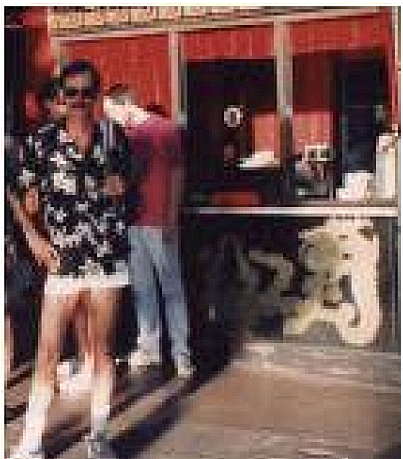
Chinese wall newspapers (TG) In 1957 information was announced on written papers set up on walls for collective criticism and self-criticism, and in the Cultural Revolution it became a type of public graffiti of great importance. TG are also used on the Chinese Wall. Lit.: Buchwald, Art: Peoples graffiti up against the wall. New York Post, Nov 30, 1978, p. 34. and Stewart, Jack: Subway Graffiti: An aesthetic study of  graffiti on the subway system of New York City, 1970-1978. New York University, N.Y. 1989, p. 35-38.
Chino Malo (TTP) Early Old school N.Y-writer with big rep, original member of> NOGA.
Christmas Train, the. see > X-mas Train
Chuck (TTP) (Charles Hargrove) American writer, known from a great number of canvas exhibitions and also movie performances.
Churches, graffiti in (TG) see > Pritchard
CIA (TTP) An extremely influential Dutch crew with >Shoe, Jaz and >Delta. Shoe was, (besides of > Bando) one of the two most important style innovators in Europe in the mid-80:s .The original 3-D style was invented by Pistol, Blade, Flint 707, Ernie a.o. in New York. Delta made a powerful comeback in the 1990:s with a brand new style called the “wrong 3-D”, with irrational three dimensional shades. >Daim worked further on this invention in the s.c. digital style. Below: Daim piece.
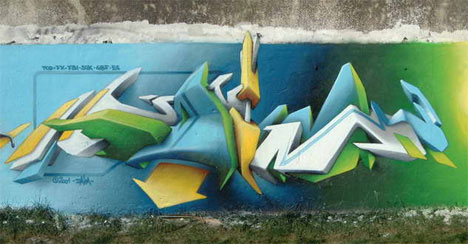
Circle (TTP) Swedish writer in the AiO (All in One) crew, known for a bold and clean letter style not unlike the Danish style. “Fascinate” 1989 is one of his greatest hits, and he has long done both whole-cars and art works. In recent years he successfully got into the » tattoo-business, doing Wildstyle » tattoos in his own company.

Classical American Graffiti Writers and High Graffiti Artists was an exhibition at Gallerie Thomas in Munich, Germany April 5 – June 2 1984 with A-One, Bear, Chuck, Crash, Daze, Dondi, Futura 2000, Lady Pink, Lee, Noc, Quik, Rammellzee, Seen and Toxic.
Clean One (TTP) Swedish writer from Lund, known for his very original letters and skilled portraits. A DJ-rhinoceros with rhinoceros style lettering – what about that? His technique is unbelievable. ”t’s a cost free art form, it’s people to people at eyes level”, he said once.
Cliff 179 Early N.Y-writer who did many whole-cars of varied quality. Original member of the» NOGA.
Co-Co 144 (TTP) Early old school writer from N.Y., member of the original» UGA Lit.: Ricklefs, Roger: Co-Co 144’s Underground Art School. Wall Street Journal, Apr 26/1973. p.40. COD (TTP) Children of Destruction, contemporary New York crew.
Code (TTP) Swedish writer from Uppsala, known for numerous pieces and artwork with elegant and crazy characters, former headmaster of the» Aerosol school, recently in Art school program.
Collectors (TTP) There are both private and public collectors of aerosol art on canvas such as Hubert and Dolores Neumann and Sam Esses in N.Y. who bought an early collection of top writers in the 1980s, Amsterdam dealer»Yaki Kornblit and museums like»The Museum of American Graffiti in N.Y. and Dutch museums including Boymans-van Beuningen,»Groninger Museum and the Krøller-Müller collection.
Coma (TTP) English contemporary writer, one of the best outside London.
Coming from the Subway – New York Graffiti Art (TTP) was a major exhibition at the Groninger Museum, Groningen in the Netherlands , Oct 4 1992 – Jan 10 1993. Curators were Frans Haks, Henk Pinjenburg and Poul ter Hofstede, and 18 major N.Y.-writers, among them A-One, Blade, Bill Blast, Dondi, Futura, Lee, Noc 167, Phase 2, Lady Pink, Quik, Rammellzee, Seen and Zephyr showed 75 canvases. A sample of rare blackbooks came from the» Museum of American Graffiti in N.Y. The exhibition was visited by more then 20 000 people, and the glossy 319 page catalogue included articles by Jack Stewart, Dr. Johannes Stahl, Steven Hager, Stefan Eins and others, together with full artist records and lots of illustrations. See also» Groninger Museum.
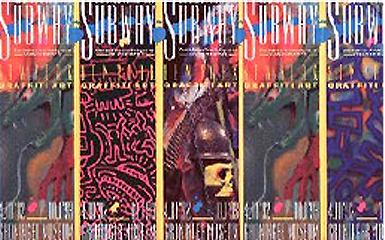
Commercial murals Besides the pure advertisement murals for different companies and products which have been around since the 1890s, there is a more interesting kind, developed by artists as public art . The murals often use the enormous scale for a massive trompe d’œil or optical illusion effect, and are worked out by dia-positive magnifying and brushwork high in the air, such as L.A. Fine Arts Squad ́s mural “Isle of California”, Elloy Torres classical star portraits “Legends of Hollywood” and Kent Twitchells’ enormous photo-realistic humans. East L.A. is the center of the late muralists movement, but it is rooted in the Mexican tradition, and there are lots of murals in major European cities too. Lit.:Kuzdas, Heinz J./ Nungesser, Michael: Mural Art. Berlin, Los Angeles, Mexico. Schwartzkopf Verlag, Berlin 1994. 100 p. Ill. and Levick/Young: The Big Picture. T&H, London 1988.
Community Center Workshop (TTP) The 1:st of its kind, in Philadelphia 1972, was actively transforming writers into traditional muralists and prohibited them from using spray paint. This variant seems to have had a limited effect on writing. Later, European workshops showed more respect for the artform, getting results in decreasing illegal graffiti which were sometimes to a astonishing degree. See» Graffiti Prevention» Aerosol School» Kungsholmen» Norrköping. Lit.:Rubin,Sandy/Rivera,Bob: A Primer for Community Graffiti Workshops. Univ. of Pennsylvania, Philadelphia 1972. 24 p. Ill.
Compounded Runes In the Runic script used in the Nordic countries, compounded runes were common especially in the middle ages. It is possible that the idea came from the» ligatures in latin script, and the reason for making a fusion of two or more signs was to use the space properly and to confuse the reader. Lit.: Benneth/Åhlén: Runmärkt. Carlssons, Borås 1994. See also> calligraphy.
Contribution (TG) a L’etude de L’iconographie Populaire de L’erotisme. G P Maisonneuve et Larose, Paris 1970. was a thesis by the French-American William McLean who discussed the erotic graffiti symbols in a historical perspective. He also laid the foundation for contemporary graffiti research up to 1968 with his article McLean, William: Graffiti. Encyclopedia Universalis, band 7, p. 849-854, Paris 1970. In the chapter 4, “Une systéme de symboles”. p. 851, he says:
“La division des graffiti en deux classes: graffiti figuratifs (abstraits et representatifs) et graffiti linguistiques, est parfoi difficile a’ maintenir: car, en fait, certains des ensambles de graffiti dans les societes occidentales modernes, constituent une classe de manifestations ou l’ecriture, le dessin et le signe abstrait non linguistique se mélent au point de ne plus étre dissociables les uns autres.”
Out of this point the modern classification systems evolved. See also» Alfresco History.
Cool Earl (TTP) Philadelphia writer pioneer with» Cornbread.
Cooper, Martha. Photojournalist (The New York Post, National Geographic) and anthropologist (Oxford University). Spent two years in the Peace Corps in Thailand and returned to England by motorcycle. Studied graffiti art since 1977. “She shows the trains as a naturalist shoots wildlife – in their habitat of abandoned buildings and stark projects” a reviewer once said. Co-writer of the TTP-“Bible”,» Subway Art (1984) and of R.I.P. New York Spraycan Memorials (1994). She has exhibited worldwide.
Copyright sign . A ”c” inscribed in a circle means that ”I am the copyright holder of this text, photo, picture, graffiti piece”; in the latter case it means ”don ́t bite!” Only the copyright holder can give permisson to someone wanting to reproduce the original work in any form. An ”R” inscribed in a circle means registered mark, ”TM” means Trade Mark. Anti-copyright or fair use also appears sometimes.
Core (TTP) Swedish writer known for great humour and personality in characters, letters (NSA crew), free-style and cartoon work, even computer graphics. He display his own artwork at http://www.core.pp.se Below: French thinker Descartes (”I think, therefore I am”) in his heaven working on a new philosophy.
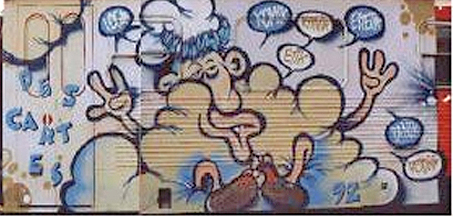
Cornbread (TTP) from Philadelphia was the No 1 pioneer of TTP, probably the very first modern “writer” in history. Before him there was just TG, and with him a new era started. He began tagging his name on buses in 1967 (before Julio and Taki in N.Y.) “with a Magic Marker and worked up…there was nothing else to do.” In Philadelphia there were several confrontations between white and black gangs on claiming territory, using a primitive form of tagging in the street corners. But Cornbread broke with this tradition and raised it to another level, using his tag “all city” and with style, as a “graffiti loner”. He and his pals “did not wanted to get involved in the dope and gang stuff” and “wanted to get into the advertisements, but no one could tell us how to do” and he,»Cool Earl and»Tity Peace Sign instead started an internal competition on who could put his tag on the most risky place and do it the most beautifully. Cornbread finally placed his name on a TWA-plane which left for the south, and on the airport entrance you could read “Cornbread welcomes you to Philadelphia”. In C:s circles was » Top Cat, who 1969 moved to Washington Heights at the north tip of Manhattan – where» Taki 183 lived, and he took with him the first style impulse to N.Y., the “platform letters”, later called Broadway Elegant. Lit.:Padwe, Sandy: The Aerosol Autographers – Why They Do It. Philadelphia Inquirer Magazine, May 2, 1971, p.8-10, 12, 44. and Ley, David & Cybriwsky, Roman: Urban Graffiti as Territorial Markers. Annals of the Association of American Geographers, Vol. 64, nr 4/1974, p.491-505. Below: Cornbread 1971: courtesy Philadelphia Inquirer.

Cowboy 69 (TTP) German writer, member of the» ABC Crew.
Crash (TTP) (John Matos) * 1961 in Bronx, N.Y. His canvases have a touch of popart and have also been a commercial success. Several big exhibitions through the years in USA and Europe since his first at Fashion Moda 1980; a big one-man show was “Crash” at Sidney Janis Gallery, Dec 1 – Dec 24, N.Y. 1988, and he also frequently worked and exhibited with» Daze.
Crayone (TTP) One of the best California writers, with hot colours, wild animals, monsters and flashy letters. Below a piece in Sacramento.

Creative typography, brief TTP-related history. Typographic decorative elaboration begins with the handwritten and illuminated bible manuscripts by the monks in the mediaevally scriptorium. The monks ductus was his personal hand, and the majuscle or major initial letter was ornamented and decorated with a motif close to the text, in a way that this letter became a picture plate. A parallel is obvious in the Arabian culture, where the calligraphic letters in the holy Quran were decorated in intrinsic ways, especially so with the kufic style. In Asia calligraphy is seen as an art form in it self, with life-long training which also refines the artists’ spirituality.
In Europe the next boom in creative typography took place in the early 1900’s Art Noveau period, and in the late 1960 ́s those elegant, organic letter forms was elaborated in the waving psychedelic art context; see > Rick Griffin and > Wes Wilson. Commercial letter styles and sign painting were also around, but more interesting in the same period was the cartoonist experiments with headlines. Above all the underground funny papers. ”MAD”, ”Humbug”, ”Help” and the like magazines had brilliant graphic artists (Harvey Kurtzmann, Will Eisner, Basil Wolverton etc) innovating ”eye-ball-kicks” on every available space, and the headlines, crowded with small figures and events inside the letters’ outline were amazing. This inspired ”ZAP” comix genius > Robert Crumb. A good example is his cover headline for ”Weirdo” in this 1980’s magazine. >Vaughn Bode ̃’s lettering not to be forgotten.
And so, Aerosol Art came along and changed the scene. The >Wildstyle lettering from 1977 and forward took the development further, had vivacity, rhythm, ornamentation, fusions, power and speed, a letter concept with no comparison in art history, with those enigmatic, dancing letter-pictures.
Crew (TTP) A crew is a loosely bound group of writers – usually 4-5 people – using a common crew name, aiming to do pieces together. The individual writer signs with his tag, and the initials of the crew which most often are 2-3 letters. Some crews last for many years, some just a few weeks, and members could be changed or added any time. As mentioned before, a famous international crew was 156, founded by Jon One. Below a list of some crews active in Stockholm, Sweden in the 1990’s.
AO – agent orange
AIO – all in one
AIT – another imperial terra
BBS – backyard boys
BTS – break the system
B2C – back 2 crime
CDC – cut da crap
CP – crime pays
COC – controllers of crime
DHT – da high techz
DN – destructive nature
DDC – dump da city
DEK – dead end kings
DGB – da giant banditz
DNC – destroy’s no crime
DOS – damage on society
DST – da system tyrantz
EOC – eyes of crime
FTF – face the facts
HCG – hardcore gangsters
HCW – heaven can wait
HTS – here to stay
ICB – innercity bombers
KIS – kings in sight
K9C – k9corps
MTK – megatronic kings
MBR – megablast rockers
MOB – mad out bombers
MPD – metropolitan defects
NSK – north side kings
NFC – no fucking class
OS – overnight sensations
PID – perfect indeed
RBS – risky business
RMA/RMCA – real magic art
SYE – society execution
SOG – stuck on graf
STM – stockholms tåg maffia
SHOF – still heavens only force
TAG – the active gangsters
TTS – this town stinkz
TWA – the war ants
TOX – the other side of xstacy
TOP – the opposite page
TP – the pricks
TMB – the mega blast
TRZ – transit rivalz
UV – ursinniga vandaler
WGS – wiseguys
WHY – witness heaven young
WOW – writers on warpath
YNZ – young gunz
One of the coolest crew names known to me is TCB in San Francisco. – The Bohemian Cavallery, ¨nuff said!
Crimes among writers if any are usually restricted to TTP – graffiti, that is, unlawful painting , tagging and» racking. Other or more serious types of criminality have been minor, especially among Kings and other successful writers. “They are not, at this point in their lives, engaged in the uglier crimes that are so common in New York”, says Nathan Glazer (1979) and the sociologist Richard Lachmann (1988) comments that “The police, district attorneys and school counsellors I interviewed /—/ doubted that graffiti writing and paint stealing were precursors to more serious crimes. One district attorney explained that ‘the link between graffiti and real crimes is just in our rhetoric’ “.
A local study by Andersson & Erlandsson, Kalmar, Sweden (1997) also confirms that “there are no connections in general between graffiti painting and other kinds of criminality”. Lit.: Glazer, Nathan: The subway graffiti of New York. New Society, Jan 11, 1979, p. 72-74.; Lachmann, Richard: Graffiti as Career and Ideology. American Journal of Sociology, Vol 94, nr 2/1988, p. 229-250. ; Andersson,Tobias/Erlandsson, Staffan: Graffiti i Kalmar. Högskolan i Kalmar, B-thesis/ Media, Kalmar 1997, p. 9. Criminologist D. Shannon found no correlation between graffiti and serious crimes in his huge Swedish study. Lit. Blomgren, Stina; Frelin, Anders (15 oktober 2001). ”Forskare slår hål på graffitimyt”. DN Kultur.
Crize (Crise) (TTP) One of the best English writers. Painted ”Dondi Memorial Piece” in 1998. http:// http://www.diffdrum.demon.co.uk/crise.html Below: Crize at Selly Oak 1992.
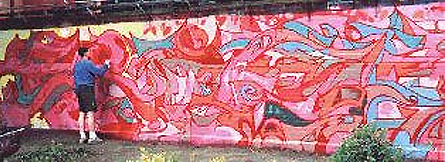
Crumb, Robert Like Bodé, R.Crumbs characters is occasionally to be found n graffiti. Robert was * 1943 in a catholic family with six children , with the father in the American Marines. Crumb seems to be the greatest of all underground cartoonists, and also one of the earliest, if not the first. In 1967 he purchased the “Gothic Blimp” magazine together with Vaughn Bode ̃. The first ZAP came the same year and he has produced an impressing œuvre since then, including Mr Natural, Fritz the Cat and all kinds of crazy stuff, funny, obscene and intellectual all together with a superb raw and rough but very precise line of drawing. He worked for Last Gasp, Print Mint, Kitchen Sink Enterprises and Rip Off Press, and from time to time he did greeting cards and chewing gum covers. He more and more made himself into the main character in adventures confessing his neurosis, desires and problems with women (especially the Womens Lib) so frank that there is no comparison at all. His criticism of our alienated civilisation is radical and ruthless. Married for 20 years with Aline Cominsky, a gifted cartoonist herself, they did some cooperation in “Dirty Laundries”. His friend Harvey Pekar also wrote some brilliant every-day-life comic manuscript for him. Crumb has also done a cartoon presentation of Kafka and of the history of the blues music. He has his own string band, and was living in a little California valley somewhere before he settled down in France. His influence on comix worldwide could probably not be overstated, and the writers owe him a lot. Lit.: The Complete Crumb Comix, 1-17. Fantagraphics, Seattle 1992-94. and Pekar, Harvey: Rapping about cartoonists, particularly Robert Crumb. Journal of Popular Culture, vol 3, nr 4, Spring 1970, p. 677-688 . Website: https://www.rcrumb.com/
CTK (TTP) Crime Time Kings . Famous Paris crew with Bando, Boxer, Senz, Sign, Squat.
Dagrin, Bengt G (TG) 1940, Swedish author, pioneering on subjects as toilet graffiti and the etymology of obscene words. ”Världen är skiti – leve graffiti” was published in 1980. He even reprinted the book ”Kakamoja”, first published in 1872, an early Swedish record of this kind of graffiti; see >Hurlo-Thrumbo http://www.forfattarcentrum.se/forf/forfa ttare.html
Dandy Bubble Gum collection. There was small collecters pictures of early danish graffiti enclosed in the gum package. First contact with aerosol art for many writers in South Scandinavia c:a 1983-4. Courtesy Lars/da.
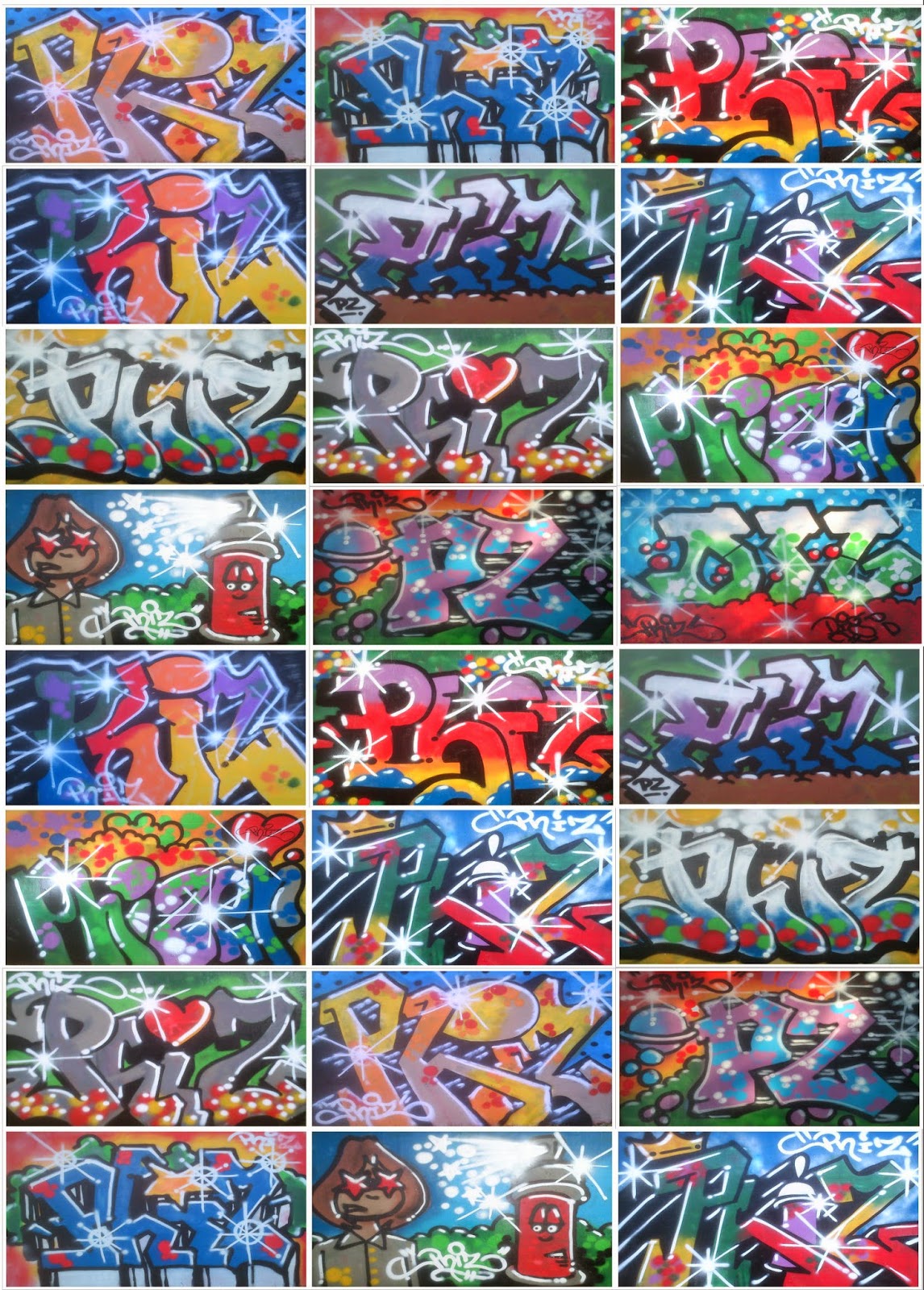
Daim (TTP) “I did not think of the chocolate bar when I took my name…” Daim is a German writer, extremely good, both on letters and characters. He is famous for his experiments in digital letter design on the edge of Delta 3D style that are most beautiful and exciting. Lit.: The Daim Interview. In: Berhard van Treeck/ Mark Todt: Hall of Fame. Ed. Aragon, Moers 1995. Website: http://www.daim.org/
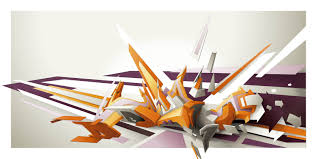
Dansk Wildstyle Graffiti (TTP) was the title of the first book on Danish TTP, by Peter Skaarup, Libero, Kbh 1985. Amazingly enough it shows in colour on its 48 pages how big the scene was just a year after it started with > The Whap Gang, and a distinct Danish style was established, with clean letters, lots of colour and lots of humor (”hygge”). This style was leading for quite a few years in Northern Europe, until the next generation came getting up.
Daze (TTP) * 1962. N.Y. veteran writer , known for hardcore pieces as well as canvas work in his numerous exhibitions. Some cooperation with Street Art artist> Richard Hambleton.
DBC (TTP) Dustbin Crew, early Stockholm crew with Baze, Mania, Detch, Disey, Ziggy, Tabu, Key One, Disarm a.o.; forerunners were Toy Co and WTM (War Team); after DBC the Stuck on Graf crew (1986) came to dominate the scene for quite a while.
DD II (TTP) did the first whole-car in Norway in March 1985.
Dedication (TTP) To give away a piece as a gift, with the message “To…” or “From..” or “Happy Birthday…” etc written above the painting. Major holidays are a common reason for dedications,> Christmas Train. A more specific kind of dedication is > R.I.P. and> Memorials
Def (TTP) Terrific.
Delta (TTP) Dutch writer, member of the> CIA and INC. He was important on the Dutch scene from the very beginning, and in the 1990:s he made an fantastic come-back with the revolutionising and innovative “wrong 3-D style”, which since then has been incorporated in most writers’ tool box. His influence on late Europan TTP can hardly be overestimated. A stylistic virtuoso, with bold pieces!

Derkert, Siri (TG) 1888-1973) Fine Arts painter, graphic artist and sculptor, was one of the first Swedish modernists and was part of the avant garde in Paris 1913-16, where she was influenced, among other things, by cubism. After breaking through in 1944, her work was often expressed in material experiments with an informal attitude and with a political radicalism, as in the huge fresco at the Östermalmstorg Station in the Stockholm Subway 1965, with graffiti-like scratchings of the word Peace in different languages, the Marseljais and references to feminist personalities, in raw concrete. This later encouraged graffiti on the opposite side of the fresco – as a public response. She has also been compared with > Dubuffet. Lit.:Soöderberg, Rolf: Siri Derkert. Sv. Allm. Konstförening, Sthlm 1974; and Linde, Ulf: Siri Derkert. Bonniers, Sthlm 1964. Below: Siri working in the subway.

Dero (TTP) Contemporary N.Y-writer, active since early 1980:s.
Designs (TTP) All minor decorations like stars, drips, bubbles, dots, etc in a piece, applied in the letters or on the background.
Desire (TTP) (Walsall) One of the best writers in England.
Détournement > Subversion of commercials, billboard ads, posters and signs. Also called >Subvertising!
Dialog graffiti (TG) A single TG graffiti could start a chain of dialog between unknown authors, like this from the ladies room:
1) Freedom for all grils!
2) (crossing over the error and write beneath) – Freedom for all girls!
3) (beneath this come the final reply):
– What about us grils?
Mac Barrick 1974 described an obscene but funny graffiti dialog from Duke University in North Carolina with 33 responses. Lit.: Barrick,M.: The growth of graffiti. Folklore Forum, No 7/1974, p. 273-275.
Dimmer (TTP) Danish writer, one of the most frequent and influential old school writers in Denmark, active from the very beginning there in 1984. Dimmer did Denmarks first whole-car “Eyes” – a true classic- in 1985 together with Freeze, Zent, with help of Zince and with Bieboy and Alec as guards.
Dipinti (TG) means graffiti done with a brush, and is known from > Pompeii, where political slogans for the city elections were painted on command. Through our history since then they have been around, not only in > political graffiti and > brigade paintings but also as individual pictures and figures, as on the SoHo walls in the 1990:s. Lit.: Roller, Lynn: Nonverbal Graffiti Dipinti and Stamps. Univ. of Philadelphia, Philadelphia 1987. (On graffiti in Gordon.) Below: dipinti from Havana and from SoHo, N.Y.
Disey (TTP) (one of the several names and spellings he used), Korean-born Swede, the pioneer and the dominant Swedish styler in the early years (1984-) together with> Ziggy as Da High Techs and with the Stuck on Graf crew (1986-), he also had close contact with Mode 2 in TCA. He made risky tags,throw-ups, pieces, trains and legal work en masse, introduced chrome-pieces in Stockholm, made the Alimenta mural , the biggest in those days in 1987, and the same year he introduced a “fat” letter style which sped up the evolution quite a bit. He also worked within the notorious APC crew. The originality of some of his work was disputed, but he is in general seen as the best writer of that time and his spray can technique was always superior. After a few years in the techno music scene during the 1990:s he made a comeback at the Spånga wall 1995 with a quite different style and attitude. Below: Disey piecing in central Stockhom, photo N.C.

Diss (TTP) To diss someone is to show himor his work disrespect.
Doc> Christmas Train
DOE This crew with Cape, New, User a.o. made the first whole-train in Denmark 1995.
Dondi (TTP) *1964 in Manhattan, (RIP) , is a legend both in the early evolution  in N.Y. with lots of trains and as a successful canvas artist with numerous exhibitions from the early 1980:s. I do consider him the most poetic among writers.
in N.Y. with lots of trains and as a successful canvas artist with numerous exhibitions from the early 1980:s. I do consider him the most poetic among writers.
Some of his very elegant and slightly indicated figures are composed into a “post letter concept” which starts with “Dear…” in the upper left corner and ends “Yours Truly” in the lower right corner. One of the very few sublime writers. Dondi was also the mentor of > Bando, Paris. Below: Dondi whole car, photo courtesy Martha Cooper.
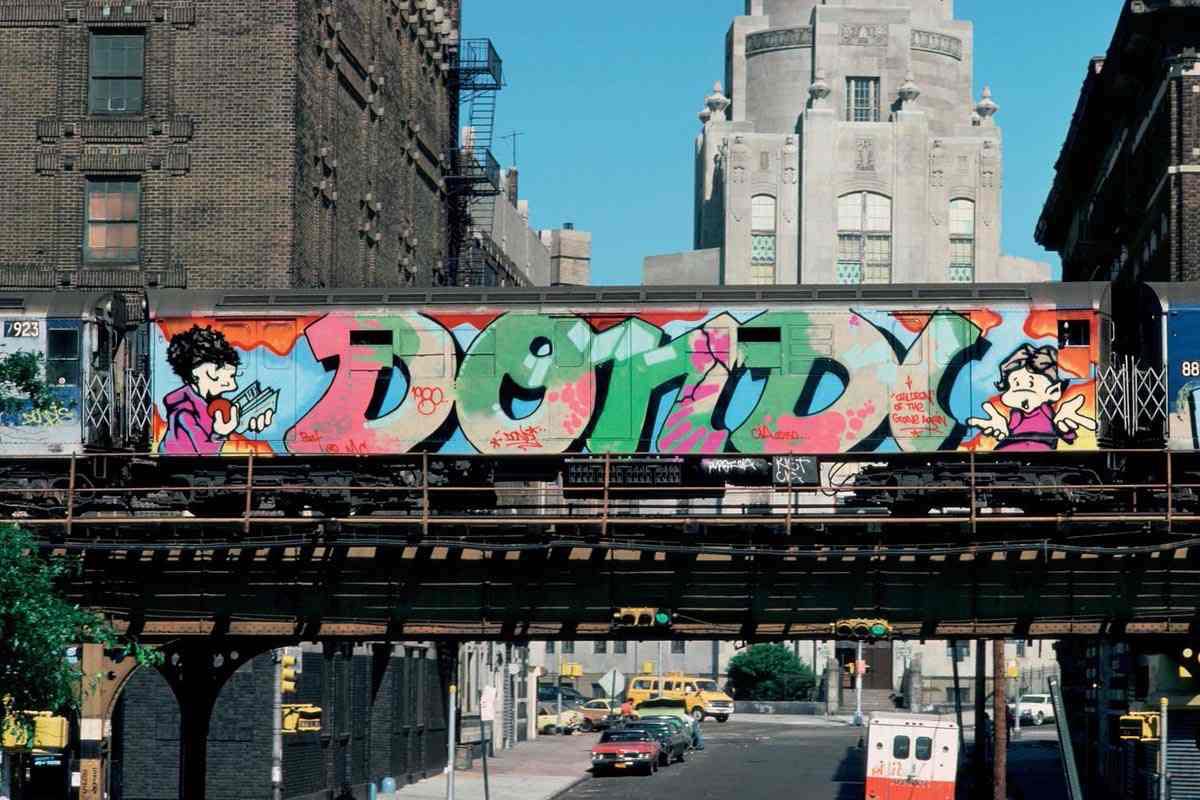
Doodling (TG) This word is used for “telephone-scribblings”, a kind of TG which is special in the way it is done: more or less unconscious, in distraction. ( A similarity to this and the surrealists ”automatism” could be noted, but in doodling you find the everyday person as subject, not the artist. ) Minor decorative, repeated patterns are frequent. This “private” graffiti form is also very common – just look around and watch your neighbour! Lit.: Thordeman, Thord: Telefonklotter/klotter. Ett försök till typologisering och attitydmätning. Uppsats, stencil. Konstvetenskapliga Institutionen, Lunds Universitet, vt 1987.
Doug (TTP) on http://www.dougweb.com hates Aerosol Art plus anything and anyone connected with it . A possible explanation, if any, of those intense, aggressive feelings against youth culture in general and graffiti art in particular could be moral panic as described by the sociologist Stanley Cohen. European zero-tolerance lobby groups admire Doug and reiterate his prejudices and misconceptions. See also> Giles > Hårdstekt. >Trellis work> Zero Tolerance. Lit.:Cohen, Stanley :”Folk Devils and Moral Panics”. Blackwell, Oxford 1972, p. 9.
Dragon (TTP) The dragon (and the> octopus) seems outstanding amongst wild animal motifs in TTP. It can be drawn in any fashion, it proposes “respect” , stands for an aspect of the male identity , for the good/evil dualism and it has a decorative value of its own. In Sweden, Disey & Ziggy made an enormous red dragon piece in 1989, Pker made a whole car dragon 1992 and in Germany Wesp, Bisas and Wild made another whole car dragon 1993; ”Steel Tattoo” by Won is a classic – this time the dragon had a shaping close to a subway car! It also appears as motve in > tattoos, folk art and in oriental art.
Dream (TTP) Oakland writer, TDK,TFP, (RIP) who does supernatural, trompe l ́œil effects in his pictures and often sharks, other wild animals and surrealistic objects. Smooth and elegant letters with lots of colour.

Drugs among writers (TTP) are a more complicated issue than it is usually recognised to be. Writers are not hard drug users. Sniffing glue or spray paint is not a habit of writers. Around half of the writer populations researched do not use drugs at all, and the other part has about the same relation to drugs (alcohol, marijuana) as other youngsters their age. It is easy to see that some early writers were psychedelic inspired, (see > Hager) but maybe not always by the drugs as much as by > psychedelic art. There were writers in the 70s who called themselves Stay High, LSD etc., but that is not a causal evidence to be generalized from. The criminologist Jeff Ferrel put it this way: “Beer drinking and pot smoking neither cause nor are caused by graffiti writing.” Lit.: Ferrell, Jeff: Crimes of Style. Urban graffiti and the politics of criminality. Garland Publ. Inc., New York 1993. P. 95.
Dubuffet, Jean (TG) 1901-1985 French artist, one of the greatest in France (and Europe) after 1945. He was especially interested in street life, the unseen, and the artwork material itself, using untraditional materials in the painting as papers, wood, leaves, scrap, earth, textiles, plaster and glue a.s.o. for reaching an informal, open and experimental art. His inspiration came also from amateur art, children ́s art, graffiti, outsider ́s art and his big collection of those items, “Art brut” or “raw art” as he called it, later constitutes the Art Brute Museum. He influenced the COBRA-group through Asger Jorn and had a major importance for all European art as against the American abstract expressionist development in the 1950s. This poem by Dubuffet (from “Bal Des Leurres”1972) says, with eventual validity for TTP:
L ’alentour et l‘entouré Le regardeur le regardé Enchangent leur place
Leur identité SPECIFICITÉLEUR PROPRIÉTÉLitt.: Dubuffet, Jean: Prospectus et tous ecrits suivants. 1-2. Gallimard, Paris 1967. and Högestedt,E.(red): Dubuffet. Catalogue, Malmö Konsthall, Malmö 1984. (Parallel texts in English and French.)
Dudez (TTP) Swedish writer from Gothenburg, who in the late 1980:s made extremely disciplined, large and hard edged illegal letter pieces, a sort of computer-style, in blue and red, sometimes together with> Dwane (characters).
Dudge (TTP) * early 1970:s, Swedish writer, member of the> VIM crew, who has done at least 500 train pieces and a lot of other works both in Scandinavia and in Central Europe.
Duel (TTP) Australian writer, known for pieces on the theme of from-straight letter-to-wildstyle transformation.
Dwane (TTP) Swedish writer from Gothenburg, cooperator with> Pike, who does pieces and trains with rich fantasy, subdued colours, bizarre humour and unusual motifs from Amsterdam to Australia.
Dzine (TTP) in Chicago does pieces clear as glass and with sharp outlines, usually huge. Famous for his experimental canvases.
E2E (TTP) Painting on a subway car which goes from End to End (but not also Top to Bottom, T-2-B).
Eisner, Will (1917-2005) Cartoonist, author and entrepreneur. He was one of the earliest cartoonists to work in the American comic book industry, and his series The Spirit (1940–1952) was noted for its experiments in content and form. Everyday stories and characters was also worked on. In 1978, he popularized the term ”graphic novel”. He was an early contributor to formal comics studies with his book Comics and Sequential Art (1985). In graffiti influence context, his intrinsic experimental letter shapes were sometimes noticed by writers, as in the Denmark scene.
El Morro (TG) or “Inscription Rock” is a location in New Mexico, USA with about 500 graffiti scratchings from several hundred years; the earliest done in April 16, 1605 by Don Juan de Ornato, the first colonist and governor. Lit.:Bongartz, Roy: The Sandstone Bluff That Is the Birthplace Of Graffiti in America. The New York Times, Oct 27, 1974, p. 26.
Eros (TTP) Leading writer of Belgium with huge, slightly moderated straight letter pieces.

Eva 62, Barbara 62 (TTP).Two of the very first taggers in the 1970’s were Eva & Barbara. It is said they tagged every bus stop on the line New York – Miami. Photo courtesy https://ahsblog2014.wordpress.com/10eva/
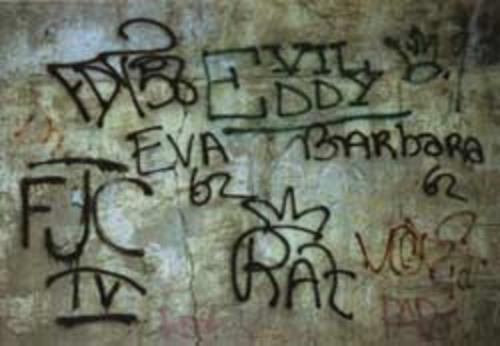
Eye (TTP) German writer, known among other things for the giant mural “Wir machen Europa” with Loomit and Mode 2 in München 1993. See also> Politics.
Eye-figures (TTP) he eye in TTP is a central motif and symbolizes the young artist ́s ability to see and his will to be seen – as the name of the writer >Seen implies. There is a complete eye-mythology in TTP with roots in psychedelic art as the winged and armed eye- ball. See>Griffin, > Motifs. Below: The 1:st Danish whole car, the ”Eyes”, by Freeze, Dimmer, Zent 1985 .

Ezada, Peter (SA) Contemporary Chicano muralist from Echo Park, L.A. His work is described and analysed in> Sojin, Kim: Vital Signs. (Ph. D. diss.) UCLA 1997.
Fab Freddy (TTP) A writer and artist who communicated intensive with other writers and with SVA-artists, Fashion Moda and SoHo gallery owners, and thereby was an important catalytic force in the graffiti canvas art sucess of the early 1980:s. Some other graffiti promoting artists were Devious Doze, TC5 and Rock Steady (who was in Stylewars and a student of Dondi.) One of Fab Freddys whole-cars was inspired by Andy Warhol ́s “Campbell Soup Cans”. He also went to Rome with TF5 in 1979 , the first European exhibition, and had a prominent role in the film >Wildstyle.
Fabulous Five, The (TTP) or Fab 5 or TF5 was the ultimate early N.Y. crew and it consisted of Doc, Lee, Mono, Slave and Slug, known for > “The Christmas Train”, December 1977, among other things. They also made the first graffiti art exhibition in Europe, December 1979 in Milano.
Fading (TTP) is a technique for> blending two colours smoothly when painting. For instance, red could be tuned into yellow by orange if you paint (with one can in each hand) outside into the middle with alternately red and yellow in thin layers.
Fame (TTP) This is important in TTP and in hip hop in general – “The name of the game is fame”. But it means fame among one ́s peers, getting up and getting a “rep”, not necessarily media or commercial fame in the hyper-american or more vulgar sense. But there is an ambivalence here, and also a risk of “selling out”.
Fantasy, SF and TTP (TTP) In the amalgam of the spray painted picture there are also certain elements of Fantasy and Science Fiction; both the illustration and comic art genres as represented by Moebius, Corben, Fazetta, Boris a.o., and the epic films like Alien 1-3, Robocop, Terminator and so on, not to mention the Gothic Horror genre. But TTP seldom copy wholesale but regenerate and transform some of its attributes into a graffiti-related creation in its own style.
Fanzines> Bibliography.
Farrell, Susan Artist, author and graffiti photographer who created the first graffiti website on the Internet, in 1994. >Art Crimes: The Writing on the Wall. She and Brett Webb run the huge site, which is centered around a geographical photo archive. Art Crimes also links to most other graffiti sites, maintains the
worldwide calendar of graffiti events, and publishes research, articles and interviews. http://www.graffiti.org. Lit.: Art Crimes. Major interview with Susan Farrell and Brett Webb. Blitzkrieg nr 7, 199, p. 14-17. See also Farrell, Susan: ”Graffiti Q and A”. http://www.graffiti.org/faq/graffiti_questions.html
Fashion Moda (TTP) In 1978 the Austrian Stefan Eins moved from SoHo and founded his non- commercial alternative gallery Fashion Moda in the Bronx.
“Fashion Moda’s premise is that art/creativity can happen anywhere and that art can be appreciated and made by people , who are known and unknown, trained and untrained, rich or poor” says Eins (Coming from the Subway,  Groninger Museum 1992). The activities had a strong local framing, and all around the gallery the hiphop culture was boiling.1980 opened Eins together with Crash (John Matos) and Noc 167 the exhibition “Graffiti Art Sucess”. With the Times Square Show, initiated by COLAB, the writers and the artists students from SVA made contact in person. Keith Haring and Jean-Michel Basquiat come to know writers like Fab Freddy, Lee, Futura 2000, and now a mutual friendship- and collaboration process started. Cultural exchange over the block- and race barriers was the result, and people who never put their foot in the Bronx came to the gallery. Fashion Moda continued with several exhibitions during the 1980:s, and other galleries like Barbara Gladstone, Tony Shafrazi, Sidney Janis and Guillame Galozzi took it to a different and purely commercial level. The last graffiti art exhibition on Fashion Moda was in 1987. Lit.: Lovelace, Carey: s. Bronx Art: There Goes the Neighbourhood. Calendar/Los Angeles Times, Sunday, Sept 2, 1984, p. 80.
Groninger Museum 1992). The activities had a strong local framing, and all around the gallery the hiphop culture was boiling.1980 opened Eins together with Crash (John Matos) and Noc 167 the exhibition “Graffiti Art Sucess”. With the Times Square Show, initiated by COLAB, the writers and the artists students from SVA made contact in person. Keith Haring and Jean-Michel Basquiat come to know writers like Fab Freddy, Lee, Futura 2000, and now a mutual friendship- and collaboration process started. Cultural exchange over the block- and race barriers was the result, and people who never put their foot in the Bronx came to the gallery. Fashion Moda continued with several exhibitions during the 1980:s, and other galleries like Barbara Gladstone, Tony Shafrazi, Sidney Janis and Guillame Galozzi took it to a different and purely commercial level. The last graffiti art exhibition on Fashion Moda was in 1987. Lit.: Lovelace, Carey: s. Bronx Art: There Goes the Neighbourhood. Calendar/Los Angeles Times, Sunday, Sept 2, 1984, p. 80.
Fat Cap 1. A nozzle with wide diffusion, applied to a spray can for writing for the first time by> Super Kool, N.Y. in 1972.
2. Norwegian fanzine regularly published in Oslo, Norway 1989 -.
FBI (TTP) (Fabulous Bomb Inability) French-German crew founded 1985 in Paris with Gor, Loomit, > Cemnoz, Shark and others. See also >Style Only workgroup. Below: FBI sketch.

Federal Art Project In the 1930:s several thousand artists were engaged by the U.S. government in s.c. PWAP and WPA-FAP programs, which resulted in a large number of public art works, big wall paintings in social realism and Mexican muralismo style. This is one important background to some of the other types of wall painting (see > Brigade Painting> Commercial Murals > Street Art) later emerging in the USA.
Fekner, John (SA) American > early Street Art artist, known for his provocative or puzzling stencil graffiti with big block letter messages, some of them in cooperation with the writer > Crash (John Matos), on abandoned buildings and vehicles.

Ferrell, Jeff (TTP) American criminologist who studied the writers in Denver, Colorado – an intense and varied portrait – and how the authorities constructed the image of their “enemy”, the writers. The huge graffiti prevention plan of the city failed in its purpose, and instead the writer ́s sale of canvas work increased 100%! Lit.:Ferrell, Jeff: Crimes of Style. Urban Graffiti and the Politics of Criminality. Garland Publ. Inc., N.Y. 1993.
Films and videos (TTP) a sample of:
Aerosol School Goes to Katowice. Erik Olsson/IOR/Studiefrämjandet/Hip Hop Corporation, Uppsala, Sweden 1991. Documentary. 25 min.
Basquiat. Dir.:J. Schnabel. David Bowie a.o. Miramax International, 1996.
Beat Street. Stan Lathan, Harry Belafonte. Acting picture, 106 min. Orion Pictures 1984.
Bomba och foörstoöra. Erik Olsson/IOR/Studiefrämjandet/Hip Hop Corporation, Uppsala, Sweden 1991.
Bombing L.A. Gary Glaser. Documentary. Glaser Productions, Beverly Hills, California 1989. Early Seventies. Private video with early train pieces, N.Y.
In Your Dreams part 1-2. Stefan Westerberg & Johan Hjerpe. Documentary. 58 min. Stockholm, Sweden 1996. Distr.:UP.
Klotter – det är väl ingen konst. Prod.: Malmö Fastighetskontor/SJ/Polisen. Malmö,, Sweden 1991. Anti-graffiti film.
Pike på Pictura. Interview, photo, red: L.M. Music: Sonny Rollins ‘Every time we say goodbye, > Bonsai Garden. Pictura, Lund University, Lund, Sweden 1995.
Stations of the Elevated. Manny Kirchenheimer. N.Y.
Stylewars. Tony Silver/Henry Chalfant. Public Art Films Inc., N.Y. 1984. The classic documentary, elected in American Film Festival ; the American contribution in Prix Italia 1984. Opening musc by Wagner…
Turk 182! Bob Clark. Twentieth Century Fox, Hollywood 1985.
Videograf. Video Graf Productions, N.Y. Graffiti news since 1990.
Visual Grafix.. Filming, Editing & Production by Kilo (SIN). London, UK.10 issues since 1995. Wildstyle. Charlie Ahearn, Pow Wow Productions, N.Y. 1983. Documentary / acting picture, 82 min.
First graffiti ever (TG) The so far oldest discovered written TG graffiti, which qualifies for being just graffiti and not any other kind of inscription, is a ”tourist-graffiti” written with cursived and simplified hieroglyphs, hieratic script, 3.500 years ago in > Saqqara, Egypt. Below:: ”I am very mpressed by Farao Djosers pyramid”, Saqqara. Around this area other scrawls, done by pyramid workers in working crews are found. They were possibly executed 4000 years ago and therefore they could also candidate or contribute to the origin of the alphabet. See also:> Field, Henry-

(TTP) First TTP-graffiti ever of its special tag style and nothing else was probably done by > Cornbread in Philadelphia c: 1967. Gang-graffiti is older (in Philadelphia since 1850, in Europe at least from 1930) and Chicano graffiti (c: 1975 on the US Westcoast) younger than TTP. See: History of Graffiti Research. https://anarchyisorder.wordpress.com/2012/11/28/graffiti-research-history/
Flame One (TTP) > Freedom Train.
Flint 707 (TTP) This legendary N.Y.- writer was, according to> Castleman, the originator of the first whole-car ever in 1973 at the Three Yard. > Futura 2000 also hold this for possible. However, this depends on what you define as a whole-car . Early Top-to-Bottoms were probably done before or at the same time:>Jack Stewart mentions Sir and also Og, Bot and Fred; but they were may be not E-2-E as Flint ́s car obviously was. Flint also made one of the earliest 3-D pieces.
Folk Epigraphs> Read
Football Graffiti (TG) devices for or against a certain football (or soccer) team – exists in all countries where this sport is known and where supporter groups are active, and are, with some rare exceptions, usually very limited in their content. See> Bushnell. A historic parallel is the gladiator graffiti ( > Seidel in Bibliography) of ancient Rome.
Frank, Bella (TTP) Brave Stockholm journalist known for skilled reports on graffiti in the left-winged and mainstream press. Graffiti protagonists had a hard time those days. Lit.: Arbetaren 6/1999, p. 5-15. (On the Norrköping scene).
Freaky (TTP) Freaky is a Dutch writer veteran by now and he has done funny pieces in a sort of geometric computer style. He ́s def!

Freedom (TTP) This N.Y. writer has also done spray paint portraits of friends and a famous wall where the old school Kings are quoted in their own style. In a tunnel Freedom has his own burner “gallery”.
Freedom of Artistic Expression is a right by law written in the Swedish Constitution. See also: UN: The right to freedom of artistic expression and creativity (A/HRC/23/34).
Freedom Train (TTP) The first whole-train ever, 11 whole-cars, was done in New York City July 4, 1976, at the number 7 yard by Cain One, Mad 103 and Flame One.
Futura 2000 (Leonard McGurr)* 1955 in New York, did recognise the early  tagging in New York 1969-70, and in spite of the fact that he was very young and shy he made contact with the writers in the Bronx, Brooklyn and at the Writers Bench. He was there mostly to look and listen at first. They seemed to accept him as he had an original tag – he took the name Futura 2000. Futura witnessed the early developement in the movement from tags to pieces, Flint 707 came around and the one he admired the most: Stay High 149; he saw the UGA exhibition in 1973 and the first whole-car in 1976. When suddenly a friend got seriously injured when his paint exploded while doing a train piece, Futura left the scene and closed the door to that part of his life and – that could have been all. He spent 4 years in the U.S.Navy and visited most continents, then he moved to Georgia and worked as a DJ at a radio station. But: in 1979 his friend from the accident wrote him a letter, they were invited to a sign painting project, and those guys happened be graffiti writers. They wanted Futura back in the scene and the train yards. He met Crash and they took part in the “Graffiti Art Success” exhibition at Fashion Moda 1980. They got good reviews, and so one exhibition led to another. Keith Haring, Jean- Michel Basquiat and Kenny Scharf became admirers, and Keith introduced him to Tony Shafrazi. He came to England the next year with the Clash, and in 1982 with Dondi and Africa Bambaataa. So there was Yaki Kornblit and then the ultimate Europe exhibition tour: France, Belgium, Holland, and he also met his wife there. The art critic Suzi Gablik called him “the Kandinsky of the space age” and his paintings were selling good and at very high prices. Today, 500 pieces and an impressive number of international exhibitions later, he says he probably did quite well, in spite of his self-taught position among the gallery people. He has a family, a home and a studio in Brooklyn, now and then takes an ordinary job, but he is still recognised as an important person of this movement. His style has changed, he says, from the very light and airy circles and spheres he used in the 1980:s, to the darker shades and the construction forms he started experimenting with in the 1990:s. The spray paint is still important, even if a combined use of other materials must be considered natural. He always put the canvas on the floor when painting to achieve what he wants, and to see him in action is to see a real master. “I simply try to do something interesting” he says. And he surely does. Lit.: Jacobson, Staffan: The Spray-Painted Image. (Diss.) Aerosol Art Archives, Lund University, Sweden 1996. P. 256-262. Futura website: http://home.dti.net/futura/index.htm www.futura2000.com Below: Far East Theme.
tagging in New York 1969-70, and in spite of the fact that he was very young and shy he made contact with the writers in the Bronx, Brooklyn and at the Writers Bench. He was there mostly to look and listen at first. They seemed to accept him as he had an original tag – he took the name Futura 2000. Futura witnessed the early developement in the movement from tags to pieces, Flint 707 came around and the one he admired the most: Stay High 149; he saw the UGA exhibition in 1973 and the first whole-car in 1976. When suddenly a friend got seriously injured when his paint exploded while doing a train piece, Futura left the scene and closed the door to that part of his life and – that could have been all. He spent 4 years in the U.S.Navy and visited most continents, then he moved to Georgia and worked as a DJ at a radio station. But: in 1979 his friend from the accident wrote him a letter, they were invited to a sign painting project, and those guys happened be graffiti writers. They wanted Futura back in the scene and the train yards. He met Crash and they took part in the “Graffiti Art Success” exhibition at Fashion Moda 1980. They got good reviews, and so one exhibition led to another. Keith Haring, Jean- Michel Basquiat and Kenny Scharf became admirers, and Keith introduced him to Tony Shafrazi. He came to England the next year with the Clash, and in 1982 with Dondi and Africa Bambaataa. So there was Yaki Kornblit and then the ultimate Europe exhibition tour: France, Belgium, Holland, and he also met his wife there. The art critic Suzi Gablik called him “the Kandinsky of the space age” and his paintings were selling good and at very high prices. Today, 500 pieces and an impressive number of international exhibitions later, he says he probably did quite well, in spite of his self-taught position among the gallery people. He has a family, a home and a studio in Brooklyn, now and then takes an ordinary job, but he is still recognised as an important person of this movement. His style has changed, he says, from the very light and airy circles and spheres he used in the 1980:s, to the darker shades and the construction forms he started experimenting with in the 1990:s. The spray paint is still important, even if a combined use of other materials must be considered natural. He always put the canvas on the floor when painting to achieve what he wants, and to see him in action is to see a real master. “I simply try to do something interesting” he says. And he surely does. Lit.: Jacobson, Staffan: The Spray-Painted Image. (Diss.) Aerosol Art Archives, Lund University, Sweden 1996. P. 256-262. Futura website: http://home.dti.net/futura/index.htm www.futura2000.com Below: Far East Theme.

Futurism. There is no direct connection between Russian or Italian Futurism of the early 1900:s and TTP. However, one can find certain secondary similarities: “No masterpiece without the stamp of aggressiveness” as F.T. Marinetti (1876-1944) says in “The Foundation and Manifesto of Futurism”, first published in Le Figaro, February 20, 1909. The focus on the speed, the power and the technology also reminds of TTP, but only on the surface; the historical and ideological differences are too many to allow any significance of likeness.
Garelik In Spring 1972, Sanford D. Garelik, president of the New York City Council declared war on graffiti. “Graffiti” he said, “pollutes the eye and the mind and may be one of the worst forms of pollution we have to combat.” He was also urging for a “National Anti-Graffiti Day”. Lit.: Garelik Calls for War on Graffiti. The New York Times, May 21, 1972, p. 66.
Garrucchi, Raphael (TG) Italian archeologist in the 1800:s who was among the  first ones to use the word “graffiti” , plur. of graffito (by lat. grafiare, from gr. grapho), scratching.
first ones to use the word “graffiti” , plur. of graffito (by lat. grafiare, from gr. grapho), scratching.
This word was used by the archeologists to divide popular, public messages from official inscriptions with capital letters on ancient monuments. A forerunner to this word is Sgraffito, used from c:a 1500 to describe a scratching technique in coloured layers of plaster or in ceramics.
Geoglyphs (TG) Prehistoric or medivial gigantic drawings on the ground as in South American deserts or on English hillsides. The motifs are mythological humans or animals and single lines. Meant to be seen from very high above, (as with a helicopter) and possibly of religious origins, those early land art works still have no definitive explanation. The Nazca-people of Peru could possibly have created the big earth patterns for processions to attract the attention of the gods to let it rain. Another mysterious big scale drawing phenomena is the circles and patterns in corn fields (crop circles) on various countrysides. The often suggested extra-terrestial explanation (intergalatic graffiti) is of course very controversial. A problem still to be solved. Below: the prehistoric Giant of a Dorset hillside, UK, 55 meters in lenght, seen from the air. See also: Petroglyphs.

Giger, Hans Rudi Swiss artist and industrial designer, standing close to surrealism, friend of Salvador Dali. Giger was rewarded with an Oscar for “best visual effects” in the first of Ridley Scott ́s films in the Alien series. His suggestive, virtuous and terrifying pictures have had an obvious influence on indivudual TTP writers.
Giles, Martin (TTP) Another zero-tolerancer who ungroundedly claims to be an ”expert”. He helps the authorities to bust writers and establish his first contact with writers with an ingratiating e-mail.
Lit.: Harne, Andreas: Han spårade en av Stockholms värsta klottrare. AB 25/4 2001. See also >Dough> Hårdstekt and > NGIN.
Girls and graffiti (TG) In the 1970:s there were lots of American sociological brief studys on graffiti published, usually in the form of a material collected on lavatories and then categorized by subjects. Some of these studies were also concerned with girls graffiti, and the common conclusion was that even if the overall frequence was slightly lower, the subject was about the same as in the mens room; eventually girls wrote more poetry and less explicit obscenities but the variation was great. Lit: Ljungström, Åsa: Carolina Damklotter. Tradisjon, 21/1991, p. 23-43. See also; https://theconversation.com/toilet-graffiti-secrets-support-and-solidarity-in-the-womens-restroom-127484
Girls and graffiti (TTP) The TTP activity have a certain masculine ring to it, because it was from the very start invented by boys and therefore structured by their gender needs. The vaste majority of the writers are boys. But there have been girls taking an early active part too, as the legendary>Eva 62 and Barbara 62. And>Jack Stewart mentions no less than 200 names of female writers in New York between 1970 and 1978. Lady Pink and Lady Heart were no singularities, neither Omega on the westcoast, Eva in Holland or Betty Blue in Sweden; there were and are also female train painting crews, both in Europe and in the USA. See> Siegel, Fern: Lady Pink: Graffiti with a Feminist Intent. Ms., vol 3, iss 5, March/April 1993, p. 66-68.
Goldie (TTP) One of the all time best Old School English (Wolverhampton)  writers, still active today, Close friend to %D and Banksy, Photo courtesy Wikipedia.
writers, still active today, Close friend to %D and Banksy, Photo courtesy Wikipedia.
Goldstein, Richard Journalist and art critic, author of the renowned article Goldstein, Richard: This Thing has Gotten Completely Out of Hand. New York Magazine, March 26, 1973, p. 35-39. which was published together with the “Taki Award” article. See also Goldstein, Richard: In Praise of Graffiti. The Village Voice, Vol. XXV, No 52, 24-30 Dec 1980, p. 55, 58. ; Goldstein, Richard: The Future of Graffiti. The Village Voice, Dec 13, 1983, p. 56. (Review of ”Post-graffiti”, Sidney Janis Gallery.); and Alleti, Vince / Goldstein, Richard(eds): Baby Love. The Art of Keith Haring. The Village Voice, May 15, 1990, p. 105-115.
Graffiti Prevention (TG) The Klotterplanket (The Graffiti Board) was erected  in Stockholm, Sweden in March 16, 1968 as the first of its kind ever. It was whitewashed once a day to make room for anyones scrawled opinions. Thgere was even a #Free Speach Tribune” close to it. The example was followed by Boston in 1971, but “it just didn ́t work”.
in Stockholm, Sweden in March 16, 1968 as the first of its kind ever. It was whitewashed once a day to make room for anyones scrawled opinions. Thgere was even a #Free Speach Tribune” close to it. The example was followed by Boston in 1971, but “it just didn ́t work”.
Lit.: Frater, Alexander: Stick it on the wall in Stockholm. Holiday, Nr 45, 1969, p. 85-86. and Bratly, Carol: Bostons Graffiti Board. The American City, Apr 1971, p. 138,140.
Graffito – the plural form of the Italian word Graffiti, is also the title of the by far most sophisticated book on West Coast graffiti in the US (1996). The Californian Bay Area has a well known radical history from The Summer of Love to the Berkeley University insurrection and the Black Panthers. Its recent graffiti subculture is likewise anti-capitalist, anti-racist and left-winged. Important writers are e.g. Twist, Poem, Vouge, Cream, Excel, Crayone, Neon, Krypt and thousands of others. ”The Oakland Tracks” are a special spot, and of course the famous Psycho City on Market Street, S.F. No trains in this book but lots of walls. See: Michael Walsh: Graffito. North Atlantic Books 1996. ISBN 1-55643-231-3.
Griffin, Rick was one of the young and gifted poster- and comix artists of the San Francisco underground art world in the psychedelic years and summers of love in the late 1960:s. See also the artists >Wes Wilson,Victor Moscouso, S.Clay Williamson, >Vaughn Bodé, > Robert Crumb. The rock posters for The Grateful Dead took form here and so did the underground Comix magazine ZAP. There was a great interest in Art Nouveau, the style of the fin de siécle, and so came the epithet “Nouveau Frisco”. Griffin had finished a comix job in LA when he started doing psychedelic rock posters. His motifs were insectlike, with highly elaborated letters and warm and intense colour.
“Griffin ́s lettering almost ceased to be functional as legible typography…he jokingly incorported meaningless calligraphy…this disregard for the legibility of lettering, creating totally abstract forms that resamble letters”
…says McClelland (1980). This is, as we can see, close to what later would became Wildstyle, and the young writers checked out Griffin alot. A very obvious example is the Flying Eye-ball. Griffin came up with this character in Zap nr 2, 1968, the insides of the magazine cover. The two variants of the flying eyeball there are in detail copied by Seen and Kid Panama (Subway Art 1984 aa,
p.29) Litt.:Griffin, R,/ McClelland, G.: Rick Griffin. Dragons World Ltd, Great Britain 1980. 95 p. Ill.
Graffiti Research History A timeline of graffiti research, findings and scholars 1593-2020. https://anarchyisorder.wordpress.com/2012/11/28/graffiti-research-history/
Groninger Museum Opened in 1874, contains art from the 1500:s to the present, including 17 drawings by Rembrandt. In 1994 it moved to a new building by the water, created by architect Alessandro Mendini.This Dutch museum has been intensely following the aerosol art evolution since the mid-1980:s, also with many workshops and exhibitions of its own. The greatest so far was the > Coming from the Subway. Lit.: Coming from the Subway – New York Graffiti Art. History and development of a controversial movement in art. Groninger Museum, Groningen Oct 4 1992 – Jan 10 1993. 320 p.
GVB (TTP) Great Visible Bombers (TTP) Famous Dutch hard core crew, to be compared with > MOA (Denmark) and > VIM (Sweden).
Hac ego cacavi (TG) Latin inscription on a bathroom wall in memory of the author’s biological needs. This genre in graffiti (s.c. latrinalia) appears fairly unchanged through history to the present day. Lit.: Dundes, Alan: Here I sit. Kroeber Anthropological Society Papers, 34/1966, p. 91-105. See also > Siegl, Norbert.
Hager, Steven Author of the interesting historical source book Hager, Steven: Hip Hop – the Illustrated History of Breakdancing, Rap Music and Graffiti. St. Martins Press, N.Y. 1984. (TTP: p. 12-30, 58-80. )112 p. Ill. He also describes the East Village artist and boheme living in Hager, Steven:> Art After Midnight. St. Martins Press, N.Y. 1986. 133 p. Ill. (TTP:p. 38-133.) and discuss TTP and psychedelics in the article Hager, Steven: The Cultural Origins of Graffiti. In:Coming from the Subway – New York Graffiti Art. Groninger Museum, Groningen Oct 4 1992 – Jan 10 1993. See also> Bubble Letters. Lit.: Hager, Steven: Graffiti – is the art world ready for it? New York Daily News, March 30, 1981, p. M1-M2.
Halfdan (TTP) A nordic Viking scratched his name, “Halfdan”, with runes in the Justanianius church (later mosque) Hagia Sofia in Konstantinopel (nowadays Istanbul), c:a 1100 A.D., which still remains (below).

Hall of Fame/ HoF (TTP) When the >Writers Corners in N.Y. were shut down because of police harassment in early 1980:s, there was a need for a new meeting point for writers who did not participate in the gallery business. The first Hall of Fame ever was the one on 106 Street/Park Avenue, a school yard in Spanish Harlem, Manhattan and it was introduced by>Vulcan in the early 1980:s ”so the kids here could have an artform of their own to relate to”. It still works, but it was also the starting point for hundreds of Halls of Fame (HOFs) all over the Western world during the 1980:s and 1990:s. Today almost every major city has its own place where writers can meet and show their masterpieces to each other. Below: From Bath Hall of Fame, UK, May 1996.

Hambleton, Richard (SA) * 1952 . American artist , painter in the> Street Art  tradition known for “The Shadowman” which was a male figure brush painted in black on house fronts both in the USA and (at his visit in the mid-80:s) in Europe. The Shadowman appeared in so many places that it looked like a pictorial> Kilroy-phenomenon, but everywhere it was Hambleton ́s work. He also did some occasional pieces with the writer Daze (to be compared with the collaboration between>Keith Haring / LA II and>Jenny Holzer/ Lady Pink).
tradition known for “The Shadowman” which was a male figure brush painted in black on house fronts both in the USA and (at his visit in the mid-80:s) in Europe. The Shadowman appeared in so many places that it looked like a pictorial> Kilroy-phenomenon, but everywhere it was Hambleton ́s work. He also did some occasional pieces with the writer Daze (to be compared with the collaboration between>Keith Haring / LA II and>Jenny Holzer/ Lady Pink).
Hårdstekt (Hårdstedt) (TTP) Overdone steak, in free translation, nickname for a Swedish official anti-graffiti fundamentalist, classifying aerosol art in the same category as rape and drug abuse. Lit: Klotter är som knark. SdS 21/8 1998. See also > Giles and > NGIN.
Haring, Keith * 1958 in Kutztown, Pennsylvania. he became one of the 1980:s dominating personalities in art during an extremely intensive 10-year period from 1980 until his death in 1990 – in fact just like van Gogh exactly 100 years earlier, 1880-1890. Haring filled his paintings with simple shapes and patterns in bright colours: people and animals, monsters and technological instruments, everyday symbols and signs. The raw material was popular culture, media and urban environment. “The art is open for everybody and that is the goal for all my activity” ; German performance artist and theorist Joseph Beuys, 1921-1986, would certainly have agreed on this position. The barking dog, the radiant child, hearts, crosses, flying saucers, pyramids, TV:s with arms and legs were some typical motives. “The man with the hole in the stomach” was made after the assassination of John Lennon. His huge rhythmical wall paintings were attacking racism, greed, intolerance, crack, and they proclaimed “safe sex”, love and peace.
After his education in Pennsylvania, he attended the School of Visual Arts 1978-1979.Here were the 80:s future artists who invaded the bohemian block of East Village.Through>Fashion Moda in the Bronx they got connected with the rising “graffiti artists” that used to visit the local clubs in that area.This explosive mixture led to the>“Street-Art”-phenomenon; the young artists abandoned the studio and the gallery and started to paint on the street. So did Richard> Hambleton with his “Shadowman”, John> Fekner with his “Stencils” and Jenny>Holzer with her “truisms”; and the young black artist>Jean-Michel Basqiuat who wrote ”Samo” and cryptic messages and who became a very close friend to Haring. (Below: Haring and graffiti writer LA II).
 In 1980 they all met at the Times Square Show, an underground art exhibition arranged by COLAB. Most of the famous graffiti artist were there as well. But Haring was not a writer, he never painted trains. What he did was to fill the vacant billboards in the subway with chalk drawings. He went from station to station with crayons in his pockets an did a huge amount of those drawings, such as “Still Alive in ‘85”, and he was even arrested.
In 1980 they all met at the Times Square Show, an underground art exhibition arranged by COLAB. Most of the famous graffiti artist were there as well. But Haring was not a writer, he never painted trains. What he did was to fill the vacant billboards in the subway with chalk drawings. He went from station to station with crayons in his pockets an did a huge amount of those drawings, such as “Still Alive in ‘85”, and he was even arrested.
Haring started to paint on sheets of plastic cover, aimed for construction work, instead of canvas, which he considered too pretentious. He gets to know LA II (Angel Ortez) who helped him in his work by including tags in Haring ́s endless rhythmic patterns. His breaking through was at Tony Shafrazi Gallery 1982, and he rapidly became commercial successful. In 1983 he paint the body of the dancer Bill T. Jones, and in 1984 his book “Art in Transit” was released.
1985 he paints cast-copies of famous sculptures together with LA II. 1986 he opened his “Pop Shop” on Lafayette Street with funny sticker, buttons, toys and things – which all were a part of his art and thought to be in control of himself before the commercialisation of his work began. The same year he painted live on MTV and does “Crack is Wack” at East Harlem Drive 128:th Street. In July Haring painted a 10 story high (!) picture on plastic cover together with 1000 members of City Kids, and in October he paints on the Berlin Wall. In 1987 he does an animated movie for MTV, and in 1988 the painting “The Prophet of Future” was executed – which actually foretold the fall of the apartheid- regime in South Africa. In 1989, he painted a giant Zeppelin at the French Revolution 200 year anniversary, which flew between England and France. 1990 Haring, marked by his disease, did the postage stamp for the International Year Against Aids. On February 16 1990 Haring dies from aids- related disease, 31 years of age. His relationship to TTP-graffiti was one of curiosity and great respect. He became a close friend not only to LA II but also to Futura 2000, who he introduced to Tony Shafrazi Gallery, and he painted a memorial for the writer> Michael Stewart after his death connected to his arrest in October 1983. Keith Haring was a great artist, enormously productive and with a very humanistic life attitude. Lit.: Jacobson, Staffan: K.Haring. Underground Productions nr 7, 2/1994, p. 9. Keith Haring. Malmö Konsthall/Cermanto Celant 10/6-21/8 1994, Malmö 1994. (Catalogue) 261 p. Ill. See also> Bibliography.

Heart, Lady (TTP) Writer friend of > Lady Pink.
Heart, the (TG) The cordial sign is probably the oldest ideogram of all, used already in prehistoric cave-art and then all the way throughout history (e.g. tree-scratchings) to recent days boy + girl = true, inscribed in a heart, sometimes pierced by an > arrow. as in ”MK 91” from the romantic Seine riverside in Paris.
Hex (TTP) Hex/TGO was entirely unknown before he popped up on the L.A. scene very suddenly in 1988, with a fully developed technical skill and completely new motifs. The first public show was the battle between Hex and Slick that year. It soon became clear that Hex was one of the best writers of characters worldwide. The “phantom cap” or ”stencil cap”, an alteration on the can cover (a small pinhole drilled on the inner ring of the can cover) which provides a thin stream, was made famous by him ( the invention is attributed to Razor KTD and Estria TWS refined it, bringing it to its present form). He also has a social and political message in his pieces to the kids out there, so he tried to paint close to public schools, e.g. He has a commercial art training and employment, but graffiti to him is a free zone where he can get an outlet for his visions. He has been most active in California, but with the Earth Crew he also did pieces in Mexico City. Ran the Hex & Omega Hip Hop Shop on Melrose Avenue in L.A. Hex quit painting for religious reasons. Lit.:Lummis, Suzanne: Spray Paint, not Bullets. Los Angeles Down Town News, Aug 28, Vol 18, nr 34, 1989, p. 20-22. ; and Jacobson 1996 aa, p. 262-264.

Hickie & Ski (TTP) This is short for the legendary police officers of the N.Y. Graffiti Squad, Kevin Hickey and Conrad Lesnewski. They got many whole-cars dedicated to them, and in 1979, when leaving their duties, they both said that “we are gonna miss the writers”. So, even if they were each other ́s enemies, it seems in a way they and the writers became friends, maybe because they got mutual knowledge and thereby respect for each other.
Compare this with the > zero tolerance policing of the 90`s! Lit.: Castleman, Craig: Getting Up. Subway Graffiti in New York. MIT Press, Cambridge, Mass. 1982, 3:e ed. 1986. P. 167-174. Below: Dedication, by Seen on his Fred Flintstone characters whole car ”Ski & Hicki” 1986.
high-light (TTP) > Outline
Highest piece above sea level. In the Himalayas, at 4.500 m, writer Bond did the highest graffiti in the world, c:a 2007. See: Ket: Graffiti Planet, 2007 (last pages). ISBN 978-1-84317-280-2.
High-Tech graffiti, (TG) example of (TG). API / Time Magazine reports an spectactular but interesting case called ”high-tech graffiti”. It seems that a couple of Intel engineers working on the design of a recent version of the Pentium microprocessor included a message that describes their feelings about Bill Gates, president of Microsoft, a good corporate pal of Intel’s. When a portion of the Pentium chip is examined under a powerful scanning electron microscope, the phrase ”bill sux” is clearly visible, etched into the surface of the chip. Now, this very example might be a hoax, but real ones are archived at ”Silicon Zoo”.
Highway (TTP) The name of a huge and famous graffiti wall in Rågsved, Stockholm. It was executed in 1989 by the STOF crew (Andrë Almqvist and others) in Still Heavens Only Force). 2019 was part of the painting gone over with blue paint by mistake. The local opinion showed great support and a conservation expert began a renovation.

hip hop (TTP) A major social framework of TTP, this youth culture includes breakdance, rapping, graffiti, scratching, mixing and related music artforms. It was born on the streets of South Bronx during 1973-1975 and constitutes today one of the largest and most vital youth cultures in all of the Western World.See> Bambaataa> Battling> Breakdance> Hager.
Film & Lit.: (a sample from the bibliography) Beat Street. Stan Lathan, Harry Belafonte. Acting picture, 106 min. Orion Pictures 1984. Toop, David: The Rap Attack. African Jive to New York Hip Hop. Pluto Press, London 1984. 168 p. b/w ill. ; George, Nelson / Banes, Sally / Flinker, Susan / Romanovsky, Patty: Fresh – Hip Hop Don >t Stop. Random House, N.Y. 1984. 199 p. b/w ill. ; Hager, Steven: Hip Hop – the Illustrated History of Breakdancing, Rap Music and Graffiti. St. Martins Press, N.Y.1984. 112 p. Ill. ; Rose, Tricia: Black Noise. Rap Music and Black Culture in Contemporary America.(Doctoral dissertation, Brown University, 1993; American Book Reward 1995.) Univ. Press of New England, USA 1994. 235 p. b/w ill.
Hip Hop Connection English monthly hiphop magazine with a graffiti appendix in each issue.
Hippie Graffiti (TG),(SA) In Haight Ashbury, San Francisco this movement blossomed with the summer of love 1967, the Woodstock Festival and Peace, Love and Understanding, and that was also the message in the TG. The psychedelic typography with its streams and flows and hallucinatory poster coulours and the murals of this collective vision in heaven and on earth was painted on walls and buildings, in Berkeley Peoples Park as well as in Tompkins Square Park in New York and other places – a beautiful painting still remains at the Christiania Free Zone in Copenhagen (below).. See > Psychedelic Art.
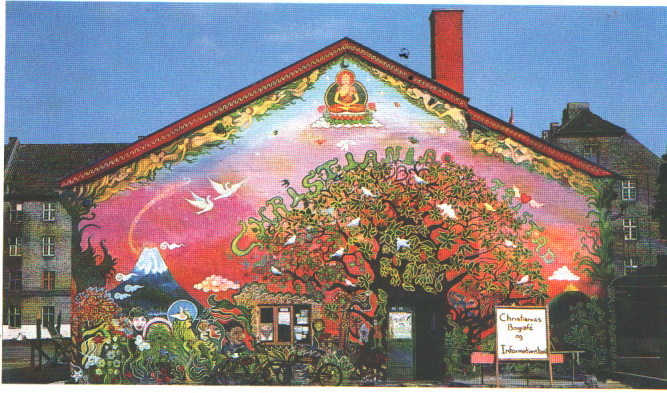
hit (TTP) Former word for “tag”. Norman Mailer says: “ There are kids all over the town with bags of paint wanting to HIT their names.” And he goes on: “An object is hit by your name, yes, and in the ghetto a hit equals a kill.- – – You hit your name and maybe something in the whole scheme of the system gives a death rattle. For now your name is over their name, over the subway manufacturer, the Transit Authority, the city administration. Your presence is on their presence, your alias over their scene. There is a pleasurable sense of depth to the elusiveness of the meaning.” Lit.: Kurlansky/Naar/Mailer:“The Faith of Graffiti”. Alskog, New York 1974.
Hiv (TTP) Finnish writer, also active in Sweden, creating funny pieces in the new unortodox style of the late 1990s.
Hobo graffiti (TG) 1) First of all there are the traditional hobo marks, which is a codified symbolic language of signs that hobos scratched with knife on fences, trees, or doorsteps close to buildings they passed and sometimes visited during their travelling. There could be signs for “here is an angry dog, watch out” or “at this place they give you food and shelter” and so on, to communicate with and support each other. Many signs are national, but some are common everywhere.
2) But there is also a more graffitilike variant, called ”monikers”, ”worker tags” or ”streaks”, which are often imitated and much respected by freight train writers. During the 1930s depression in the USA, hobos wrote their names on the long distance trains they used to travel on in search for work. This must be classified as TG, adding the remark that it actually was done on trains – before the TTP evolution began; maybe a neglected forerunner. Below: Cartoon by H.T. Webster in New York Herald Tribune 1936. http://www.snowcrest.net/bndlstif/books.html holds a comprehensive bibliography on hobos, including their marks and graffiti.
Holzer, Jenny * 1950 in Ohio, American conceptual artist, educated at the University of Chicago, Ohio University and the Rhode Island School of Design. Initially she was an abstract painter, close to Mark Rothko, but moving to N.Y 1976 she developed her “truisms”, a kind of proverb displayed on neon signs on buildings in the streets, as “Abuse of power comes as no surprise”. Between 1982-1983 she was cooperating with the female graffiti artist > Lady Pink (Sandra Fabara); both of them have a worldwide reputation.
Home-boy (TTP) A hip hop expression for 1) friends living in your neighbourhood 2) friends in one’s field of hip hop; ”homie”.
Homosexual (TG) This late 60s scrawled reply from a N.Y wall has been reproduced on many places (and in many graffiti compilation books).
– My mother made me a homosexual.
(beneath:)
– If I get her the wool, will she make me one too?
Lit.:Kilroy, Roger: Graffiti, Cogri 1979. p. 96.
Hondo (TTP) Author of one of the first T-2-B:s in early 1970:s, N.Y. See also >Sir.
Hurlo-Thrumbo (TG) This is a rare and early record of old graffiti, sometimes witty or poetic, scratched by diamond ring at the windows of public houses in England of the 1700s. Lit:.Hurlo- Thrumbo (pseud.): The Merry Thought: or, the Glass-Window and Bog-House Miscellany. London 1731. Reprint: The Augustan Reprint Society, Publ. Nr. 221-222. UCLA, L.A. 1983. 92 p.
Hype (TTP) Fanzine in full colour with international reports, published in Brisbane in Australia, edited by Broke and his brother and on the market since 1988.
I Love U (TG) The > heart, with or without the arrow of Amor, is probably one of the oldest and maybe the oldest ideogram of them all. In TG then comes the initials of the two lovers, in our time added with a +, and sometimes even “= true”. Many old scratchings of this kind remain, both interior and exterior. In Pompeii ( year 79 ) could be read this poem: “Quisquis amator erit, Scytiae licet ambulet oris..” or,
“One who loves is safe
Even in the wilderness of Skytia..”
And during the turbulence of the> May 68 revolt in Paris one could read (in translation):
“I love you! Oh, say it with cobblestones!”
Immortality, longings for (TG). “This is an inscription that I wrote with my own hand. My hand will wear out but the inscription will remain” is an inscription written c:a 1000 years ago at Smyrna in Syria. https://www.mentalfloss.com/article/541713/examples-ancient-graffiti
I.G. Times (TTP) This was the first TTP fanzine ever, founded by Schmidlapp in 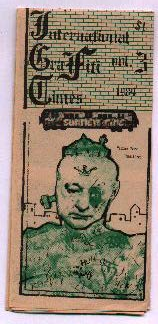 1983; published from 1984 by >Phase II, >Vulcan a.o. from the New York scene. Its original title was “International Graffiti Times”, but this was later changed to “International Get Hip Times” by policy reasons. The use of the “G-word” was condemned by certain writers as completely irrational; “aerosol art” and similar expressions were considered to be more relevant. (Personally I fully understand the difference between TTP and TG, but in this dictionary I wanted to treat both of them, each carefully separeted. The Street Art movement pictures could maybe have an abbreviation of their own.). The early issues of IG Times were printed in b/w in a diversity of formats, but it later usually appeared in full colour, packed with photos of pieces, outlines and commentaries on art, writing and politics. Over the years it was a very important source of information and inspiration, always with a radical and fearless image. The ”Aerosol Armada” slideshow lectures enlightened Yale University, Whitechapel Gallery in London, University of Virginia, Reed College, the Whitney Museum Downtown, Printed Matter in Soho and the Rock and Roll Hall of Fame in Cleveland. In association with the Italian editor Stampa Alternativa I.G.Times 1996 published the glossy photo book “Style. Writing from the Underground” ; Phase II championed the term ”stylewriting”. This was the first writer-articulated book, and the pictures are very early, very rare and usually never before published, right from the source, the real stuff and a researcher ́s gold mine. There are also whole-cars and lots of sketches. Lit.: I.G.Times, N.Y. 1984- and Stampa Alternativa/IG Times(ed.): Style. Writing from the Underground. Viterbo, Italy 1996. (In English with an Italian parallel text.)
1983; published from 1984 by >Phase II, >Vulcan a.o. from the New York scene. Its original title was “International Graffiti Times”, but this was later changed to “International Get Hip Times” by policy reasons. The use of the “G-word” was condemned by certain writers as completely irrational; “aerosol art” and similar expressions were considered to be more relevant. (Personally I fully understand the difference between TTP and TG, but in this dictionary I wanted to treat both of them, each carefully separeted. The Street Art movement pictures could maybe have an abbreviation of their own.). The early issues of IG Times were printed in b/w in a diversity of formats, but it later usually appeared in full colour, packed with photos of pieces, outlines and commentaries on art, writing and politics. Over the years it was a very important source of information and inspiration, always with a radical and fearless image. The ”Aerosol Armada” slideshow lectures enlightened Yale University, Whitechapel Gallery in London, University of Virginia, Reed College, the Whitney Museum Downtown, Printed Matter in Soho and the Rock and Roll Hall of Fame in Cleveland. In association with the Italian editor Stampa Alternativa I.G.Times 1996 published the glossy photo book “Style. Writing from the Underground” ; Phase II championed the term ”stylewriting”. This was the first writer-articulated book, and the pictures are very early, very rare and usually never before published, right from the source, the real stuff and a researcher ́s gold mine. There are also whole-cars and lots of sketches. Lit.: I.G.Times, N.Y. 1984- and Stampa Alternativa/IG Times(ed.): Style. Writing from the Underground. Viterbo, Italy 1996. (In English with an Italian parallel text.)
Iconography of TTP > Motifs > Piece > Wildstyle, the visual structure of.
IN (TTP) The inventor of the > throw-up was the writer IN, and in N.Y. 1975 he is said to have done an estimated 10.000 of this kind, but the figure is hardly an exact notation. It is also said that he had no style, but was appreciated because of his super productivity. Original member of the > NOGA.
Individual Exhibition Biography (TTP) The best list of individual exhibitions by A-One, Blade, Bill Blast, Crash, Daze, Dondi White, Futura, Keith Haring, Koor, Lee, Noc 167, Phase 2, Lady Pink, Quik, Rammellzee, Seen, Toxic and Zephyr can be found in the catalogue Coming from the Subway – New York Graffiti Art. History and development of a controversial movement in art. Groninger Museum, Groningen Oct 4 1992 – Jan 10 1993. p. 305-317.
International Situationniste (TG) A rather obvious but much neglected track in TG could be followed from the French 1920:s Surrealist revolutionary movement with its automatism experiments, to the 1940:s Lettrist group of Isodore Isou, to Guy Debord and the Internationale Situationniste in the 1960:s. Then the graffiti praxis goes in two directions: the marvellous situationiste graffiti poetry on the walls of Paris during the May revolt 1968, and the punk movement graffiti with involvement of the situationist Malcolm McLaren (stylist of Sex Pistols) in the late 1970:s. The spirit will be continued in one form or another, no doubt. Lit.: Knabb, Ken: Situationist International Anthology. Bureau of Public Secrets, Berkeley 1981. 406 p. and Wollen, Peter: Raiding the Icebox. Reflections on Twentieth-Century Culture. Verso, London 1993. 221 p. (Essays on contemporary art, culture and politics. Wollen was curator on the retrospective situationist exhibition at Centre Pompidou 1989) see:: Sussman,Elisabeth (ed.): On the passage of a Few People through a Rather Brief Moment of Time: The Situationist International 1957-1972. ICA/MIT Press, Mass. 1989. 200 p. Bl/w ill. Debords last writings before his death in 1994 are “Commentaires sur la societé du spectacle”, Paris 1988 (several translations) and “Panégyrique”. Below: Wall situ message ”Under the cobble-stones, the beach”, Paris, May 1968 (original).
Intifada, (TG) graffiti of the (TG) The mid-90s and the early 2000s was a period of escalated violence and counter-violence between Israel and the Palestinians. The uprising was called ”intifada” (’shaking off’) and produced a lot of political graffiti, executed in the traditional Arabic script. ”The revolution owns ten bullets – nine for the collaborators and one for the enemy (Fatah)” and other devices appears on the walls, here translated by Peteet, Julie: The Graffiti of the Intifada. In: The Muslim World, Vol. LXXXIV, No. 1-2, Jan-Apr 1994, p.155-167.
Ireland (TG),(SA) There is a small TTP writer scene in Ireland (TDA and TVS crews a.o. Mode 2 is also said to have an ongoing project here.); the political graffiti and> brigade painting is by known circumstances dominating, and Christine Schiavo (1988) has described its history. Lit.: Schiavo, Christine: An Historical Analysis of Political Graffiti in Belfast and Derry, Northern Ireland 1967- 1987. MA Thesis. Temple Univ., Philadelphia 1988. 249 p. Irish political murals on the web: http://cain.ulst.ac.uk/bibdbs/murals/index.html
Irus (TTP) The highly reputed French writer, together with Skki/BBC, Lokiss, Jon One and the> TCA members with > Bando and> Mode 2 , often worked towards an abstract and decorative free- style.
Isidor Isou Romanian artist * 1928, founder of the >Lettriste International in c: 1940. See also> situationism.
IT Crew. (TTP) In the late 90s there is a growing scene in Japan, and the IT Crew paints the Tokyo subway. Lit.: Xplicit Graphix 2:1, Dec 1998.
Iz the Wiz (TTP) New York veteran writer. European writers showed an early reception towards this artist.The fist train photograph in Sweden (1984) did copy Iz the Wiz together with an angry little octopus!

Jacob, Marius (TG). The illegalist anarchist Marius Jacob in c:a 1900 was raiding the Cathedral of Tours in France where he and his band stole 17th century tapestries valued at 200,000 francs. They left behind a graffiti ”All-powerful god, find your thieves!”
Jam (TTP) Expression for hiphop-party, -session or -improvisation where everybody can join in a democratic, collaborative manner.
Jan van Eyck was here.(TG) This message, in Latin, could be found hidden in the painting “Giovanni Arnolfini and his bride” by Jan Van Eyck, 1434. The artist was one of the very first developers of the oil painting technique and his work has an eminent position in Western Art History.
Jay (TTP) BBC
Jaz (TTP) Dutch writer, member of the> CIA. Below: piece by Jaz 1985.
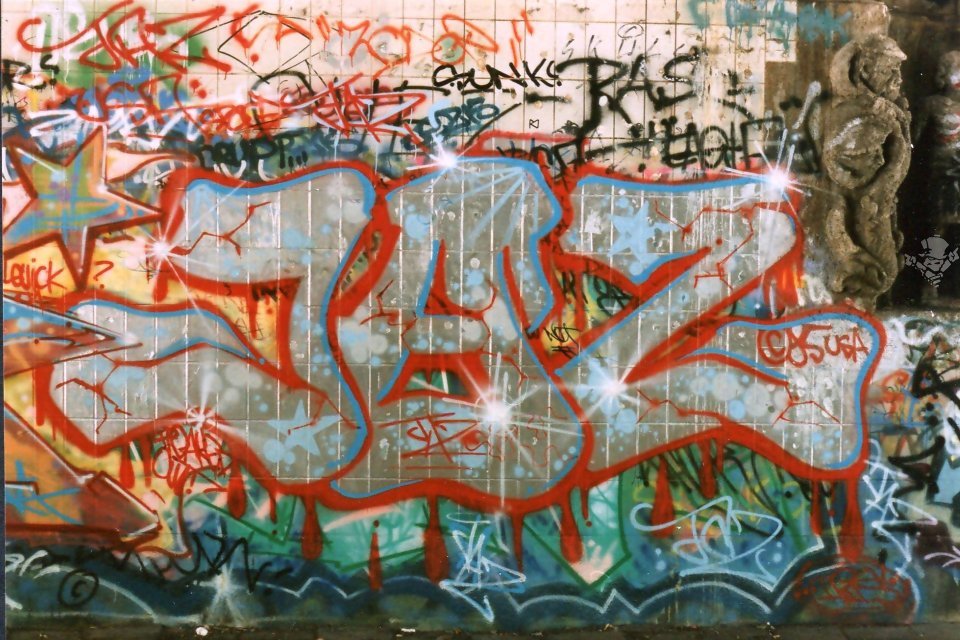
Jon One (Jon 156)(TTP) American-French writer, known for hardcore pieces and for very decorative, abstract and far out free-style canvas work. Winner of the international contest in Bridglington, England 1989 where he introduced new materials in piecing like acrylic and stamps. Since 1991 he had hundreds of solo shows. The 156 Crew , founded in the USA by Jon One, is a complex and glöbal arena; some other french members are Reso, Creez, Psy, Attila and Sib. Jon One is one of the top writers worldwide. Member of the > BBC.

Julio 204 (TTP) Julio started getting up in 1968 and it is presumable he was the first tagger in New York. He was also one of the first to use figures in his name, and> Taki says he took his style from Julio.
Junior 161 (TTP) Early old school writer in N.Y., one of> Taki ́s friends.
Junkie-cap (TTP) An inventory way to get a thin diffusion line from your spray can is to use a ”junkiecap”. The following instructions are quoted from the Berlin WSM, Wildstyle Magazine 1/99, p. 27. Courtesy Ben!
1) Insert a 0,6 – 0,9 mm needle in the front part of the Rüsselcap, usin your thumb and index finger. 2) Then you cut the plastic of the needle with sharp scissors, watch out then that you don’t push the needle deeper.
3) Take the lighter and burn out the plastic thats left on the needle. Let it cool for a while and your junkie-cap is ready.
Kase 2 (TTP) aka Case 2, King of Style, inventor of the “camouflage” sketching technique which is so crucial for>Wildstyle. Kase 2 (impressive sequence in> Stylewars) lost his arm in an accident but that did not stop him getting up and getting fame. Original member of the> NOGA.
Kilroy (TG) The message “Kilroy was here” was spread from the USA to Europe  …during WW 2, adapted first by American soldiers crossing the Atlantic, later by average, anonymous people in all kinds of risky places. The original Kilroy was, as far as we know, James J. Kilroy from Halifax, Mass., who worked for Bethlehem Steel Company, Fore River Ship Yard, in Quincy, Mass. as a ratesetter, inspecting tanks and other parts of warship under construction from Dec. 5, 1941. He used to leave this message written on the top of the tank with a yellow crayon to prove to his superiors that the job was finished. It seems that his habit spread as a gimmick from some of the 14.000 shipyard workers here as some entered the armed forces and then “Kilroy” went worldwide during the following decades. Lit.:Transit Association Ships a Street Car to Shelter Family of ‘Kilroy Was Here >. The New York Times, Dec 24, 1946, p. 18. ; Who Is ‘Kilroy >? The New York Times Magazine, Jan 12, 1947, p. 30.
…during WW 2, adapted first by American soldiers crossing the Atlantic, later by average, anonymous people in all kinds of risky places. The original Kilroy was, as far as we know, James J. Kilroy from Halifax, Mass., who worked for Bethlehem Steel Company, Fore River Ship Yard, in Quincy, Mass. as a ratesetter, inspecting tanks and other parts of warship under construction from Dec. 5, 1941. He used to leave this message written on the top of the tank with a yellow crayon to prove to his superiors that the job was finished. It seems that his habit spread as a gimmick from some of the 14.000 shipyard workers here as some entered the armed forces and then “Kilroy” went worldwide during the following decades. Lit.:Transit Association Ships a Street Car to Shelter Family of ‘Kilroy Was Here >. The New York Times, Dec 24, 1946, p. 18. ; Who Is ‘Kilroy >? The New York Times Magazine, Jan 12, 1947, p. 30.
Kilroy, Roger (TG) author of the illustrated compilations “Graffiti: The scrawl of the wild”; first published in England, Corgi Books 1979.
Kilroy, Sean (TG) author of “Irish book of Graffiti”. Cork, Eire 1980.For a more in deep hstory and analyse, see: Jacobson: ”Who was Kilroy?” https://wordpress.com/post/anarchyisorder.wordpress.com/64275

King (TTP) The King in TTP is the best in style, quantity or any other skill. If he is a piecer he does> burners even on trains, if he is a tagger he is all over more than others. You could be King of Style, King of a line, of the neighborhood, the city or more. See > Aesthetics of Graffiti.
King Pin (TTP) The very first German TTP- writer (only the English scene was earlier in Europe.) He met Lee at the Documenta 7 exhibition in Kassel 1981 and then went to USA 1983 and got in contact with other writers there. A raw sketch below.

Klotterplanket (TG), The Scribble Board. Sthlm 1968) > Graffiti Prevention
Kohl, Herbert (TTP) The first researcher of the new form of graffiti. Teacher and author from N.Y., where he 1969 together with Johnny, his pupil, began discovering the traditional- and gang graffiti, and what was just in that time beginning to develope into TTP. He wrote down his observations in an essay: Names, Graffiti and Culture. Urban Review, Apr 1969, vol 3, nr 5, p. 25-37 and one book: Golden Boy as Anthony Cool. A Photo Essay on Naming and Graffiti. Dial Press, N.Y. 1972. – and by these he built a much valuable foundation for further research.
Koor (TTP) (Charles Hargrove) * 1963. American, known for numerous canvas work exhibitions in the concept of graffiti style.
Krauss, F.S. (TG) Editor of the German year book Anthropophyteia “Jahrbuch für folkloristische Erhebungen und Forschunge zur Entwicklungsgeschichte der geschlechtlichen Moral” , which was published in 10 volumes between 1904-1913 in Leipzig. ”Latrinalia” as a graffiti object has been investigated many times since then, as by Alan Dundee and Norbert Siegl. See also > Hac ego cacavi. Pictures: www.latrinalia.com.
Kreuzer, Peter Professor in ethnology at Münchener Stadmuseeum, founder of the EGU (European Graffiti Union) for legal TTP graffiti commissions and author of Das Graffiti-Lexikon. Heyne, München 1986 – which was the first of its kind on both TG and TTP.
Krylon (TTP) The classic American spray paint brand. In 1947, duPont® introduced aerosol technology, invented in Norway, and Krylon aerosol clear coatings were soon to follow. Howard Kester came up with the brand name Krylon by combining his last name with the word Nylon®, another recent invention from duPont. Initial sales of Krylon clear aerosol coatings was limited to the artist-advertising trade. As Krylon added color to its coatings, the business quickly grew. By 1965, Krylon was the largest US producer of aerosol paints, with 112 different products and $7 million in annual sales. Website: http://www.krylon.com A bunch of Krylon was bought by the author in a Brooklyn drugstore for $ 2 each and shipped by boat to Europe.
Kyselak, Josef (1795-1831) (TG) lived in Vienna, and by notoriously writing his name “Kyselak” or “Kyselak war hier!” at all places he travelled to in the Twin Monarchy. He was at his death, 36 years old, well known in the whole of Austria-Hungary, which was also his goal. > Kreuzer argues that he was the first King of Tagging, but that seems to be an exaggeration; he did for instance not elaborate the style which is so fundamental in tagging and he did not use any nickname or nom de guerre, nor even belong to a subculture. More so he was an early> Kilroy, which of course is not that bad either. Lit.: Kreuzer, Peter: Das Graffiti-Lexikon. Heyne, München 1986.
L.A. Bomb Squad (TTP) According to Kim, Sojin (1997) the first graffiti crew in Los Angeles, “composed mainly of Latino members from East L.A. and Pico-Union.”
LA II (TTP) (Angel Ortez) A real writer who for a few years was a close cooperator with >Haring, as you can see very clearly in many of Haring ́s works, from canvases to sculptures. Below: Haring & LA II at work in Sidney Janis Galleri.
Lady Pink (TTP) (Sandra Fabara)* 1964 in Ambato, Ecuador. As the girls are in  minority in this art form, its all the more important that there is a writer like Lady Pink, not the best from the start but competing with and soon respected to a very high degree by the male writers, later leaving many of them behind with a broad, original and independent production. In 1983 she was cooperating with the female conceptual artist Jenny Holzer. She also played a role in the film> Wildstyle with> Lee and Zephyr. Lady Pinks motifs are different, in the emphatic colours and in choice of subject. You can see this in her often exhibited canvases as “The girl in the window” (1981), the dance macabre in “MTA” (1983), the excellent surreal “tunnel motifs” (1984) . She brings on new subjects as in “The Evils of Fur” (1985), with a radical approach, as in “Viva el Pueblo”, (1984). An interesting feminist view of graffiti is exposed in Siegel, Fern: Lady Pink: Graffiti with a Feminist Intent. Ms., vol 3, iss 5, March/April 1993, p. 66-68. Another interview in Mizrahi, Marylin: Up from the Subway. In These Times, Oct 21-27, N.Y. 1981, p. 19-20. See also > Girls and Graffiti.
minority in this art form, its all the more important that there is a writer like Lady Pink, not the best from the start but competing with and soon respected to a very high degree by the male writers, later leaving many of them behind with a broad, original and independent production. In 1983 she was cooperating with the female conceptual artist Jenny Holzer. She also played a role in the film> Wildstyle with> Lee and Zephyr. Lady Pinks motifs are different, in the emphatic colours and in choice of subject. You can see this in her often exhibited canvases as “The girl in the window” (1981), the dance macabre in “MTA” (1983), the excellent surreal “tunnel motifs” (1984) . She brings on new subjects as in “The Evils of Fur” (1985), with a radical approach, as in “Viva el Pueblo”, (1984). An interesting feminist view of graffiti is exposed in Siegel, Fern: Lady Pink: Graffiti with a Feminist Intent. Ms., vol 3, iss 5, March/April 1993, p. 66-68. Another interview in Mizrahi, Marylin: Up from the Subway. In These Times, Oct 21-27, N.Y. 1981, p. 19-20. See also > Girls and Graffiti.
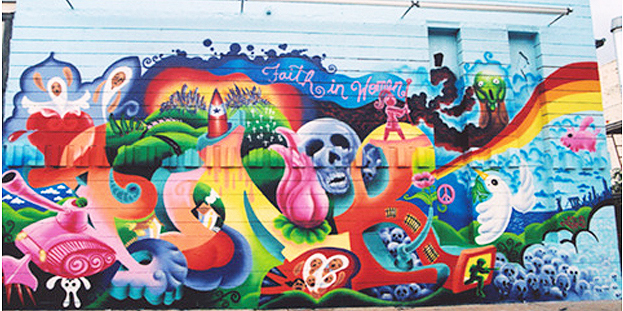
Lay-up (TTP) International term for the train yard or other region along the tracks where the subway cars are kept at night.
Lee (TTP) * 1960 in Puerto Rico. The founder of >The Fab 5 and the magnificent storyteller of their triumphatoric >X-mas train experience in Winter 1977 ( >Castleman). With the TF5 he did the first European exhibition in Rome 1979, and since then an uncountable number of exhibitions in USA and Europe. He also made so many train burners and painted so many bold boards on handball-courts that only this could do for a book. And he always had a message: against social, economic and political oppression, against war and nukes, standing on the side of the little man. His “Doomsday” double car piece 1976 will never be forgotten, not only for its messages but also for the elaboration of the piece concept itself into a comprehensive, complete pictorial room, a visual environment; not just letters and a character. If you want to see him play the role>“Zoro” in> Ahearns “Wildstyle” against>Lady Pink as “Rose”, get the movie! And Lee is still active, as a Village Voice reporter experienced when she called him this and that and he wrote an angry reply. With style, of course. Lit.: Henry, Gerrit: Lee Quinones/Barbara Gladstone. Art in America, May 1984, p.166. and Lee Quinones: New Horizons . Riverside Studios, 15 May – 16 June, London 1985. (Catalogue) and Quinones, Lee: Off the Wall. The Village Voice, Jan 5, 1987, p. 6. ( Lee ́s written reply to E.Hess, The Village Voice Dec 22,1987 on the conditions of artist life.) On Lee 163> UGA.
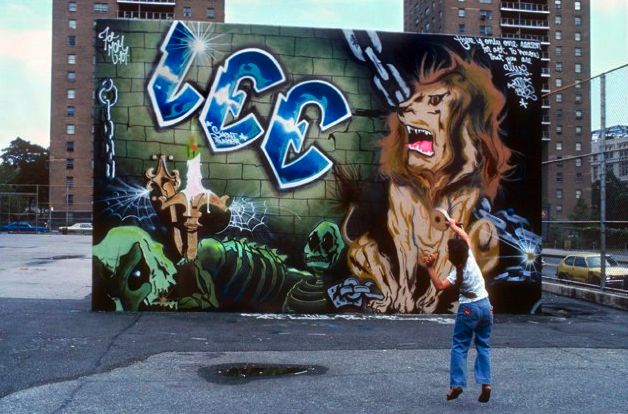
Letterism/Lettrism http://www.thing.net/~grist/l&d/lettrist/lettrist.htm See also >Isou, Isidore.
Ley & Cybriwsky One of the early highlights of TTP research was produced by two geographers. In this article they discuss territorial gang graffiti and the transition to “linear” graffiti, graffiti loners and Kings in Philadelphia. See also > Cornbread. Lit.: Ley, David & Cybriwsky, Roman: Urban Graffiti as Territorial Markers. Annals of the Association of American Geographers, Vol. 64, nr 4/1974, p.491-505.
Ligatures The connection line between the single letters of a word in hand writing;> Calligraphy. In TTP outline sketching there are some ligatures, not to be confused with fusions, which is a step further> Wildstyle.
Linné (TG) Sweden’s most world famous natural scientist (1707-1778) who systematically named all plants in Latin, Carl von Linné, scratched with a knife a blessing to one of his donators on a pine-tree in Älvdalen, Sweden July 11, 1734. Litt.: Dagrin, Bengt: Världen är skiti leve graffiti. Sthlm 1980, p.29.
Logotype A (commercial) logo, short for logotype, is a significant lettering together with a character that makes it > emblematic and a visual trade mark as Disney or Coca Cola. Writers as art directors do the nicest logos, as > Puppet’s logo for female rapper Feven ́s CD-cover and others below.
Lokiss (TTP) This french writer has a very original and increasingly abstract free-style lettering design. An early piece still respected is “Sons of the Guns”, where his sense of colour .is fully evident. In later years hs pieces resamble abstract expressionism. See also> Irus. Lokiss homepage: lokiss.art

Loomit (TTP) * 1968 (TTP) German writer from Munich, where he, among  other things, made this city’s first window-down whole-train with Cheek, Zaza, Roy, Roscue and Blash in 1985. Loomit is well known worldwide, has travelled to most countries and has good contacts with writers in e.g. USA, Australia and New Zealand. Funny thing is he uses domesticated animals and not wild ones as the rest of the character writers. He is good in every aspect of this artform and has a brilliant technique. Earlier member of The Force crew; prominent member of the >FBI crew and of >UA. Cooperation with the Sao Paolo graffitistars of the millenium Os Gemeos. Below: Detail of painting by Dash, How, Loomit a.o. 1998: Aerosol Art Calendar Y2K. Loomit homepage: http://www.loomit.de
other things, made this city’s first window-down whole-train with Cheek, Zaza, Roy, Roscue and Blash in 1985. Loomit is well known worldwide, has travelled to most countries and has good contacts with writers in e.g. USA, Australia and New Zealand. Funny thing is he uses domesticated animals and not wild ones as the rest of the character writers. He is good in every aspect of this artform and has a brilliant technique. Earlier member of The Force crew; prominent member of the >FBI crew and of >UA. Cooperation with the Sao Paolo graffitistars of the millenium Os Gemeos. Below: Detail of painting by Dash, How, Loomit a.o. 1998: Aerosol Art Calendar Y2K. Loomit homepage: http://www.loomit.de

Lucius (TG) A very early ”I was here”-graffiti is ”LUCIUS PINXIT”, written in Latin on a wall in Pompeii some time before the year 79. Kyselak and Kilroy followed this traditon too.
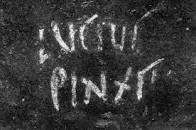
Mailer, Norman * 1923. One of the greatest American authors, who also did the earliest TTP- documentation, published as a folio-size photo book “The Faith of Graffiti”, Alskog, New York 1974. Mailer wrote the text, interviews and personal reflections, Mervin Kurlansky and Jon Naar took the photos. The book was published in many different countries under titles as “Watching my name go by” and “Graffiti de New York”, and it even appeared as article in Esquire, May 11, 1974, p.77-158. An all time classic photo essay.
Malcolm X, 1925-1965, black nationalist and muslim. He was brought into the> hip hop tradition in the 1980:s by the rap music group KRS One. Since then also honoured as a graffiti icon.> Politics in TTP. Lit. :Haley, Alex: The Autobiography of Malcolm X (1964); Goldman, P.: The Death and Life of Malcolm X (1973).
Maledicta (TG) Journal of Verbal Aggression. 1977 -. Ed.: R.A. Aman. This American journal has, among other things, published articles on language-dominated ( > epigraphic) graffiti by scholars from different disciplines and it also had some cooperation with f.e. Axel >Thiel/ Germany, Bengt >Dagrin/ Sweden, Marianne Sjöman/ Finland.
Manga The prehistory of comics in Japan is about 1000 years. Manga had its break through after the second world war with Osamu Tesuka, ”the Disney of Japan”. Japanese comic books are both violent and poetic, with very long storys and sometimes with movie-like, long sequences without text. The characters are a mix of realism and carictaure, with dramatic angels and room perspectives and the typical exaggerated, highlighted eyes. One of many famous manga artists, known even in the West, is Keiji Nakazawa. Since the 1980s manga have had a great influence on world comics, animated film – and of course on graffiti.
http://anime.jyu.fi/~anipike/ Below: cover of Friend, nr 21, Tokyo 1986. 372 p.
Mania (TTP) did the first Swedish whole car in 1986.
Mare 139 (TTP) N.Y-writer known for many things, among them graceful sketching and original material experiments as wildstyle letters cut out of sheet-metal (below). With his brother Kel he created the first website for writers, ”Voice of the Ghetto”.

Married Couple (TTP) Two connected whole-cars painted in one occasion.
Martinez, Hugo> UGA.The Internet address for UUA(United Urban Artists) is http//www.martinezgallery.com. Below: cover of the 1975 exhibitionn catalogue.

May revolt, Paris 1968 (TG) This euphoric riot rapidly spread over the planet in the magical mystery year of -68. (And in USA the graffiti revolution appeared this year, too.) Here are some slogans written on Paris´walls then, in translation:

Boredom is counterrevolutionary! Run, comrade, the old world is behind you! Already ten days of happiness! Down with the state! Let’s not change bosses, let’s change life! A proletarian is someone who has no power over his life and knows it! Occupy the factories! Power to the workers councils! Stalinists, your children are with us! A single nonrevolutionary weekend is infinitely more bloody than a month of total revolution! Under the paving stones, the beach! Concrete breeds apathy! No to coat-and-tie revolution! Live without dead time! Professors, you make us grow old! Terminate the university! We don’t want to be the watchdogs or servants of capitalism! Drive the cop out of your head. I love you!!! Oh, say it with paving stones!!! Revolutionary women are more beautiful! The more you consume, the less you live! Abolish alienation! Down with spectacle-commodity society! No forbidding allowed! The freedom of others extends mine infinitely! Poetry is in the streets! Anarchy is me! Revolution, I love you! I declare a permanent state of happiness! Be realistic, demand the impossible! Power to the imagination! Those who lack imagination cannot imagine what is lacking! Here, we spontane! Forget everything you’ve been taught. Start by dreaming!
See also>Political Graffiti> Internationale Situationiste> I love U . Lit.:.Besancon, Julien: Les murs ont la parole. Journal mural Mai 68. Ed. Tchou, Paris 1968. 180 p. More translations and compilations of the extraordinary Paris May 68 graffiti, in English by Ken Knabb, http://www.slip.net/~knabb could be found at http://www2.cddc.vt.edu/bps/CF/graffiti.htm
Maritime scrawlings (TG) have been noticed since the 1500 and can still be seen today in connection with harbours all around the world. Picture below: Ancient seamens graffiti, Bohusläns Museum.

May revolt, Paris 1968 (TG) This euphoric riot rapidly spread over the planet in the magical mystery year of -68. (And in USA the graffiti revolution appeared this year, too.) See also>Political Graffiti> Internationale Situationiste> I love U . Lit.:.Besancon, Julien: Les murs ont la parole. Journal mural Mai 68. Ed. Tchou, Paris 1968. 180 p. More translations and compilations of the extraordinary Paris May 68 graffiti, in English by Ken Knabb, http://www.slip.net/~knabb could be found at http://www2.cddc.vt.edu/bps/CF/graffiti.htm
Memorials> R.I.P.
Mene tekel (TG) According to the Bible, King James Edition (Dan.5:25-28) the first graffiti came from God, when an invisible hand wrote the Armenian words mene mene teqel u-farsin on the wall at the feast of King Belshassar, c:a 500 B.C. Daniel interpreted this message as a presage of the fall of the Babylonian empire, an evil omen. The verses goes:
“24: Then was the part of the hand sent from him; and this writing was written.
25: And this is the writing that was written, MENE, MENE, TEKEL, UPHARSIN.
26: This is the interpretation of the thing: MENE; God hath numbered thy kingdom, and finished it. 27: TEKEL; Thou art weighed in the balances, and art found wanting.
28: PERES; Thy kingdom is divided, and given to the Medes and Persians.”
This event was also the motif for a Rembrandt painting c:a 1635, now in the National Gallery, England (below).
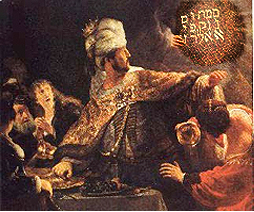
Merda (TTP) Wellknown Australian writer; engaged in all aspects of TTP.
Mess (TTP) (One of his many tags) Amsterdam writer, especially skilled in volume shaping, made the first illegal piece ever on a train in Tokyo 1992. Futura 2000, Dondi and Zephyr did a commision job on I Club in Hongkong 1982, but that does not effect Mess ́achievement.
Meeting of Styles (TTP). Founded in Wiesbaden 1997, this international aerosol art event has met 250 times since then in different countries. Below: a painting in Mexico MoS 2016. Lit.:: Meeting of Styles, On The Run Books, 2013 Image courtesy Meeting of Styles 2015.
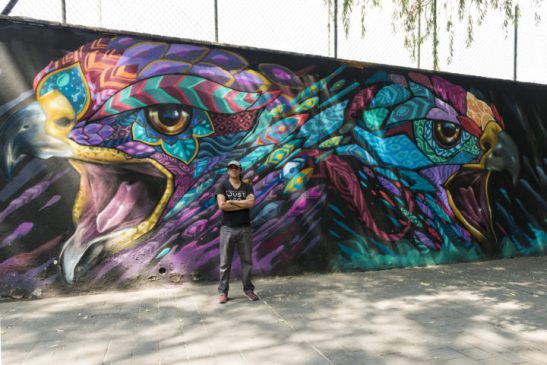
Mexican muralismo is the great mural tradition from the Mexican revolution, which combines social realism, pre-colombian and modern art, with names as Diego Rivera, David Alfaro Siqueiros, José Clemente Orozco, Juan O >Gorman and > Morilli. It represents a great part of the contemporary mural paintings and has influenced many similar art forms. As Oroszco once stated:
“The highest, most logical, purest and powerful type of painting is mural painting… It cannot be converted into an object of personal gain, nor can it be concealed for the benefit of a few priviliged people. It is for the poeple.” (Simpson 1980).
Mice (TTP) Qualified Swedish writer, author of some technical inventions such as a prolonged tube applied to the spraycan for greater spatial comfort and a re-fill spraycan which allows painting with any paint mixed with manual compressed air.
Mico (TTP) Oldschool N.Y.-writer, original member of the>UGA
Migratory graffiti (TG) A nickname or a catchword, sometimes even a drawing, which keeps wandering from place to place, executed by always new and anonymous authors. The most well known phenomena of this kind is> “Kilroy”, but migrating from Canada there also was “Clem”, from Los Angeles “ Overby”, from Denmark “Örva” and from Sweden “Brök”, along with various other examples. Lit: Reisner, Robert: Graffiti. Two Thousand Years of Wall Writing. Cowles, N.Y. 1971; Dagrin, Bengt: Världen är skiti – leve graffiti! Författares Bokmaskin, Stockholm 1980.
Miss Tic (SA) is an french artist born in Paris 1956. She is known for her stencils often seen on the streets of Paris displaying a dark haired woman togethet with poetry. She has been active as a street artist since 1985.
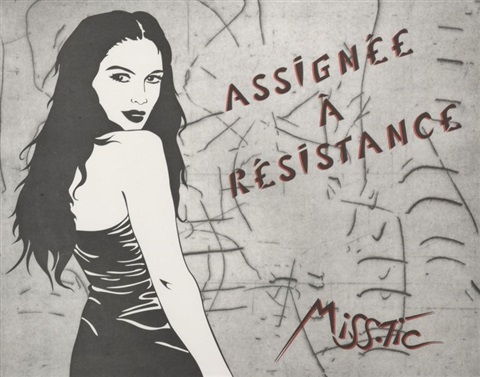
Miss Van (SA) French female street artist since 1993 with ugly-cute eroticism characters.
Miller, Ivor Lynn. American scholar who in a valuable scientific contribution underlines the ethnic and cultural background of TTP as an independent urban art form. Miller claims that TTP is an indigenous (coming from within) culture of N.Y. Lit.: Aerosol Kingdom. The Indigenous Culture of New York Subway Painters. MA Thesis, Yale University, New Haven, 1990, 2001.
MOA (Monsters of Art) with Mins, Tower, Feys a.o. The most respected crew in Denmark, MOA, was started by Mins in 1991 and has earned a tremendous reputation since then for their notorious activity. Members all write the crew name. Membership in MOA can not be combined with any other membership, it is all or nothing. And MOA does it all – tags, throw-up and pieces en masse; but they prefer it on trains!
Mode 2 (TTP) * November 1967 on Mauritius, “a small island merely known for 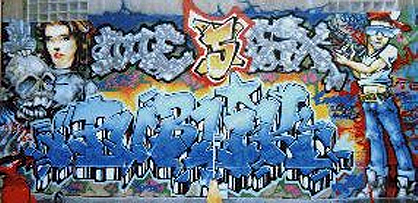 an extincted bird specie, the do-do.” On July 12 1976 he moved to England where he spent his school time, and since Thursday, July 28 1984, “at mid day time”, he has been busy with aerosol art. He came to know Scribla, another writer, and they joined the “Trailblazer”, a crew led by Zaki.They split up for a time but were reunited in 1985. The same year Bando (another legend) arrived to London. When Mode 2 moved to Paris in March 1987 Bando asked him to start a group with Pride, Zaki and Scribla. These five called themselves “The Chrome Angels” and their influence on the TTP worldwide can hardly be overestimated. “Each one of the members has his own style and could help the others to develop very fast”, Mode 2 says in 1987. Mode 2 himself most of all works with and values his letter designs, who are very hard-edged, precise and clean, good-looking and gracful. For some he is also known for having completely revolutionised the “characters” with realistic, excellently anatomic shaped human figures and astonishing trompe d ́œil-effects. He has also done trains – and artworks on canvas. But,“Graffiti belongs on the streets and the clubs. And I don ́t want any Fine Arts label on. And so, I ́m still under development.”
an extincted bird specie, the do-do.” On July 12 1976 he moved to England where he spent his school time, and since Thursday, July 28 1984, “at mid day time”, he has been busy with aerosol art. He came to know Scribla, another writer, and they joined the “Trailblazer”, a crew led by Zaki.They split up for a time but were reunited in 1985. The same year Bando (another legend) arrived to London. When Mode 2 moved to Paris in March 1987 Bando asked him to start a group with Pride, Zaki and Scribla. These five called themselves “The Chrome Angels” and their influence on the TTP worldwide can hardly be overestimated. “Each one of the members has his own style and could help the others to develop very fast”, Mode 2 says in 1987. Mode 2 himself most of all works with and values his letter designs, who are very hard-edged, precise and clean, good-looking and gracful. For some he is also known for having completely revolutionised the “characters” with realistic, excellently anatomic shaped human figures and astonishing trompe d ́œil-effects. He has also done trains – and artworks on canvas. But,“Graffiti belongs on the streets and the clubs. And I don ́t want any Fine Arts label on. And so, I ́m still under development.”

In the 1990:s Mode 2 also joined the 93NTM crew – (93 Nique ta mére) – with Kea, Colt, Kast, Keys and Terry. He has also been collaborating with German artists on a serie of enormous murals in München. Lit.: Jacobson, Staffan: Spraykonst. Kalejdoskop, Åhus 1990. p. 20-22. ; Yaklef, Tariq Ben & Doriath, Sylvain: Paris Tonkar. Romain Pillement, Paris 1991. (Excellent photo book with e.g. Mode 2, Lokiss, Jon One, Skki.) See also Edwards, Sarah: Mode 2. New Musical Express, Feb. 10/2001, p. 16; front cover by Mode 2. A nice collection photos of Mode 2 ́s pieces could be find at http://www.whitedust.demon.co.uk/mode2/mode2.html His offcial website is nowadays http://www.mode2.org/.
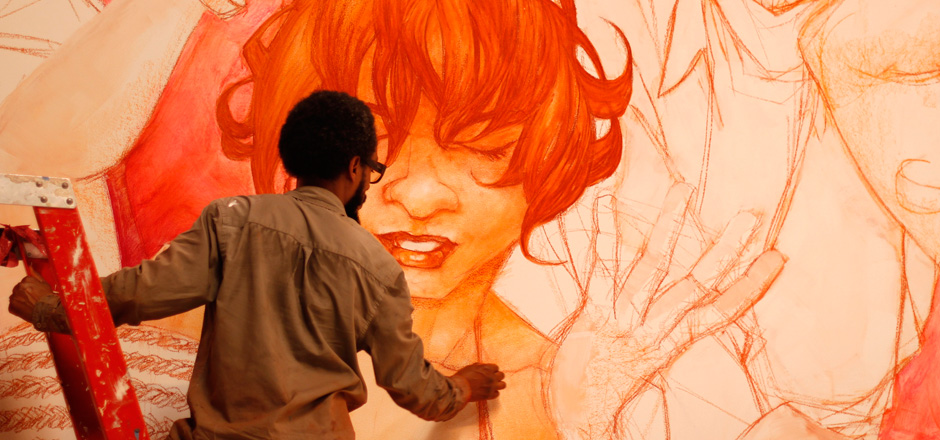
Mode 2 at work today. Courtesy Mode 2, photo credit Joel Fox.
Monogram A monogram is an ornament made of the initials in ones name, used e.g. in (elder) handwriting, in stamps and in textile folk art. The royal monogram – the initials and a crown as can be seen on some coins – has indeed certain similarities with the tagging tradition. “Tags” (TG) of the royal families are spread on e.g. opening ceremonies here and there, but of course they usually get praised rather than attacked!
Moockie (TTP) One of the best and most productive Spanish writers.
Morilli, Leovigildo Gonzales (TG) A pupil to the > Mexican muralismo genius Diego Rivera. In 1962 he and his assistants painted the gigantic 9 x 120 meter ”Mural de prehistoria” in Valle Vinales, Pinar del Rio in Cuba. Castro supported the project financially. The painting on the vertical mountainside is, from left to right, an exposé on the evolution of species, from tribolites, to mammals, to mankind – represented by the first native indian family on Cuba. Cuba also has indegenous murals, (eg. in Matanzas) and some TTP-graffiti so far; the political (state) wall graffiti is common, as are political billboards with Che Guevara instead of commercials. Cuban poster art was very famous from the 60s, and advanced graphic design is still a Cuban speciality.

Motifs in piecing (TTP) Frequent signs and pictorial elements in TTP-graffiti can be divided into groups (before they are examined individually):
1.Letters. 2. Numbers. 3. Symbols and ideograms. 4. Human figures.
5. Anthropomorphic animals. 6. Other anthropomorphic beings and objects. 7. Animals, mostly wild and dangerous. 8. Monsters, fairy-tale animals and supernatural beings. 8. Plants. 9. Organic and non- organic natural objects and artifacts. 10. Cloth- and fashion details. 11. Anthropomorphic machines.12. Space- and environment shaping. 13. Graphic elements from the iconography of comics.
Lit.: Jacobson, Staffan: Den Spraymålade Bilden. Graffitimåleriet som bildform, konströrelse och läroprocess. Aerosol Art Archives, Lund University, Lund 1996. p. 126-128.
Mucha, Alfons (1860-1939), Czech poster-artist, painter and graphic artist. His pannaux decoratifs with beautiful women, ornamented hair and flowers in a suggestible Art Nouveau style became very famous and are still popular. He was one of the most important sources of inspiration for the psychedelic art in San Francisco 1967, which in turn inspired early TTP. Many writers (such as Mode 2 and Pike) adore his work.
Mural Art. The word mural comes from Latin murus, wall. It indicates a painting in large scale, done al secco, on the dry wall, al fresco, on the wet plaster layer on the wall, with encaustic, oil or other pigments, or modern liquid colours, to show a religious, historic or political scene, to demonstrate illusionist (f.i. false) architecture or simply to decorate. Mosaic clay enamels have been in use, considered a genre of its own. Sgraffito is a technique where the picture is scratched out from several layers of different coloured plaster. Professional artist are always used. Even ceilings can be painted, like the Sistine Chapel was by Michelangelo in 1508-11.
Mural art have a close relationship to architecture; walls, house fronts and insides of residences and official buildings, which excludes prehistoric art. It is known from 6000 B.C. in Asia, from Babylon and Egypt, and from the churches of Rome in 1000-1200. After the Renaissance (see above) the next stop in mural history is the Baroque and Rococo style periods, the Mexican Revolution 1910 with its > muralismo, and after that the graffiti art movement of the 1970s. Lit.: Josephson, Ragnar m fl: Bilden på muren. Studier i Arkiv för dekorativ konst i Lund. 1965. ; Robin J. Dunitz & James Prigoff: Painting the Towns. Murals of California. RJD Enterprises, Los Angeles 1997.
Museum of American Graffiti (TTP) The collection was founded by Martin Wong and P.S. Broda, New York and holds 150 items of aerosol art on canvas or Masonite and 65 blackbooks, many of them by Kings – extremely interesting material — when I met him in his Bowery flat 1990. The collection has supported exhibitions from Washington, USA to Groningen, the Netherlands in the 1990s. Later the collection was deposed and displayed by the Museum of the City of New York, 103 Str. A book ”City as Canvas” was made out of this collection.
Naegeli, Harald Oskar (SA) (Der Sprayer von Zürich). * 1939. Psychologist by profession, not a graffiti writer or traditional painter but a self taught> Street Art artist of his own kind, drawing monochrome stick-figures in several European cities, with great skill and sensitivity, protesting against the society in general and its brutal architecture in particular. He became sort of a folk and media hero in Switzerland and Germany in the 1980s as “Der Sprayer von Zürich” and was several times sent to prison. As many other elder artists he had no understanding for TTP ; he saw it as cultural imperialism. Both right and wrong one may say. Lit.: Zürcher Sprayer (Harald Naegeli): Mein Revoltieren, Mein Sprayen. Benteli, Bern 1979.
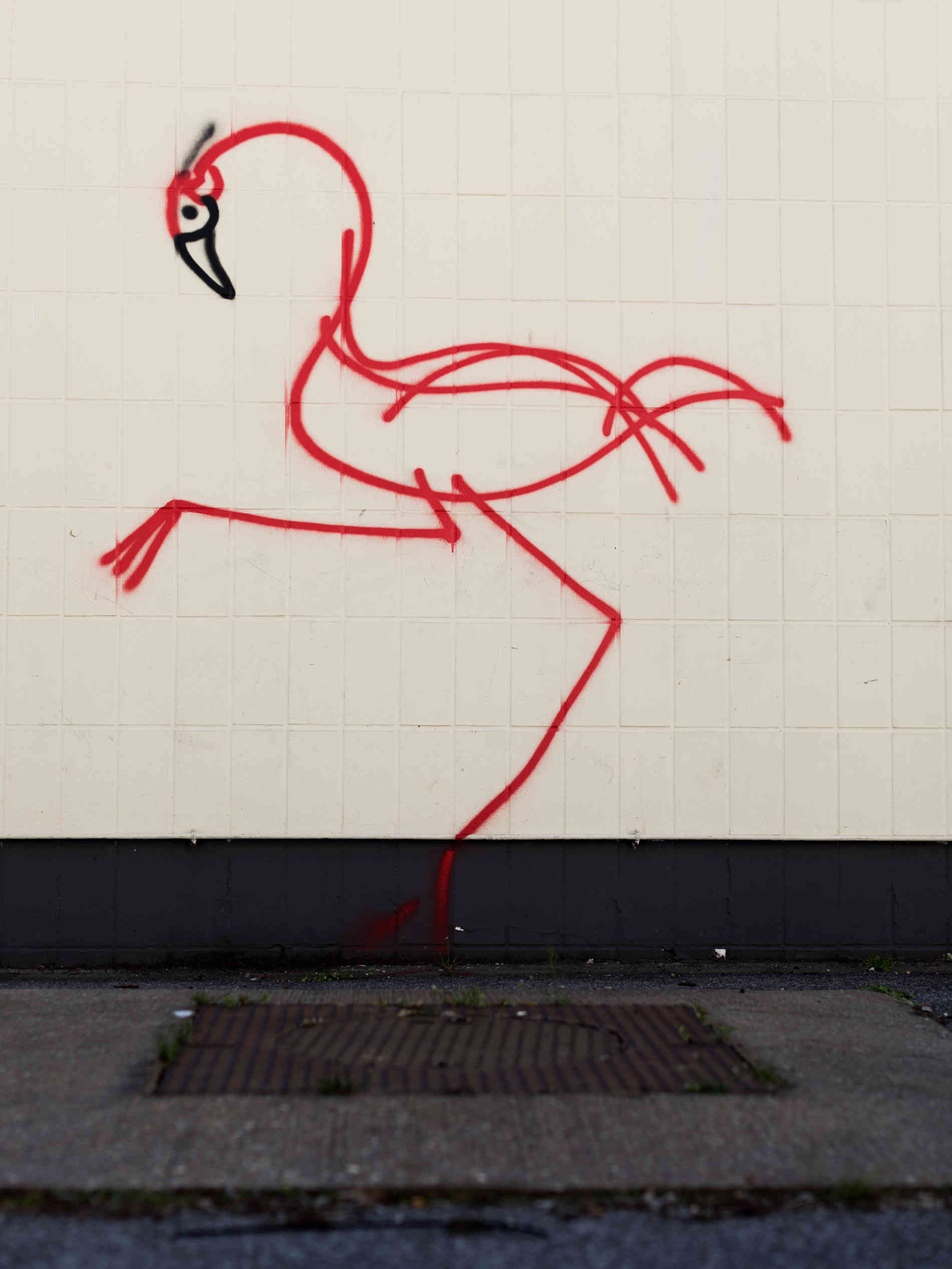
Name / naming, essays on (TTP)> Kohl, Herbert> Mailer, Norman.
NASA crew (TTP) This Californian contemporary crew could be said to form the edge of writing and sort of an (American) avant garde in TTP, as their paintings always surprises, with new techniques and material, new kinds of characters and backgrounds and never before seen letters. They are exciting!

Ndbele The Ndbele people in South Africa traditionally paint their houses with geometrical patterns in connection with the youth ́s initiation rituals. See> learning experience.
New York City Subway Resources. Besides > Art Crimes Index, this http://www.nycsubway.org/ site could be of interest for graffiti research on early train pieces. Mostly clean subway cars from all ages, but also some tags, throw-ups and pieces. The photos are professional and lots of “train- spotting” information goes with every pic. A neverending source! (Thanks to Tobias Barenthin-Lindblad.)
NGIN National Graffiti Information Network; USA > graffiti prevention organisation started in 1988. Homepages on http://infowest.com/NGIN/
Nicknames, ”nick” (TG) A major category in traditional graffiti is names in general and nicknames especially. In the USA this habit is known from the 1930s and further, in parallel with gang graffiti. During the late 1960s
teenagers ́ nicknames were mixed with Christian names and street-names. “Pat as Shorty” could be understood as: Pat is my name in the family and at home. Shorty is my name among my peers and in the streets. The oscillation between those two identities – which also marks the rite of passage – is the meaning of the proclamation “Pat as Shorty”. See also >Kohl, Herbert.
Noc 167 (TTP) (Melvin Henry Samuels Jr.) * 1961. N.Y. legendary old school veteran writer (The Death Squad, Out To Bomb etc.) Known also for the “Blondie” motif. Exhibitions in the USA and Europe.
NOGA (TTP) NOGA 1974-1976. The Nation Of Graffiti Artists was initiated by Jack Pelsinger as an alternative to and a continuation of UGA. Some of the original members were Cliff 159, Stan 153, IN, OZ, Chino Malo, Rib 161 and Kase. On their first exhibition they got this review:
“The basic ingredient of graffiti art is the kid’s name- – – be in the picture as its focal point and basic design reason. Whatever else goes on in the picture is taken from revolutionary and ghetto iconography, and it is often amazingly powerful.” (Kuhn, Anette: Graffiti Nation Without a Country. The Village Voice, June 30, 1975, p. 92.) The group was split up in 1976.
Norrköping, Graffitiskolan. The Graffiti School in Norrköping started up in 1994 by Dizel and Sate as a> community graffiti workshop, together with a hip hop café called Canslit. This project was successfully decreasing illegal graffiti, providing new opportunities for writers and establishing contacts between the youth culture and the city authorities. Norrköping is also known for the huge mural “Admire Nature”, by Zappo, Circle & Amen 1991 (below). See also:>Frank, Bella, >Zappo.
Octopus (TTP) The Octopus is, next to the» dragon the most frequent among wild animal motifs in TTP. Of course, there are also sharks, cobras and lions, and they all are meant to raise “respect”.But the octopus is special in its connotations: its enormous eyes (largest size of all animals) – the » eye itself is another well documented TTP-icon; its tentacles (spreading simultaneously and being all around as the subculture, “in control” as the writer with the can) and so the strange ability to spray paint in the surroundings! There are even some rare species who communicate by rapidly changing the colour of their skin.That is, the Octopus is also a metaphor. To trace this motif back from numerous train-paintings and walls all over, we land in the movie Beatstreet, where an octopus painting could be seen in the background of the first cuts. The film was released in 1984. And the year before was the premier of James Bond in“Octopussy”!
Odem (TTP) German writer with gracile flourishes in his graphic design; a very good styler. An autobiography called ”Odem:On the Run” by Jürgen Deppe is published in German on Schwartzkopf&Schwartzkopf Verlag, 2:nd ed. 1999, Berlin. 317 p.
Oldenburg, Claes *1929 in Sweden. American object- and happening artist in the field of pop art , known in the TTP context for the often quoted statement :
“ You’re standing there in the station, everything is grey
and gloomy, and all of a sudden one of those graffiti trains
slides in and brightens the place like a big bouquet from
Latin America.”
Lit.: Goldstein, Richard: The Graffiti Hit Parade. New York Magazine, March 26, 1973, p. 40-43.
Omega (TTP) “Probably the best female writer in California”, as Hex, Los Angeles, put it in an interview 1990.
On the Run (TTP) Fanzine. Budenheim, Germany. 1991- Ill.
Os Gemeos (TTP), (SA), are two twins, leading writers in Sao Paolo, Brazil.(autoportrait below). The 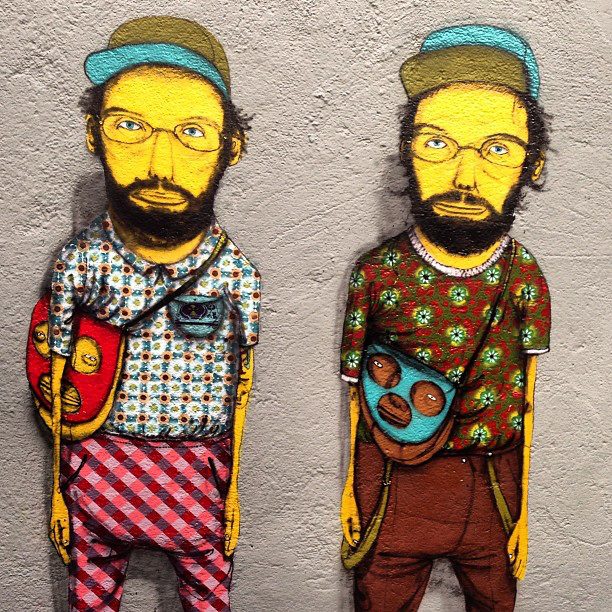 characters done in a never before seen style. Probably the 2000s new superstars of this art form, they combine a twisted but romantic fantasy, independent and original motifs and a lot of nice and unusual details. Big scale illustration art in aerosol technique. Os Gemeos sometimes cooperates with >Vitché and german writers >Loomit., >Daim a.o. An interesting and very promising clash between North and South! Brazil also has a hiphop scene, the FIZ mag and a most prolific tag style (pichaçao graffiti) done with roller and latex paint ; compare cholo and > Chicano graffiti. http://www.graffiti.org/osgemeos Lit.: FIZ Magazine, Caixa Postal 15031, Cep: 01599970 Sao Paolo, Brasil. Xplicit Grafx vol. 2 iss.1, dec.1998. See also: Aeroplane graffiti.Below: Os Gemeos, Loomit, Vitché & Speto São Paulo, 1999. Courtesy Art Crimes and the artists.
characters done in a never before seen style. Probably the 2000s new superstars of this art form, they combine a twisted but romantic fantasy, independent and original motifs and a lot of nice and unusual details. Big scale illustration art in aerosol technique. Os Gemeos sometimes cooperates with >Vitché and german writers >Loomit., >Daim a.o. An interesting and very promising clash between North and South! Brazil also has a hiphop scene, the FIZ mag and a most prolific tag style (pichaçao graffiti) done with roller and latex paint ; compare cholo and > Chicano graffiti. http://www.graffiti.org/osgemeos Lit.: FIZ Magazine, Caixa Postal 15031, Cep: 01599970 Sao Paolo, Brasil. Xplicit Grafx vol. 2 iss.1, dec.1998. See also: Aeroplane graffiti.Below: Os Gemeos, Loomit, Vitché & Speto São Paulo, 1999. Courtesy Art Crimes and the artists.

OTR3 (TTP) Did (anecdotical) the first piece on a submarin (!) in Bremerhaven Marin Museum, Germany, in the early 1990:s according to Van Treeck, Berhard: Graffiti Lexikon. Ed. Aragon, Moers 1993, p.158. The second and third pieces on a submarin (both sides) was executed in Amsterdam Habor 2013 – with photographic evidence. See: Submarin.
Outline (TTP) A) Outline 1 is the outline which finishes the piece, a black, thin line to separate out the piece from the backgound and sharpen up the characteristics of the style used. It is laid all around the piece ́s individual letters. Ouline 2. is a white line, also called highlight, which is laid on the inside of the outline 1 and gives the letters a shiny and smooth effect. There also is an outline 3 sometimes used, “the frame” outside outline 1 and this is usually thicker.
B) Outline can also mean the sketch in the blackbook.
Overkill (TTP) This is the kind of accident you could be facing when the paint is spraying out of control, e.g. when holding the can up-side-down in order to get a thin line.
OZ (TTP) Oldschool N.Y.-writer, original member of the» NOGA.
Panel-piece (TTP) A painting between the doors of a car. A window-down panel-piece is a painting beneath the windows and between the doors.
Part 1 (TTP) New York writer with an elegant, classic letter style, full of flourishes, elaborated for many years in his amazing black-books.
Partner (TTP) A protegé-mentorship relation among the U.S. writers: a “master” takes a “trainee” who is usually younger and less experienced. He helps with “fill-ins” and easier tasks while developing master competence. Then he can became a “master” himself and continue to preserve about the traditional knowledge. A typical example of this brotherly friendship relation is Dez and Trap in the >“Stylewars” movie. In Europe this kind of partnership among writers is fairly uncommon; the inhouse training hiearchy is also less evident. ”Partners in Crime” was the two writers Seen and Mad, also signed ”Madseen”.
PCP (TTP) Psychiatric Case Posse started by Cap and Lam in 1989. It is a French crew with Number 6, Decay, Popay and about 20 other members, that makes great H.R.Giger and SF comic inspired characters and very arty letters.
Peace sign This symbol was invented by G.Holton in 1958, on Sir Bertrand Russel’s initiative for the Aldermaston march. Inscribed in a circle are the two signs in the signal flag system for “N” as in Nuclear and “D” as in Disarmament. The peace sign symbol was used in the early European peace movement marches against the nuclear bomb, and it’s still used as a button by the peace movement, and in wall paintings, both TG and TTP.
Pelsinger, Jack » NOGA
Pena, Frederico (TTP) Mayor of Denver, Colorado . At an anti-graffiti conference there in 1990 he remarked: “No matter how good it looks, graffiti is ugly”.> Ferrell.
Penck, A.R. (Ralf Winkler). German Fine Arts painter, * 1939. His “stand art”-paintings are schematic black and white stick-men, often together with simple graphic symbols and signs. His aim was an universal art expression, and there he inspired both>Keith Haring and>Jean-Michel Basquiat.
Petroglyphs (rock-carvings) In France, Sahara and Australia, e.g., petroglyphs sometimes goes back 30 000 years, in USA and Scandinavia they are sometimes younger, estimated 4000 B:C – 500 B.C. The Swedish petroglyphs are done by hunting, fishing or agriculture people, on flat rocks, and they show human beings, quarry animals and ships. They are considered to be of hunting-magic, ritual or religious meaning, were important for the tribe community and done by specialists, and they are not (which also goes for the later, official »Rune-stones) to be confused with early graffiti.
Phantom Cap » Hex
Phase II (TTP) * 1958. Original member of the’ UGA. Phase II started tagging the subways of New York in 1970, and he had a central role in the stylistic development of piecing in general and wildstyle in particular. The» “Bubble letters” or “softies” came with him to the aerosol art, and he had a catalytic role for many other style inventions. His drawing ”Evolution of a Style” shows a rapid change. From 1984 he also worked with editing»I.G. Times, the 1st TTP fanzine, and lots of exhibitions in USA and Europe were executed. One of his major canvas works is ”Majestic“ (1984), geometric flaps and corners with dark blue and Klein-blue as dominating colours; a totally fascinating painting. Below: ”Sans titre”, 1985. Courtesy Phase II.
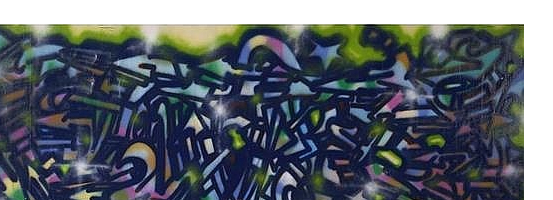
Phun Phactory (TTP) A large, lively and very successful graffiti community center on Long Island, New York, in a 4.000.000. square feet space. A quote from the project plan:
“The purpose of the Phun Phactory is to promote legal Aerosol Art in New York City. By obtaining legal spots we allow artists to channel their talents in a constructive manner versus destructive. Furthermore, the Phun Phactory is to provide alternative programs in an attempt to channel the energies and talents of Aerosol Art artists towards positive growth and development”.
Founder and president is Pat de Lillo. Website: http://www.phunphactory.org
Lit.: Dipaolo, Marc: New Graffiti Strategy. If you can ́t beat them, join them. Staten Island Sunday Advance, feb. 15, 1998, p. 21,23. ; Gonzales, David: Legal Graffiti? The Police Voice Dissent. The New York Times, Sept. 19, 1996.
Phidias (TG) Phidias was the greatest artist in ancient Greece and his sculpture of Zeus in 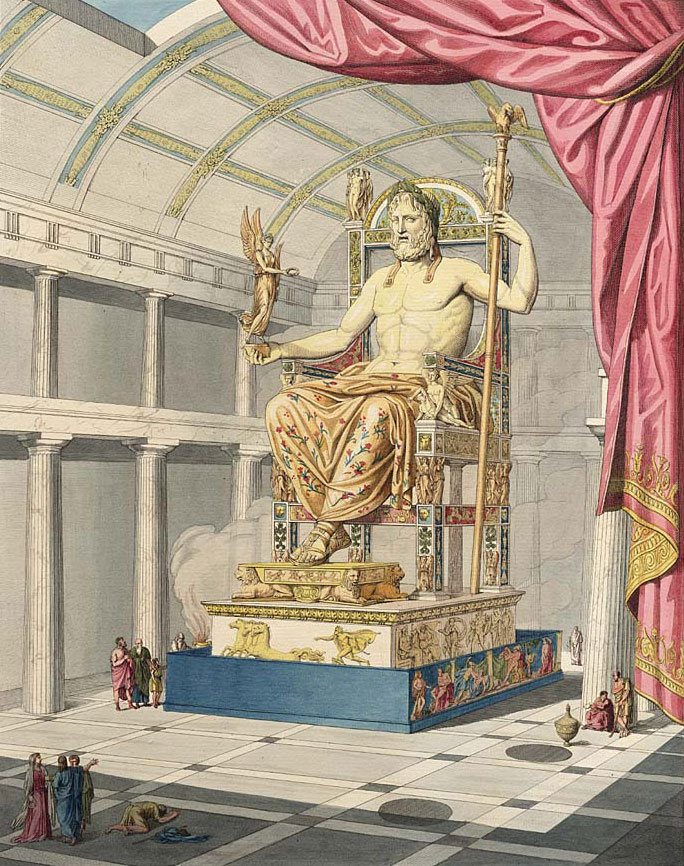 Olympia c:a 435 B.C. was 12 meter high and made out of ivory, gold and gems, one of the seven wonders of the world by this time. On one of Zeus finger, high up, he wrote the small graffiti ”Pantarkes is beautiful” and so made him immortial. His friend Pantarkes was a young wrestler in the Olympic Games.
Olympia c:a 435 B.C. was 12 meter high and made out of ivory, gold and gems, one of the seven wonders of the world by this time. On one of Zeus finger, high up, he wrote the small graffiti ”Pantarkes is beautiful” and so made him immortial. His friend Pantarkes was a young wrestler in the Olympic Games.
Picasso, graffiti by (TG) Pablo Picasso, in an interview with his friend Brassai (Gyula Halasz) tells the following episode (in short). He was in Paris, going to the Bank office. The building was under restoration. Waiting for his turn, he started scribbling a picture on the wall at a certain spot in a hidden corner. A few years later, he was told, that piece of the wall with his graffiti – “as a fresco by Picasso” – had been removed by the director of the bank and transported to his residence, where it still, so he says, can be found. No further details on motif or location is given in this anecdote. Picasso was also very impressed by the (TG) graffiti invetiveness. Lit.: Brassai (Guyla Halasz): Graffiti. Zwei Gespräche mit Picasso. Chr. Belser Verlag, Stuttgart 1960. p. 41.
Piece (TTP) Short for Masterpiece. It was invented by Super Kool 1972, elaborated by Phase II and collectively by the writers the following years and found its fully developed form with Lee’s figurativ additions in the mid-1970s.
The concept since then is this: A background in any form to divide the piece from the surface. A letter-picture (name) in center (usually in wild style) as the focus. Characters (eventually) on the left and right side of the letters. Title or titlebox over or close to the letters. Signature(s) and name of the crew here under. The motif is the letter, the material is the spray paint and it usually is applied on a subway car or a wall.
This is the concept, but it should not be followed in detail, and it is most important that the writer fill it up with his own ideas and variations. So, there are also pieces with just letters or just characters, but a “burner” is often a complete masterpiece with flashy 3-D letters and a complex pictorial environment. The “freestyle” pictures, as used in gallery graffiti, have lost those significants and are more to be compared with other traditional artwork, but the original “piece” is a special type of picture, a genre of its own, and unique.
Pike (TTP) * 1972 in Malmö, Sweden, probably one of the very best. Started tagging in 1985, did his first piece on wall 1986 with Khaki and the first whole-car same year. By July 1989 Pike had done 176 pieces, by August 1990 he had done 297. Then he stopped counting! For many years he cooperated with the Swedish Westcoast writer > Dwane. He had commissioned jobs with educated artists, his own studio and good, sometimes intense, contacts with Danish and Dutch writers. Pike has done anything from tags and whole-cars to giant murals and art exhibitions. In his number 200 piece “Base” he uses a compact wildstyle letter form; in the style he invented the letter is inscribed in a virtual block. The center of the letterform could be read as the diminished original letter, but then it expands and grows out from there in all directions. His characters have a distorted and psychedelic look, sometimes with a SF-touch; >H.R.Giger, > Mucha and surrealism interested him in the early days. He has tried all kinds of material experiments within the limits of this artform. In the late 1990:s Pike work together with the Swedish artist Mattias Bäcklin. » James Prigoff call him “one of the 10 best writers in the world” and » Mode 2 says “Pike ́s characters have already changed things alot”. Lit.:Jacobson, Staffan: Den Spraymålade Bilden. Graffitimåleriet som bildform, konströrelse och läroprocess. Aerosol Art Archives, Lund University, Lund 1996. p. 89-92, 252-256. Below: A Pike painting courtesy https://blog.vandalog.com/tag/pike/

Pistol 1 (TTP) In 1973 he revolutionised the TPP with the 3-D piece (Castleman aa, p. 56) and so did Priest 167 (Stewart 1992 aa, p.5)
P-jay (TTP) N.Y. veteran writer .
Poem (TTP) N.Y. writer, an excellent stylist, which is shown in his very elegant sketch-work.

Political graffiti (TG) Has been around since the Greek and Roman antiquity. In Pompeii (79 A.D.) there were lots of political inscriptions for and against the rulers of the city, and during elections there were paid muralists who wrote flattering things about the candidates with a brush on the wall, s.c.> dipinti. Wars and revolutions increased the political graffiti, and from the French Revolution this was frequent. In the> May 1968 Paris events political graffiti was everywhere, proclaiming another society and a different life, radical demands and beautiful poetry, as “Under the pavement, the beach” and “Fantasy to power!”. USA, England, Scandinavia, Germany and Italy (Rome was all tagged out) had a great deal of this graffiti during the Vietnam War and in the 1970:s, and >Ireland, Cuba and the Middle East (>Intifada) still have, as other conflict areas or countries. The content is most often left wing, Islamic or> anarchist, but sometimes racism unfortunately also appears. Local opinions could possibly be perceived on the walls more sensitively then in the media. And no censor! For pictorial political TG see > Brigade Painting.
Politics in TTP (TTP) Freedom to Write: explicit social, anti-racist and political messages. Sometimes there are statements in the pictures, as references to the Zulu Nation ideology, but also other subjects appear. In the early 1970:s there was sloganeering against Nixon policy and the Watergate scandal. Lee often criticised war and nuclear weapons. His paintings on canvas – as “Society ́s Child” – could represent an addict wrapped in the Stars and Stripes, or B-52:s over Vietnam. Zappo in Stockholm makes paintings against the environmental pollution and the exploitation of the tropical forests. Quik makes pictures against racism and racial oppression, such as the one where a black man is hanged by a rope tied up to a cross, or where a map over “Negroes as percent of the total population” in the Los Angeles area is titled: ”I’ve got a problem”. Chico paints in the Lower East Side of Manhattan against crack and other drugs. Solidarity with the third world and ethnic minorities is expressed e.g. by the radical I.G. Times fanzine, and painted tributes are dedicated to Dr Martin Luther King, Malcolm X (“by any means necessary…”) or Prime Minister of Sweden Olof Palme. In München 1993 Loomit, Eye and Mode 2 painted the 5 x 14 meter mural “Wir machen Europa”, a far from non critical comment on the European Market, with astonishing tromp l ́œil effects. Pike (Sweden) also took a critical view of civilisation in “Land of Rape and Honey”. The music group Public Enemy (Fight the Power!) have caught up and accumulated the black consciousness, and the solidarity with the people of South Africa has often been shown on both sides of the Atlantic. The painter Hex in Los Angeles has brought up new subjects as child abuse, and there are also writers with a directly Christian message (eg. Pray, Zappo & Amen). The painter Skki declares he wants to do “a sort of social critic journalism. I want to point out the negative aspects of our society.” On European vs. North American culture and hip hop he further says that ”nowadays Europe has got its own identity, and that is good. USA stands for capitalism and arrogance. But some of them are cool….” Thus those examples do not coincide with the opinion that TTP should be superficial and empty, or surface aestheticism in the postmodern mood. On the contrary, it is something rare in the 1990s, an angry, offensive and radical art form. Lit.: Jacobson, Staffan: The Spray-Painted Image. (Diss.) Aerosol Art Archives, Lund University, Sweden 1996.; p 138-139. Below: Che Guevara stencil.
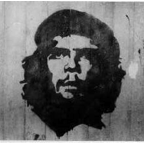
Pompeii (TG) The Roman city of Pompeii was suddenly and dramatically buried in vulcanic ashes during Mt. Vesuviu ́s outburst in 79 AD, and it was the archeologists’ delight in the 1700s-1930s: everything was unearthed and it appeared as if virtually no time had passed. The graffiti was also preserved intact: the walls were covered with all kinds of ancient Latin scrawls – trivia, obscene, political. Some are quoted in this dictionary on » Admiror » Dipinti » I love U» Political Graffiti; more appears in the litterature listed below.  Lit.:Tanzer, Helen H.: The Common People of Pompeii. A Study of the Graffiti. Studies in Archeology No 29, The John Hopkins Press, Baltimore 1939. 113 p., b/w ill. (The caricature of the mayor of Pompeii above comes from this book.) Lindsay, Jack: The Writing on the Wall. An Account of the last days of Pompeii. Muller, London 1960. 276 p. b/w ill. Koloski-Ostrow, Ann Olga: Builders, Bathers and Businesswomen: Unpublished Graffiti from the Sarno Baths at Pompeii. American Journal of Archeology, Vol 90, iss 2, 1986, p. 188. (Rev.) On the web: http://www.smokylake.com/Christy/graffiti.htm
Lit.:Tanzer, Helen H.: The Common People of Pompeii. A Study of the Graffiti. Studies in Archeology No 29, The John Hopkins Press, Baltimore 1939. 113 p., b/w ill. (The caricature of the mayor of Pompeii above comes from this book.) Lindsay, Jack: The Writing on the Wall. An Account of the last days of Pompeii. Muller, London 1960. 276 p. b/w ill. Koloski-Ostrow, Ann Olga: Builders, Bathers and Businesswomen: Unpublished Graffiti from the Sarno Baths at Pompeii. American Journal of Archeology, Vol 90, iss 2, 1986, p. 188. (Rev.) On the web: http://www.smokylake.com/Christy/graffiti.htm
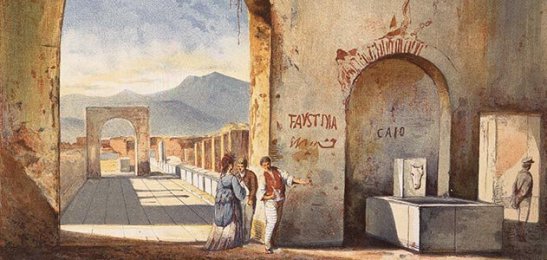
Pone > Cat 22
Postgraffiti (TTP) This expression was introduced by Dolores Neumann in the foreword to the catalogue Postgraffiti. Sidney Janis Gallery. Dec 1-31, 1983. N.Y. 1983. and has been used since then (e.g. in the Washington exh. 1991) as a synonym for spray art on canvas for sale at galleries. The term is not one of the best as it implies that TTP in its original form is passed by, which is not the case. The underground graffiti and the gallery variant have had a parallel development from the very beginning and yet neither of them seems to vanish.The art is safer in the museum but more fun in the streets!
Postmodern Postmodernity is not a style, but a counter reaction to and a deconstruction of the linear Modernism in art, and was first obvius in architecture in 1970, where totally different historical expressions could be mixed all together. The break throug came with the Venice Biennale 1989. Art is no longer just painting, but also all kinds of media, materials, texts and thoughts. Installations, video art, projects, performances and conceptual art are all part of this, and the object as well as the subject is less important than the social act. The artist is a commentator and a researcher, and he can quote other works or styles. Noteworthy is that Graffiti Art, according to art critic Göran Ståhle, could be seen as the purest and most hardcore of all postmodern art, but this is far from uncontroversial; the postmodern concept is dismissed by many. Lit.:Ståhle, Göran: Det postmoderna sveket. Paletten 204, 1/1991, p. 28- 35. p. 34.
Power (TTP) Californian writer, editor of» Can Control magazine (which is the follower of Ghetto Art).
Pray (TG) The title >”Queen of the City ” traditionally belongs to Pray, a shy and by that time 80 year old woman in N.Y. who scratched the word Pray with a sharp object on practically every telephone box in the entire Manhattan. She was everywhere, and the writers were impressed. Although not a “writer” herself or in the subculture, more a TG- individual, she was most respected by all the writers. Profiled in newspapers, there is also an elderly man in Hong Kong, the ”King of Kowloon” who writes Chinese words all over the city.

Prigoff, James (TTP) A well known mural documenter, he has done several slide collections of mural photographs to museums in cities such as Chicago, Los Angeles and San Francisco. Co-writer with Henry Chalfant of > Spraycan Art 1987 and with Robin J. Dunitz of Painting the Towns – murals of California, LA 1997. Worldwide contacts among writers and muralists. James Prigoff was also one of the artists of the I.L.W.U. Mural-Sculpture 1984-86, celebrating the 50th anniversery of the 1934 San Francisco General Strike, together with M.Bergman, T.Dresher, N.Emanuel, L.Kilolani, J.Morgan, R.Patlán, E. Pineda, J.Prigoff, O’.Thiele and H.Washington. He has been most helpful in my research during my fellowship visit to US and after. Thanks!
Prisoner graffiti (TG) Graffiti by known and unknown people has been preserved at prison walls in many places, from the medievial Tower of London to the Gestapo cellars of the 2:nd WW. The usual content is names, figures, rhymes and prayers. Lit.:Fenn, E. A. Humphry: The Writing on the Wall. The Tower of London contains on its walls an extensive collection of prisoners’ graffiti. History Today, June 1969, p. 419-423. ; Huiskes, Manfred: Die Wandinschriften des Kölner Gestapogefängnisses im EL-DE-Haus 1943-1945. Böhlau Verlag, Köln/Wien 1983. 360 p., b/w ill.
Pritchard, Violet (TG) Author of the beautiful book Pritchard, Violet: English Medieval Graffiti. Univ. Press, Cambridge 1967. 196 p. where she analysed medieval graffiti in churches, mostly in the Cambridge area. Interesting illustrations which show the religious, folkloristic and handwriting related imagination of those anonymous graffitists. The English churches are indeed a still remaining encyclopaedia of TG graffiti. Below: “Primula pestis in M ter CCC fuit…” ”The beginning of the plague was in 1350 minus one” – says a medivial graffiti inscription in Ashwell Church, Hertfordshire, UK (below).

Process of learning experience (TTP) by Jacobson (1996) is a theory based and elaborated on German Youth Reseaercher Thomas Ziehe. ”That is the meaning: The meaning of the meaning is to create meaning” – as stated in my diss. 1996, p. 203.
Proctor, Lenore Feltman wrote the psychology dissertation “Graffiti writers: An exploratory personality study” (1991), where a group of writers were compared with a group of non-writers in the same age, stating that “The graffiti writers were seen as being more original, more flexible and perhaps more creative than the non-writers”. Lit.:Proctor, Lenore Feltman: Graffiti Writers. An Exploratory Personality Study. Pace University, New York 1991, p.112.
Psychedelic Art and TTP The psychedelic art of the 60s took up influences from Art Nouveau of the fin de siécle. Lautrec and» Mucha, with their poster experience, were reconsidered. In San Francisco 1967 this connection was obvious, which is demonstrated by the expression “Nouveau Frisco” (Time, Apr 7, 1967, p. 50-53) . TTP traces back to Psychedelic Art in many senses: the experimental typography of the virtuous poster and cartoon artist > Rick Griffin, the waving, compressed letters of >Wes Wilson, the butterflies and comic characters of >Vaughn Bodé and others not the least was inspiring the early writers. So there is a historical or at least associative chain here: Art Nouveau-Nouveau Frisco-Aerosol Art, which can hardly be denied. Lit: Jacobson, Staffan: The Spray-Painted Image. (Diss.) Aerosol Art Archives, Lund University, Sweden 1996.
Psychedelic vehicles Psychedelic wall paintings have been around since the mid-60s, and could still be found as in Christiania, Copenhagen. Some famous vehicles with flower-power design are the Ken Kasey touring bus, first painted in 1964, the Hog Farm bus in 1972 and the John Lennon Rolls Royce (replica, below, courtesy Wikimedia Commons).

Psycho City (TTP) The San Francisco Hall of Fame in the 1990s, a parking lot area on Market Street and 12:th Street. It was initiated by TWS and soon became a fascinating meeting place for writers from all over. Another famous HoF not far from this is The Oakland Tracks, the endless concrete walls along the tracks at 12:th Street between 25:th and 29:th Avenue.
Public opinion the / on graffiti. (TG) The public opinion on TG is by tradition kind, especially before 1968. It is seen as a sometimes childish or obscene, but also funny, witty or harmless kind of joke. The reception of political graffiti depends more on ones political point of view. With (TTP) the new graffiti there is a polarisation: intense pro or contra. The authorities, and therefore also the media, now stresses the graffiti-as-a-crime point of view. Negative public opinions, as demonstrated in letters to the newspaper editors, mostly deals with the phenomena and (unlawful) act more than the picture as a work of art. The art-critic, on the other hand, is usually interested by the iconography and is positive or at least interested in general. The common thought in the literature is that the average person dislikes tags and throw-ups and appreciates pieces. The first to systematically interview the public in front of a piece was Andersson & Erlandsson (1997). The people looking at and passing by this piece seemed to take no notice of the fact that it was illegal, but had many comments on the execution and the style.
Pulse (TTP) (Nottingham) One of the best UK writers.
Purism in Aerosol Art. Is this an art movement or a believe system (the ”faith of graffiti”) – or maybe both? There is, unfortunally in my point of view, sometimes to much attention on what is not Aerosol Art than what is. The core of the art is certainly the most important but the experimental outskirts makes it progress and keeps it vital. By time it will incorporate new styles and subjects. We talk about a subculture here, not a sect!
Punk Graffiti (TG) Emanated from the unemployed working class youth in England. The graffiti was critical of civilisation and was often about anarchism, music groups and “no future”. In the USA the New Wave also made a special pictorial punk graffiti style, very thorny, hardedged and angry, and it influenced the TG in the late 1970 – early 1980s and later. See» Malcolm McLaren and >Politics.
Puppet (TTP) Puppet has been active since 1984, when he was one of the very first writers in Sweden, then getting up in Stockholm. He also made the first piece in Västerås, his hometown, with Meane this year, but he was of course very inexperienced ; the scene was in its infancy. The following years, travelling between Västerås and Stockholm, he rapidly evolved into one of the  most interesting and skilled writers in Europe: in 1987 he began to be noticed by all Swedish writers and had an even larger rep, in 1989 there were wide spread reactions to his “Blue dragon”, a painting called “I’ll burn ya ́ all!” (below). And he did. “Cold Eyes” was another great burner the same year not the least his contribution to the Strängnäs convention where he used upside-down-letters. Among other things in the 1990:s he won the national contest in Stockholm 1992, he participated with the intricate canvas “Messtyle 201” to an national ambulatory exhibition 1993, he did the “Blue Lagoon” painting with a giant red octopus, (above) and the almost unbelieveable “Meccano Style” on the concept of a “surgical” transformation of letters. His company ”Puppet Industries” works with graphic design. He also got on his record painting in New York with Seen.and several images published in books, magazines and fanzines. And a lots of pieces, trains and exhibitions; more to come!
most interesting and skilled writers in Europe: in 1987 he began to be noticed by all Swedish writers and had an even larger rep, in 1989 there were wide spread reactions to his “Blue dragon”, a painting called “I’ll burn ya ́ all!” (below). And he did. “Cold Eyes” was another great burner the same year not the least his contribution to the Strängnäs convention where he used upside-down-letters. Among other things in the 1990:s he won the national contest in Stockholm 1992, he participated with the intricate canvas “Messtyle 201” to an national ambulatory exhibition 1993, he did the “Blue Lagoon” painting with a giant red octopus, (above) and the almost unbelieveable “Meccano Style” on the concept of a “surgical” transformation of letters. His company ”Puppet Industries” works with graphic design. He also got on his record painting in New York with Seen.and several images published in books, magazines and fanzines. And a lots of pieces, trains and exhibitions; more to come!
Lit.: Jacobson 1990, Jacobson 1996. Catalogues: Graffiti – Konst på Burk. Länskonstmuseet, Södertälje, Sweden 1993/1998. Articles & reviews: Kanger, Eva: Dyrbart klotter för förövarna. VLT 17/7 1985. Holm, Björn: ‘PUPPET’ – graffitimålaren som blev ‘legal’. Expr. 26/6 1988. Bondestam, Tinna: Nu blir graffitin rumsren. NLT 18/9 1991. Bergold, Krister: Puppet en av de största. VLT 24/9 1993. Design med smak av betong. Cap & Design, 6/2000, p. 32-40. Boberg, Anita: Graffitimålaren som blev reklamare. GP 5/1 2001. Below: Courtesy Puppet: ”I’ll burn ya all” (The Blue Dragon) © 1989.

Queen of the City (TG) see> Pray
Quezada, Peter (SA) Contemporary Chicano muralist from Echo Park, L.A.
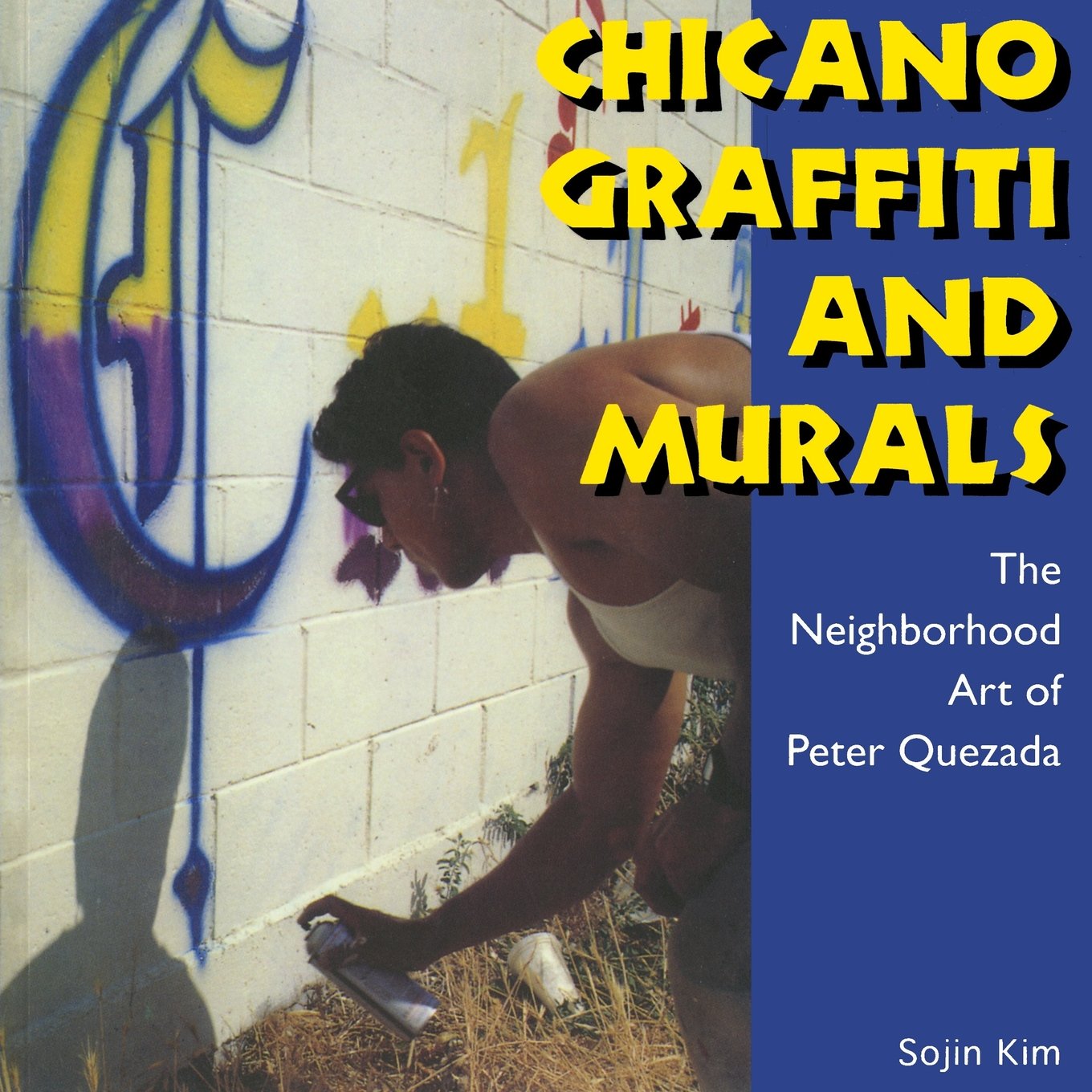 His work is described and analysed in> Sojin, Kim: Vital Signs. (Ph. D. diss.) UCLA 1997.
His work is described and analysed in> Sojin, Kim: Vital Signs. (Ph. D. diss.) UCLA 1997.
Quick (TTP) 1) A spray paint brand with good qualities, popular in Europe. Some other good brands are Montana, Sparvar and Belton.
Quik (TTP) 2) (Linwood A. Felton) * 1958 Writer from Queens who lived in
 Holland during most of the 1990s. Known for train pieces, but also for exhibited art work. Some of his strongest canvases have a cultural and political theme, such as “Out to Dry” (1982),”Ive got a problem” (1986 ) and “Black men creating Art History!” (1989). He is still active today!
Holland during most of the 1990s. Known for train pieces, but also for exhibited art work. Some of his strongest canvases have a cultural and political theme, such as “Out to Dry” (1982),”Ive got a problem” (1986 ) and “Black men creating Art History!” (1989). He is still active today!

R.I.P (TTP) Short for Rest In Piece, or in latin Requiescant In Pace.This motive in respect of a dead friend is old in TTP, but 1n the 1990:s it also became a genre of its own between folk art and TTP, the “Spraycan Memorials”, and took over the market the galleries no longer catered. These paintings have the dead persons portrait as the central motif, and they are paid for by the relatives. It is done right on the street, on a housefront or a wall, and is decorated with flowers and candles like an outdoor altar or a street memorial. It also witnesses the endless violence, drug-abuse, misery and unjustice of the brutal late-modern capitalist urban life. Lit: Cooper, Martha & Sciorra, Joseph: R.I.P. New York Spraycan Memorials. T&H, London 1994. 96 p. Ill.
Rack (TTP) Racking is to shoplift paint, and this was common in the early days. As opposed to what is usually thought this is not the only way writers get their paint – most paint is paid for in a store with low prices or with discount directly from the producer. Usually writers save cans given to them as payment for commissioned jobs and use them later on for piecing. In Denver, Colorado among other places paint stealing is almost unknown » Ferrell, Jeff
Rammellzee (TTP) (1960-2010). Known as the theorist of Aerosol Art, for
 transgressing the boundaries of this art form with material experiments and for his never-ending-drawings. Rammellzee’s “Manifesto” was written 1979 and published in new editions in the catalogue “Ramm-ell-zee”, Gemeente Museum Helmond, The Netherlands 1986 and partly also in the essential interview by Edith de Ak in Art Forum, May 1983, p. 88-93 called Train as Book, Letter as Tank, Character as Dimension. His theory on “Iconoclastic Panzerism” stresses the symbolic (instead of the phonetic) contents of the
transgressing the boundaries of this art form with material experiments and for his never-ending-drawings. Rammellzee’s “Manifesto” was written 1979 and published in new editions in the catalogue “Ramm-ell-zee”, Gemeente Museum Helmond, The Netherlands 1986 and partly also in the essential interview by Edith de Ak in Art Forum, May 1983, p. 88-93 called Train as Book, Letter as Tank, Character as Dimension. His theory on “Iconoclastic Panzerism” stresses the symbolic (instead of the phonetic) contents of the
letter sign, and discusses, among other things, the “personalities” of letters. His art work  practice is very broad: he made science-fiction like motifs, futuristic costumes (The Costume, 1987/1992) and bizarre sculptures, (Untitled, 1988) as well as experimental paintings (Sigma is Coming, 1983; Zen Shock, 1985) and enormous, horizontal drawings (Hell, the Finance Field Wars, 1979-) He has invented a kind of artistic cosmos of his own. And he let the language itself into the artistic process – which can be experienced in his interviews, which are very lyrical and poetic. He eventually got damaged by the extensive use of heavy resins and toxic chemicals in his work. All writers did not recognize him (he did no trains as the likeways abstract Futura did, he did only canvas work and not primarily with spray paint, etc.) But he did so many other things inside the hiphop
practice is very broad: he made science-fiction like motifs, futuristic costumes (The Costume, 1987/1992) and bizarre sculptures, (Untitled, 1988) as well as experimental paintings (Sigma is Coming, 1983; Zen Shock, 1985) and enormous, horizontal drawings (Hell, the Finance Field Wars, 1979-) He has invented a kind of artistic cosmos of his own. And he let the language itself into the artistic process – which can be experienced in his interviews, which are very lyrical and poetic. He eventually got damaged by the extensive use of heavy resins and toxic chemicals in his work. All writers did not recognize him (he did no trains as the likeways abstract Futura did, he did only canvas work and not primarily with spray paint, etc.) But he did so many other things inside the hiphop  culture (he had a huge discography) and
culture (he had a huge discography) and among those who did recognize him he was seen as the most original of them all: Art and life as one unit, to the end. Quote: “Humans…in the 14th Century the monks ornamented and illustrated the manuscripts of letters. In the 21st and 22nd century the letters of the alphabet through competition are now armamented for letter racing and galactic battles. This was made possible by a secret equation known as THE RAMM:ELL:ZEE.”
Rak, Natalia (SA) *1986, Polish Street Art contemporary painter, famous e.g. for the wall painting ”The Legend of Giants”, 2013 (below). She appears to be a gifted artist. When displaying e.g. a wasp she don´t forget the microscopic hairs on its back; everything is very exact and in control. Active world wide. https://www.facebook.com/ArtNataliaRak/

Ransom (TTP) (Philip Ransome) Australian writer, known for piecing and catchy freestyle canvas work, as in the “Adrenalin” exhibition at the City Gallery, Melbourne 1988.
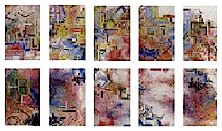
Read, H.W. (TG) Read was a linguist, and his pioneering work, using the term “Folk Epigraphs”, a classic in the TG-field , was printed privately in Paris 1935 with a “restricted circulation”. Maledicta reprinted it in 1977. Lit.:Read, Allen Walker: Lexical Evidence from Folk Epigraphy in Western North America: A Glossarial Study of the Low Elements in the English Language. Olympic Press, Paris 1935. Reprint: Classic American Graffiti. Maledicta, Waukesha 1977. 83 p.
Reception (TTP) see: the» public opinion (on TG and TTP).
Reclaim the City / Reclaim the Streets (TTP) Since the late 1990s there has been a spontaneous movement among young people in great urban areas: Reclaim the City. In both the USA and in Europe those street-parties with trance-music, hip hop, graffiti painting and anarcho-winged politics gathered lots of people to occupy the street and liberate it from its alienated commercial use. In London (1999) and Stockholm (2000) thousands of loosely organised activists joined this urban carnival. The idea is to take back and renew the use of the public space and the urban environment. In Stockholm one of those parties called ”Graffiti Triumph” called attention to the > Zero Tolerance state repression against youth culture and art prior to 2014. Graffiti Triumph by > Zappo, photo courtesy Pelle Sten/Yelah can be seen in the end of this dictionary.
Reisner, Robert (TG) The contemporary common use of the word “graffiti” was an effect of Robert Reisner ́s books and media performances on TG in the late 1960:s. He popularised the theme and gave it an air of cultural entertanment. Litt.: Reisner, Robert: Graffiti – Selected Scrawls from Bathroom Walls. Parallax Publ. Co. Inc. , N.Y. 1967. 64 p. ; Reisner, Robert: Great Wall Writing and Button Graffiti. Conyon, N.Y. 1967. 159 p. ; Reisner, Robert: Graffiti. Two Thousand Years of Wall Writing. Cowles, N.Y. 1971. 204 p. ; Reisner, Robert: Encyclopaedia of Graffiti. Macmillan, N.Y. 1974. 401 p.
Rens (TTP) Contemporary Danish writer, one of the most skilled and active ones on the old school scene.
Rep (TTP) Short for Reputation.
Repello This is English for a graffiti prevention product originally invented by a Swedish professor of Chemistry in Lund, Sigfrid Svensson. The original label on this product is PSS 20. It is made out of a Polysugar solution, found on water organisms. As a powder it can be mixed with water to a clear and non-poisonous solution and applied on the wall. Spray- or marker colour painted on this surface could then very easily be washed away with plain water. There are many other chemical prevention methods, but this is probably the least harmful one, both to humans and to the wall. Valuable and historic buildings could be protected like this, but with care: a layer of any kind covering the house front is risky for the “health” of the building. For other, more long term and maybe also better strategies, see > Graffiti Prevention.
Respect (TTP) Respect means that you look up to older and more experienced writers, as the Old School Kings, and honour them for what they have achieved. It does not necessarily mean a strict hierarchy and despising for >“toys”, as all writers, even the best, were toys in the beginning.
Rhyme (TTP) One of the most active Dutch writers, notoriuos on trains, a good styler (and a very nice person, too). Below: window-down piece in London 1988.

Rib 161 (TTP) Oldschool N.Y.-writer, original member of the» NOGA
Riff 70 (TTP) Known for early T-2-B:s in N.Y. According to Part 1, N.Y., he also could have been involved in the formation of the»Wildstyle lettering. See also »Sir, »Hondo.
Rig (TTP) Finnish writer who, according to Monmagnon (1995) in the turbulent year of 1991 made the first window-down piece on the long distance train from Helsinki to Moscow, telling that “Rig whishes long live to Gorba & Jeltsin.” Lit.: Monmagnon, Olivier: Sabotage. Ed. Florent-Massot, Paris 1995. Chapt. “Long distance trains”.
Romance (TTP) Danish writer with a typical Danish charm and kindness in his pictorial motifs, a very good styler too, inventor of the “pipe style”.

Russia (TG) see> Bushnell (on soccer graffiti in Moscow). Scrawlings by the Russian Red Army from the end of WW2 could be seen in the German Parliament Building in Berlin. M.N. Sokolov wrote an broad article on graffiti in the art magazine Dekorativnoe Iskusstvo in issue 12, 1988.
(TTP) Russia, The hiphop movement in Russia has been growing since the mid-1990s. The graffiti scene started to take off in the millenium shift. The Moby Crew involves all aspects and even presents themselves on the Internet. The first graffiti/hiphop magazine from Russia, Freestyle, was published in 2001.
Rustoleum A paint brand from the US that is known for its opacity. > Can.
Saber is most famous for an exceptionally large piece he did on the concrete bank of the Los Angeles River in 1997. The full color piece took 97 gallons of paint and 35 nights spread out over the course of a year to complete. The final work, measuring 250 x 55 feet (76 x 17 meter) has been called ”the largest graffiti painting ever made by one and the same individual”. The work was viewable from satellite. Below: detail from LA River courtesy Saber at Wikimedia Commons.

SAMO Early tag by > Jean-Michel Basquiai who later nade a Fine Arts career.
Seen, ”King of the Kings”. Seen, born in 1961, Richard Mirando, is one of the most famous graffiti artists in the United States. He started when he was 11 years old in New York in 1973 and his production is probably the largest of its  kind. The name ”Seen” means ”been seen” and he has certainly become that. It can also be pronounced ”scene”. He had King status on the trains at the IRT line 1979-1982, 1981-1984 also a large number of gallery exhibitions including three separately. In 1986 he painted his name on ”The Hollywood Sign”. After the 1980s, he also became known as a tattoo artist. Unlike many other successful graffiti artists, he has not lost touch with the street and the roots, and he is particularly regarded in the light of his productivity as ”King of the Kings”.
kind. The name ”Seen” means ”been seen” and he has certainly become that. It can also be pronounced ”scene”. He had King status on the trains at the IRT line 1979-1982, 1981-1984 also a large number of gallery exhibitions including three separately. In 1986 he painted his name on ”The Hollywood Sign”. After the 1980s, he also became known as a tattoo artist. Unlike many other successful graffiti artists, he has not lost touch with the street and the roots, and he is particularly regarded in the light of his productivity as ”King of the Kings”.
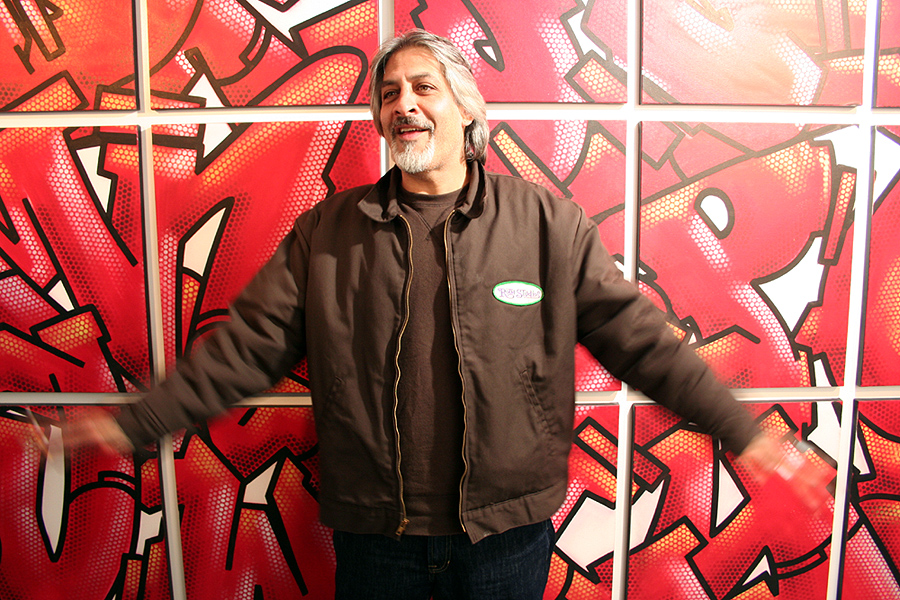
He entered the yards at nine years age, and did his first train piece 1973, 11 years old, “SEEN” in red and yellow. And he kept this ingenious name ever since . King of the IRT Line 6 1979-1982, 1981-1984 3 one man gallery shows and 6 collective shows. 1987 he paints his name on “the Hollywood Sign”.Thousands and thousands of train pieces have been done during those more than 25 years now. And books, films,T-shirts, > tattoos.… He has done it all, in terms of production he is King of the Kings, but still he continues to be a real writer in contact with the street. He did look like a friendly kind of pirate chieftain when he, Lady Pink and others visited the “Subcult” convention in Copenhagen. eenworld.com/html/main.ht
Stahl, Johannes: Art Historan in Köln. Graffiti: zwischen Alltag und Ästhetik.. Scaneg, München 1990 was probobly the first doctoral diss. of its knd. His concept in shoert is that aerosol art is a estetisation of every day life graffit. Lots of unknown historcal pictures are discussed. This work was followed by an exhibition and the anthology Stahl, Johannes (ed): An der Wand. Graffiti zwischen Galleri und Anarki, Dumont, Köln 1989. Se also: Neue Spraybilder aus New York, Konstforum 91/1987, p. 327-331. Haring and> Basquiet stood in close contact with the TTP-scene of the early 1980:s in N.Y., they even did some murals together with writers.
Sketch (TTP). The sketch origins in the blackbook, and is kept in the left hand with the spray can in the right when magnifying it on the wall. Below ”Still Heavens Only Force” to be compared with the finished painting, see ”Highway”. Courtesy Andrés Almqvist,

Schmidlapp (TTP) The founder of > I.G. Times.
Scratchiti (TG) To scratch is the original meaning of the italian word graffiti. During many thousand years knifes or similar sharp tools were normally used, applied to any hard or soft surface: trees, churches, furnitures, plastered housefronts. The special method to scratch messeges and poetry on windows was common in England already 1731, when the pseudonym > Hurlo-Trumbo made a book based on window-scratchings done with diamond ring – later called ”scratchiti”. Lit: see: > Hurlo-Trumbo.
Scratchiti (TTP) Though, the use to tag windows by scratching with a sharp tool is a late phenomena in TTP; in Sweden it began in the late 90`s as an eskalation of the war the autorities had declared on the writers. (see> ”trashing”.Internationally, RP3 and J ROC were kings at the F-line in 1998. A broad range of tools are used in te implementation of scratchiti: lava rocks, emery boards, knives and most commonly keys.Scribbling (TG) )(scrawling and scribble-scrabble) is a word that could be properly used to mention the motoric drawing development of the childs 1:st – 3:rd year (as described by Kellogg a.o.) The German word is Kritzelei, it. Gofferia, lat. Scariphare, sw. Klotter. If it is used to refer to an adult or young persons activities it will be a pejorative, meaning writing/drawing slobby and hasty. In the USA the word “graffiti” seems to have about the same value and negative ring to it, but for Europeans “graffiti” is more neutral, and certainly not an insult. Anyhow, the best terms in a scientific context or on a more sophisticated level are probably those used in this dictionary: TG for ”graffiti” and TTP for ”Aerosol Art”. See also>Doodle.
Sell-out (TTP) Is an expression that means unacceptable compromises, for instance commercialising an art form that is no commodity and has no price.TTP is not about money!Lit.: related discussion in Deen One: So what is a REAL writer? Skills Magazine, Boston MA, issue 5, 1993, p. 17.
Shark (TTP) member of the >FBI crew.

Shoe (TTP) Dutch writer, one of the first (since 1983), most active and according to>Mode 2 also “one of the two writers (the other being Bando) who really invented new styles (in Europe)”.>Bear 167 was his mentor. Member of the> CIA. Below: early piece (1985) .

Sign-painting (SA) In Africa sign-painting has become a public art form in urban areas, with an ethnic/commercial style of its own. In the western world sign-painting could even be a Aerosol Art comissional job.Simon & Garfunkel wrote those prophetic words in 1966:”And the words of the prophets are written on the subway walls”. (The Sounds of Silence, Columbia Records 1966).
Sir (TTP) One candidate for the first T-2-B, or at least a very early one in 1972, according to > Jack Stewart. See also> Hondo.
SJK 171 (TTP) Oldschool N.Y. writer, original member of the>UGA
Ske (TTP) Skilled writer with original, crazy and well-executed pieces, living in Puerto Rico, USA. This islands’ writers were 1991 painting in the Bronx HoF. Below: ©Ske, Bik, Cope2, Cern, Noe2, Tkid, Eaz, Ewok in Bronx / Art Crimes.

Skize (TTP) Graphic artist; former member of The Totalizers Crew, Sweden. Still very active today. One of the very best. Below: Drawing (left), Collection of Mushrooms (right), backpiece (bottom).
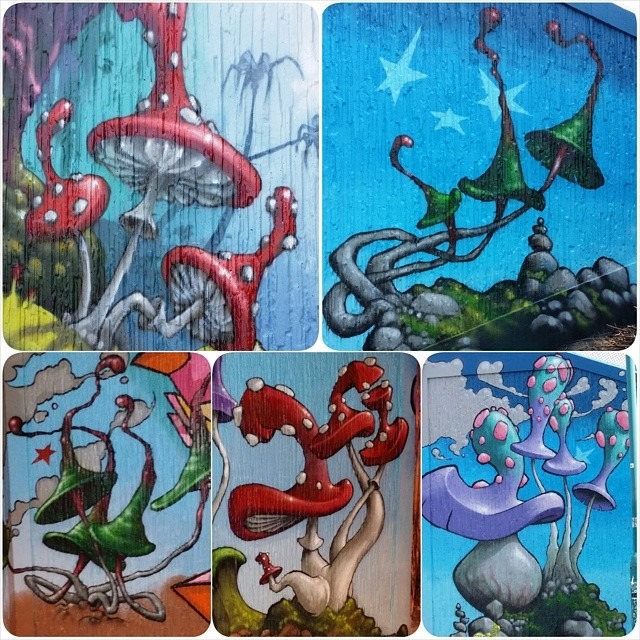
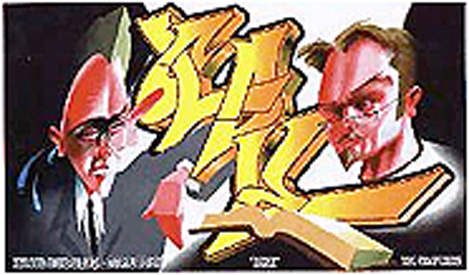
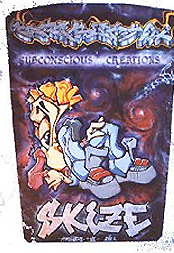
Skki (TTP) )> BBC> Politics and TTP Below: Exhibition artwork by Skki.

Sky, graffiti in the (TG) According to Bill Adler “an American skywriter with some ‘ink’ left over from a job avenged himself upon his grade school arithmetic teacher by smoking a huge 1+4 = 6 across the skies.” The place and date of the event is not mentioned, but this was a graffiti-like skywriting. A well known conventional skywriting was done in October 9, 1980, John Lennons ́ 40th birthday a plane hired by Yoko Ono wrote the message ”Happy Birthday John + Sean / Love Yoko” nine times in the sky above Manhattan. Lit.: Adler, Bill: Graffiti. Pyramid Books, N.Y. 1967, p. 11 ; Lennon, John: Skywriting by word of mouth. (1986) Bakhåll, Lund 1999.
Snake 1 (TTP) Oldschool N.Y.-writer, original member of the>UGA
Snow, graffiti in the (TG) An anecdotic evidence appears in Adler, Bill: Graffiti. Pyramid Books, N.Y. 1967, p. 11. It says that “a great-spirited Alaskan whose lands lay directly below the flight route of a major passenger aitline plowed a monstrous for-letter obscenity in the snow for all to see.” The place and date of the event is not mentioned. Another trivial graffiti form is done with fingers in the sand on the shore, in the dust or in a similar material.
Social background of the writers (TTP) In the USA. Most people agree that writers are young and predominantly male. Another usual statement is that Afro-American and Puertorican kids sets a great part, and that some of them comes from the urban ghetto or other tough circumstances (Lachmann 1988). But Feiner/Klein (1982) and Cooper/Chalfant (1984) claims that “writers come from all economic and social backgrounds”, so do several later surveys.2) In Europe. If there is an Afro-American and Puertorican influence in the USA, there is also an influence of immigrant youths in the European TTP movement. The average age is about the same – 16 years- , so is the male dominance. The social background seems to even more incorporate middle-class kids (Skyum-Nielsen 1987) with no specific drugs- or criminality patterns. Paris Tonkar (Yakhlef / Doriath 1991) says:
“Il faut savoir qu’un tageur n’est pas nécessairement ‘un adolescent de la zone’ mais peut-étre égelement fils de journaliste, de banqire, de ministre.”
In Sweden. 45 writers from Uppsala were studied inrelation to family, schooling, work, spare-time, friends, interests and TTP-activities by Jacobson (1996).Circumstances emerge that indicate that the practitioners of TTP graffiti are fairly ordinary but unusually creative young people. For instance, the group has the same average grades as other pupils in the same year. In Art, however, their average grade is significantly higher than among other pupils. 42% of them had artists in the family, and generally they were planning to choose an artistic career. On an average, the young people in the investigation had produced 20 “lawful” paintings, a slightly higher number of pieces and a very large number of tags. The predominant spare-time occupations were sitting at home sketching and being with friends. 63% had parents with skilled or professional jobs. 55% were born in Sweden, 45% in another country. 91% were boys, 9% were girls and the average age was sixteen. 36% lived in one-parent families, as compared to about 19% among other young people. Nobody in the group had been sentenced to prison or had any convictions for serious crimes; their offences were most often connected with graffiti. There was in general no clear information on drugs, nor any alarming evidence. Thus the profile that is given by the average painter in the investigation does not coincide with the image certain mass media and authorities give them as hardened young criminals. Their own social network, which appears to be at the same time hierarchic and democratic, includes a sort of “in-house” training,(> social carrier) and the idea that TTP is a kind of > learning process is confirmed by interviews. Diagram below from “45 Swedish writers” 1991 in Jacobson, Staffan 1996.

Social carrier (TTP) in the writing group subculture by Jacobson aa (1996).
TOYS-TAGGING, BITING, LEARNING BY OTHERS-CREATING A BLACKBOOK-“APPRENTICE” RACKING COLOUR.- ENTER THESUBCULTURE VIA HIP-HOP.-VINCREASING SKILLS UNDER CONCURRENCE. MAKING PIECES.-CREWS, BEGINS “DOING TRAINS”.- GRAFFITI “JOURNEYMAN” -HOME-BOYS AS LIFESTYLE. SPECIALIZATION -(CHARACTERS, LETTERS) -ORIGINALITY, MAKING TRENDS- KING -BURNERS,WHOLE-CARS.- MAKE A “REP”. OFFERED COMMISSIONS. – “MASTER” ESTABLISHED LEGAL ACTIVITY- POST- EXHIBIT AND SELL OF GRAFFITIART ON CANVAS – OTHER ADJOINING FREE GRAFFITI CREATIVE ACTIVITY- DRIVE APART FROM THE SUBCULTUREOR – OR CONTINUE PAINTING ILLEGAL – ARTIST.
Spade and Raide (TTP) Two well known and respected Norwegian writers, piecing in Oslo, Bergen and Kristiansand, who took part in the international contest in Bridlington, England 1989 and also cooperated with the Swedish> AIO in the 1990:s. See also>Fat Cap
Sparvar (TTP) A French high quality spray paint brand.
Spraycan (TTP) As a motif in TTP, the spraycan is an icon of itself, representing TTP even in another context. First, it was painted realistically, then stylised with a speed feeling, and so anthropomorphic with legs, bones and face. Writers sometimes prefere to replace a letter in the piece, e.g. the letter “I”, with a spraycan. > Technique. > Can > Spraycan Art > > Airbrush.
Stahl, Johannes * 1958. Dr. Johannes Stahl from Köln in Germany did his doctoral dissertation in Art History on “Graffiti: zwischen Alltag und Ästetik” 1989, and it was published the year after. The first of its kind in Europe, this is a very ambitious and comprehensive study, and it contains many interesting aspects of the early traditional graffitis’ art history, TTP and above all of> Harald Naegeli. t also holds a theory of aerosol art as aesteticized graffiti. Lit.: Stahl, Johannes: Graffiti: zwischen Alltag und Ästhetik.. Scaneg, München 1990. This work was followed by an exhibition and the anthology Stahl, Johannes (ed): An der Wand. Graffiti zwischen Galleri und Anarki, Dumont, Köln 1989. Se also: Neue Spraybilder aus New York, Konstforum 91/1987, p. 327-331.
Stan 153 (TTP) Oldschool N.Y.-writer, original member of the> NOGA
Stay High 149 (TTP) Early New York writer veteran, who used “The Saint” stick figure from the Simon Templar TV program, sometimes also smoking a joint, to illustrate his signature. https://www.wikiart.org/en/stay-high-149
Stencil graffiti, serigraffiti or pochoir (TTP) Seems to appear on a wider scale in Paris, mid-1980:s, and soon thereafter in Berlin and New York. It is usually executed by academic trained artists, albeit this is an illegal art form. The “stencil” could be either negative or positive, and it is commonly cut out in cardboard, plastic or metal to leave a pattern, a text or a picture on the wall, sometimes repeated and varied; it is set tight up on the wall and held steadily while spray painted. Well known stencil artist are Blek le Rat in France, Die Bananen Sprayer in Germany and John Fekner in USA, but there are hundreds of others major or minor stencil artists too. This was the early beginnings of the now wide spread Street Art.
Lit.: Huber, Joerg: Serigraffitis. Hazan, Paris 1986. and Robinson, David: SoHo Walls. T&H, N.Y. 1990.
Stewart, Jack (TTP) Jack Stewart, painter and art historian in New York, has been stationed close to the sources of the TTP which he studied from the very beginning. He could therefore rely on his own photographs of early T- 2-B:s and original interviewes with Taki and others for his huge dissertation Stewart, Jack: “Subway Graffiti. An Easthetic Study of Graffiti at the Subway System of New York City, 1970-1978.” New York University, New York 1989. The study includes a comparision between traditional graffiti and TTP, investigating the significance of the differences; a careful stylistic analyze of the pieces and an impressive listing of the writers names. The first American dissertation of its kind and a milestone in graffiti research. Below: Jack Stewart: The Brain Painting, mixed media, 53”x47”, 1990. Collection of Rodman Townsend, Knoxville, TN.

Stewart, Michael (TTP) In October 1983, 25 year old Michael Stewart was arrested by the police for spray painting and then brought to the hospital.14 days later he died from his injuries ; demonstrations and protests against police brutality followed.
Stitch 1 (TTP) Oldschool N.Y.-writer, original member of the>UGA Stitch 1 (TTP) UGA.
Stone Age Kids (TTP) German contemporary crew. See also>AIW
Straight Letters (TTP) Straight Letters or Block Busters (“normal” letters) is the easiest style, good for beginners as it is simple to do, and for advertising jobs because the customers can be able to read it. To use this letter style and get respect it must be etremely big and technically perfect. The other major style is>Wildstyle.
Street Art This concept brings together many different semi-illegal art forms, and what they have in common is the urban public space, always outdoors and never indoors. Its origin probably goes many decades back, but will be visible in our time f.i. by the May revolt 1968 with the illegal posters of the Atelier Popular. Robert Sommer used ”Street Art” 1975 to describe ”neighbourhood art” : brigade paintings and murals by local people. TG and TTP graffiti are from time to time included, and in Allen Schwartzmanns book 1985 there is also illegal stencil art by professional artists, posters, billboard sabotage and illegal three dimensional art forms. Even Chicano art, stickers, self made shop signs and house front decorations could be ”Street Art”. Official public art, commercial advertising, gallery art and similar are excluded from this phenomena.
As a movement Street Art became known in the early 1980s in Paris, New York and Berlin. Some important early names are >Blek le Rat, >Harald Naegelli, >Richard Hambleton and >John Fekner. In Paris the artists call stencil art ”pochoir”, in New York its called serigraffiti and filled SoHo’s walls as a result of the cooperation between young artists from the School of Visual Arts and graffiti writers, in Berlin there were lots of illegal posters, spray drawings and stencils in Kreuzberg and on the Mauer. In Manhattans Lower East and SoHo you could see voluntary made mosaic decorations on lamp post and ”sculpture gardens” made out of metallic garbage. In 1990s Sweden >Akay is one of the graffiti writers turning to Street Art to renew it. Today, British anonymous artist Banksy got a worldwide fame with his intelligent visual criticism of capitalist society. Below: ”Life is beutiful” by Banksy.

Lit: Sommer, Robert: Street Art. 1975; Schwartzmann, Allen: Street Art. 1985. ; Huber, Jorg: Serigraffitis. Hazan, Paris 1986. ; Robinson, David: SoHo Walls.T&H, N.Y. 1990. A sample of contemporary street art posters:http://www.algonet.se/~loesje/PDF/nov00/900.pdf ; Banksy: Exit by the giftshop.
Style Only Workgroup (TTP) The German writers Scum, Cheech H 2569 and Techno 169 are experimenting on the edge of aerosol avantgarde 3D-style. The exhibition and the book ”A Tribute to Style” (curator Astrid Weindl) pose the theory of style together with other skilled outline designers all around the world. Watch out, here they go! See also> FBI http://www.styleonly.com/
Style, the concept of (TTP) The concept of style is crucial in TTP – in opposite to most TG. “Style” is used in one or several of those aspects:
1) Individual style: the persons manner, fashion, ductus 2) Collective style: group of style, genre, school 3) General ability of shaping.
Stylistic development (TTP) In the beginning of the 1970s there were four distinct style groups in New York piecing, partly named after city districts. In the latter part of the 1970s there were about 30 different styles, culminating in a“style war” in c:a 1977. Only two kinds of letter shaping survived: Straight Letters and Wildstyle. (Bubble-letters e.g became unmodern but is sometimes still used in throw-ups.) Out of those two style main groups personal variants were made, from the early 1980 in the galleries and in the mid-80s also in the rest of the Western world. The development of the style of TTP goes in general terms from soft, round and connecting letters in the 1970s to hard, sharp and disconnected letters in the 1980s and 90s. This could be compared with (but not related to) the hippie-style in the late 1960s vs. the punk-style in the late 1970s, and with the trends of industrial design in the same period; they show similarity. There could be a social, economic and structural reason for this, presupposing that those changes could be generalized both in the USA and in Europe. But more obvious are the technical, individual and style group progress, (see:> technique, > style) which after a few intense years led to a style which was overloaded; to get forward it has to restart and get back to basics with a new simplicity. Or a new individuality. If one put the serial examples of Phase II, Core and Blind after each other, it could be seen as a 10-year cycles. See also> Chronological events.
Submarin (TTP), piece on, see OTR 3. c.a 1993. The latest piece on a submarin (2013) was executed in the Amsterdam Harbor on both sides (pictures below). No other details are known, except for the photographic evidences here.


Subvertising (TG) Subversion of commercials, billboard ads, posters and signs. To rearrange or change the meaning of the official messageby adding or excluding letters or words. This technique was used by the French > I.S. movement (Détournement) and is today a widespread illegal public urban art form. Lit.: René Vienet; IS No 11, 1967. Net sites on anti-tobacco-ads etc:
http://adbusters.org/spoofads/index.html http://www.billboardliberation.com/home.html
Subway Art > Cooper> Chalfant
Super Kool 223 (TTP) Made the 1:st TTP Masterpiece ever; in N.Y.1972 in the  221:st Street train yard: the letters “Super Kool” in yellow and pink with a> fat cap adapted to the spray can – which was also his own invention. Before Super Kool there was nothing like this, so this was the starting point for a totally new era in the history of TTP (and in > Art). On> UGA’s 1:st exh. at City College 1972, Super Kool told the reviewer that “We’ve made the biggest art movement ever to hit New York.” Lit.: Shirey, David: Semi-Retired Scrawlers of Graffiti. International Herald Tribune, Dec 14, 1972, p.7.
221:st Street train yard: the letters “Super Kool” in yellow and pink with a> fat cap adapted to the spray can – which was also his own invention. Before Super Kool there was nothing like this, so this was the starting point for a totally new era in the history of TTP (and in > Art). On> UGA’s 1:st exh. at City College 1972, Super Kool told the reviewer that “We’ve made the biggest art movement ever to hit New York.” Lit.: Shirey, David: Semi-Retired Scrawlers of Graffiti. International Herald Tribune, Dec 14, 1972, p.7.
Swan King of Tagging for a rather brief period of time in Lund, Sweden.
Swedes wrote this on the lion (TG) or, “Svear anbragte detta på lejonet”, was 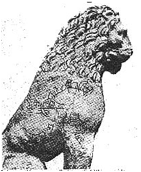 scratched with runes c:a 1000 A.D. by Swedish Vikings on a marble lion from Pireus in Greece. The lion was 1687 taken as a war trofé and moved to the Arsenal in Venice, where it still remains. The runes were discovered by the egyptologist J.D. Åkerblad. A copy is sited at the Museum of History in Stockholm. Those vikings from Uppland in Sweden (the runic style is typical of that location) were probably serving the emperor of Constantinople as ”bodyguards” and wrote this graffiti in their spare time.
scratched with runes c:a 1000 A.D. by Swedish Vikings on a marble lion from Pireus in Greece. The lion was 1687 taken as a war trofé and moved to the Arsenal in Venice, where it still remains. The runes were discovered by the egyptologist J.D. Åkerblad. A copy is sited at the Museum of History in Stockholm. Those vikings from Uppland in Sweden (the runic style is typical of that location) were probably serving the emperor of Constantinople as ”bodyguards” and wrote this graffiti in their spare time.
Lit.: NST Dec. 5, 1977. and Jansson, Sven B.F.: Runinskrifter i Sverige. AW, 1984, p. 66.
Swet (TTP) Danish writer, notorious and with a swinging vivacity in his wildstyle (1993).

Symbols in TTP (TTP) Besides letters, figures and characters of humans, animals and monsters, selected symbols are used in TTP-graffiti. One of the most common symbols is the crown for claiming King-status, according to Jack Stewart the crown appeared as early as 1966. The same goes for the arrow, which in the late 1970s also became an important part of the Wildstyle concept, marking speed, power and direction for the piece. Every writer had his or her own shape of this symbol. The dollar $ sign could be used as in the comics, for greed or for economic success, and the attributes of the stick-figure “The Saint” were also adopted by > Stay High 149, sometimes with a joint as “The Joint-Man”. The Statue of Liberty is a common symbol in pieces, painted in a sarcastic way or as a salute to Americanism (there is a certain ambivalence here). The copyright sign © could be used at the bottom of the piece against “biting”. Old signs as the cross (even turned up side down), the heart (one of the oldest ideograms of all), the dead man’s skull and stars in different shapes also were used. Some of those symbols could also be found in> tattoo art. Symbols with political meaning, as the A inscribed in a circle for >Anarchism and the >Peace sign , formerly used by the anti-nuclear weapon movement, could be seen. The> eye carries a battery of meanings and connotations, such as the artists ability to see and his/her demand to be seen. Over-dimensioned watches speak of the writer-saying “What time is it?”, which means “What ́s up?”. But the alltime symbol in TTP is of course the spray can itself. In the early days the cans were painted naturalistic, but soon you could find a “speeded up” variant, bent by the action, and then “the spray can man”, that is, an anthropomorphic can with a face, arms and legs. Sometimes writers like to change a letter in the piece, as an “I”, to a spray can. In that way, anyhow, the spray can became the true emblem of this art form. See also>Motifs in TTP.
Lit.: Jacobson 1996 aa, p. 126-128ff.
Tag (TTP) A tag is a monochrome, quite small, carefully elaborated, codified signature, usually 3-4 letters perhaps with a number added, which has some calligraphic and stylistic qualities. It is applied with marker or spray paint on public places, and it is either a simple sign of presence or a demonstration in quantity and speed. It is also the writer’s logo, and could be used as such in a> piece.

Taki 183 (TTP) In July 21, 1971 an article appeared on page 37 in The New York Times which began: “TAKI 183 SPAWN PEN PALS.
 Taki is a Manhattan teenager who writes his name and his street number everywhere he goes. He says it >s something he just has to do. His TAKI 183 appears in subway stations and inside subway cars all over the city, on walls along Broadway, at Kennedy International Airport, inNew Jersey, Connecticut, upstate New York and other places.—”
Taki is a Manhattan teenager who writes his name and his street number everywhere he goes. He says it >s something he just has to do. His TAKI 183 appears in subway stations and inside subway cars all over the city, on walls along Broadway, at Kennedy International Airport, inNew Jersey, Connecticut, upstate New York and other places.—”
The article also contains a photo of Taki ́s doorstep, covered with tags. His real name was Demitrius, and Taki was the Greek diminutive.When he worked as a messenger he rode the subway to all parts of the city, where he wrote his  name.
name.
This became a kind of new game among his peers, and after the N.Y. Times article was published, this new competitive habit spread to hundreds and thousands of the citiy’s youngsters. And the fun began! Or the plague, as others may say.
Tat’s Cru. Bio is known as a true master of New York style painting. Wilfredo ”Bio” Feliciano is also a founding member of the world-famous art collective known as Tats Cru ”The Mural Kings” originally known as TAT Cru founded by Brim, Mack and Bio in the eighties. The 156 crew in Europe is a similar constallation.

Tattoos The tattoo is, like other kinds of body art and decoration, as old as humanity itself and common among most ethnic groups. In Japan tattoos have a long and famous tradition. But the introduction in Europe, in the 1700s, came when captain James Cook took a Polynesian native gentleman with tatau on his body along with him to England. There are several techniques, but the most common is done with needles, by hand or later with a rebuilt electric razor. For many decades tattoos were a subcultural thing used by sailors, criminals or prostitutes, and the motifs were quite limited: hearts, crosses, pin-up girls, ships and names. But as it got more common it also became more respected, and the attraction (as well as the commercial potential) was enormous.The new wave began in San Francisco, and in the late 1900s it was rapidly spread among new groups in society; the tattoo fashion became mainstream. In the 2000s it is a respected profession and the motifs are broader and often highly aesthetic, too. Many writers have made it in this business, such as> Seen in N.Y and> Circle in Stockholm; apparently there are connections between the two art forms, and writers often get tattooed – in graffiti style!
Lit.: Oetterman, Stephan: Tecken på huden. Tatueringens europeiska historia. Symposion, Sthlm 1984. 147 p. b/w ill. on history ; Grognard, Catherine:/ Lazi, Claudio: The Tatoo. Sunburst Books, London 1994. 131 p. Ill. , Tattoo Review and similar magazines on contemporary tattoo art. Below: Photo courtesy APKPure.com.

TBC (TTP) The Bohemian Cavalry, San Francisco crew of the 1990s. Some famous crews in S.F. are TDK, TWS (see > Psycho City), TMF and not the least The LORDS, with more than 40 members worldwide.
TCA (TTP) The Chrome Angelz, Paris crew started in March 1987.> Mode 2, > Bando.
TDC (TTP) The Diamond Crew, early finnish crew from Helsinki in the mid-1980s. In 1989 Finnish television showed a documentary by P. Pitkänen on TDC.
Technique of the spray can (TTP) It ́s tricky! The spray can is in fact a primitive tool, aimed for quite other purposes than artwork. If the amateur draws a line with the spray can, it will be unsteady, dripping and very fat out of control. The writer can do extremely small and thin, razor-sharp and very exact details with the same can thanks to a self-taught technique and diligence. There are (at least) four aspects of this technique:
* The type of cap ( as fat, skinny, normal) applied to the can. * The distance to the surface. * The pressure on the cap. * The horizontal-vertical position and angle of the can.
By combining those different tricks the writer can achieve almost anything.
Territorial Graffiti (TG) Territorial graffiti is known historically from e.g. rock carvings on the Pacific islands where it tags out economic areas. In Philadelphia, there has been gang-tagging since the 1850:s (Smart, James: Gangs Wrote Their Names On Philadelphia Walls in 1850 >s. Evening Bulletin, Philadelphia, Jan 12, 1973, p. G3.) > Ley & Cybriwsky wrote the famous study on contemporary territorial graffiti in Philadelphia, where ethnic and social tensions where marked out by graffiti at the street corners, made by gangs to declare their turf. Out of this environment came the pioneer> Cornbread with the new, linear graffiti c: 1967.
Lit.: Ley, David & Cybriwsky, Roman: Urban Graffiti as Territorial Markers. Annals of the Association of American Geographers, Vol. 64, nr 4/1974, p.491-505.
TF5 (TTP) > The Fabulous Five.
TGO crew > Hex
The Faith of Graffiti > Mailer
The Force (TTP) Early 1980s German crew with great impact. Members Blash, > Loomit, Anakim, Anubis a.o.
The Whap Gang (TTP) This was the first Danish crew, initiated by Kyle, writing the 1:st serious Danish piece on wall, “Whap” at Unicef Plads, Frihavnen in Copenhagen, September 29, 1984.See: > Dansk Wildstyle Graffiti.
Thiel, Axel (TG) Graffiti researcher in Kassel, Germany, with an emphasis on TG. His Graffiti Archiv Kassel library constitutes an extensive and very valuable collection of graffiti litterature, open to the public.
Lit.: Thiel, Axel: Graffiti-Bibliographie. Eigenverlag, Kassel 1986. 107 p. Stencil. and Thiel, Axel/Beyer,Jürgen: Graffiti in Kassel. Eigenverlag, Kassel 1981. 115 p.
Thor 191 (TTP) Early tagger of the late 1960s in Washington Heights, the north tip of Manhattan, N.Y.
Thorfinn (TG) In the Carlisle Cathedral, UK, is written (here in translation) that “Thorfinn wrote those runes on this stone ”; probably the ”tag” of a Nordic viking.
Litt.: V. Pritchard aa, p. 173.
Throw-up (TTP) A throw-up is bigger than a> tag and smaller than a> piece. It usually consists of a few (2-4) letters done in a monochrome outline. Sometimes there is a fill-in with one extra colour, but not more. It is used when someone wants to mark his presence more clearly than with a tag, but has no opportunity to spend the time doing a complete piece. It is a form between tag and piece, but it appears first with the N.Y.-writer > IN in 1975. (That is, after both the tag and the piece was invented.)He was said to have done 10.000 of them, but nobody knows the exact number.
T-Kid (TTP) New York veteran writer, still active in the 1990s.
Tikal (TG) Archelogical discovered graffiti in Tikal, Guatemala, from the period of the Maya Kingdom, shows people, animals, ceremonies and heads like this (below).

Top Cat 126 (TTP) A writer in the circles of Cornbread, Philadelphia, who c:a 1969 moved to Washington Heights (where Taki 183 lived) in north Manhattan and took with him the long slim “Platform Letters”, later named “Broadway Elegant”, as the first distinct style impulse, in this way transmitted from Philadelphia to New York.
Lit.:Stewart, Jack: Subway Graffiti: An aesthetic study of graffiti on the subway system of New York City, 1970-1978. New York University, N.Y. 1989.
Top-to-Bottom (T-2-B) (TTP) A subway car painted from the top to the bottom of the side of the car. This form was an forerunner to the> Whole car in the early seventies in N.Y. See e.g. > T-Rex.
Toxic (TTP) (Torrick Ablack) * 1965. American writer, known for canvas art work and exhibitions in the USA and Europe.
Toy (TTP) A toy is a beginner, a wanna-be or dilletante, an unexperienced or unskilled, usually very young writer. No one wants to be a “toy”, but all the writers, even the Kings, once have been toys themselves. See> Social career. There has been almost no research done on this large but somewhat diffuse group, and one can only hope that this be improved in the future.
Tracy 168 (TTP) New York veteran writer, founder of the famous Wildstyle crew 1974.
Traditional Graffiti (TG) In this dictionary and in its bibliography it means most kinds of graffiti except TTP. Traditional Graffiti has been around since c:a 1500 B.C. or even earlier, and it seems to be continuing into the future. According to> McLean (1968) there are 3 main categories of TG: text, picture and the two of them mixed. Textual graffiti could then, according to J.> Stewart (1989) be divided in 5 subcategories: “agnomina, amorous, obscene, intellectual, protest.” As one could see in this dictionary, the subjects listed with the (TG) title are a diversity of expressions, with the non- official, non-authorised and more or less spontaneous> “Folk Epigraph” or scrawled picture in common. The message is more important than the style – in opposite to > TTP. Lit.: Jacobson 1996 aa, p.9-14 ff; Stewart 1989 aa, p.14,16. McLean,1970 aa, p. 849-854. A small compilation of TG texts in English could be found at http://www.homeusers.prestel.co.uk/littleton/z19_graffiti.htm
Trailblazers (TTP) This English crew contained Mode 2, Zaki and Scribla in 1984-1985. They were far beyond the others in style even then. It was a forerunner to the Paris TCA crew, which also included Bando and Pride, founded in March 1987.
Trashing This late 1990s phenomena has nothing to do whatsoever with TG or TTP. It means completely smash and destroy anything could be destroyed inside a subway car. Though, it is a direct counter reaction aginst the > Zero Tolerance suppression. See> ”scratchiti”. Swedish wrter NUG did his exam at Konstfack art academy with a video ”Territoiral Pissing” showing him completely trashing a subway car.The video is now a scandalous but famous and valuable art artifact.
Lit.: ”Area 08.” Video distributed by www.underground-productions.se
Ne travaillez jamais! (TG) (French for) ”Never Work!”, scribbled with white crayon on the Rue de Seine walls in 1952 was one of Guy Debord’s early works, as he put it in one of his texts. Guy Debord (1931-1994), avant garde filmmaker, writer and revolutionary, was one of the founders of the Situationist International and member of its French section. Author of the important book ”The Society of the Spectacle”, Paris 1967, to some known as the most advanced social-political analyse since Marx. Help triggerng the May revolt.See >Internationale Situationniste.
Lit.: http://members.optusnet.com.au/~rkeehan/ http://www2.cddc.vt.edu/situationist/
Trellis-work Odd graffiti prevention project. On the wall is built a 2-4 decimetre deep, geometric trellis-work in wood, supposed to ”stop graffiti”. Some might think it looks awful. And it is expensive: c. 3000 $ each plus regular service. A better idea then could be planting fast-growing vines, Virginia creeper or ivy on the base of the wall to cover it up. No grotesque trellis: the vine do not need much support to establish. Looks good, inexpensive, and no doubt it will stop graffiti on that certain spot. You can not change the walls ́ appearance everywhere, but if the wall is in bad shape this will at least be an aestethic improvement. And so graffiti will move over to the next wall – etc. n short: it didn’t work. Lit.: Spaljéer nytt vapen mot klottrarna. DN 24/8 1997. See > Graffiti Prevention.
T-Rex 131 (TTP) N.Y.-writer who made early T-2-B:s, original member of the UGA.
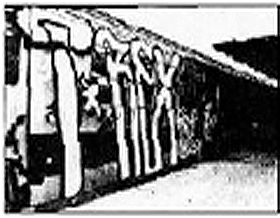
Tulissio, David (TTP) His thesis was the first by an art historian on the TTP subject and apparently the second major one done at all (after> Castleman). It focuses on the origins of TTP in Philadelphia and New York and the media discussion which followed.
Lit.: Tulissio, David: The Triumph of the>Spraycan School >. Graffiti in New York and Philadelphia c. 1968-1985. Master Thesis, Philadelphia 1986. 110 p. Stencil.
Twisted Minds Danish organisation successfully promoting e.g. the SubKult96 festival in Copenhagen, Urban Skillz in Zürich 1997 and Stocktown 98 in Sweden. The canvases from those exhibitions (including Seen, Futura 2000, Lady Pink, Blade, Quik a.o. and lots of European writers from different countries) are ment to be stored as an archive of contemporary graffiti art. > The Arrow
Twitchell, Kent > Commercial Murals
Twombly, Cy American Fine Arts painter *1929. Out of surrealistic automatism and calligraphy Twombly creates very sensitive and soft, scrawling-like paintings with expressive movements in focus.
UA (TTP) United Artists, international crew with Seen, P.Jay, Mad, Dust, Gor, Loomit a.o.
UB 40 (TTP) King of Tagging in San Francisco in the early 1990:s.
UGA (TTP) .UGA 1972-1975. United Graffiti Artists was founded by the sociology student Hugo > Martinez in N.Y. 1972, in an attempt to provide lawful alternative art work. This was the beginning of the transition from “graffiti-writers” to “graffiti-artists” and of the first legal exhibitions. The members of the original UGA group were: Amrl(Bama), Cat 87 , Coco 144 , Flint 707, Lee 163, Mico , Phase 2 , SJK 171 , Snake 1, Stitch 1, T-Rex 131 and WG. The 1:st exh. was held at City College of New York in Nov. 1972, and shortly after they were invited to work with the choreographer Twyla Tharp and the Joffrey Ballet, which was a success: spraying the background during standing ovations.The 2:nd exhibition took place at Razor Gallery, N.Y. Sept. 1973.
“The wildly expressive works…send out their caterwauling fantasia of neon super doodles and shocking-pink stars, stripes and arrows”
says S.K. Oberbeck in Newsweek , Oct. 1, 1973, p.70, and
”none of these…would not do discredits to a collection of contemporary art”
wrote Peter Scheljdal in The New York Times, Sept. 16, 1973, p.25. The 3:rd exhibition was held at Chicago Museum of Science and Industry, May-June 1974. Soon after, the group was then dissolved and replaced by> NOGA, but in the 1990:s > Martinez came back with UUA, Underground Urban Artists.
Lit.:Martinez, Hugo: ”A Brief Background of Graffiti.” In: United Graffiti Artists 1975. (catalogue.) Artists Space, 115 Wooster Street, Sept 9-27. N.Y. 1975, p. 3-7.
Underground Art The word “underground” (activity) was first used by the civil resistance movement during the WW 2. Underground Art usually means some of the subversive culture of the late sixties/early seventies in all its different shapes, with music, cartoons, fanzines, posters and fashion. Allen Ginsburg, psychedelic art, Andy Warhol and the Velvet Underground could by example be associated with this avant garde.But TTP could give this expression a > post-modern, different and contemporary meaning. And this illegal artform, the Aerosol Art, is by all means also underground in the very physical sense!
Lit.:Estren, Mark James: A History of Underground Comics. Straight Arrow Books, Berkeley 1974.
Underground Productions (TTP) Fanzine. Full colour. English. Stockholm 1992-. http://www.underground productions.se
USA Crew The first Dutch crew, constituted in early 1980s with Jezis, > Shoe, Joker and Bandi. UUA (TTP) > Martinez
VAYC (TTP) Victorian Association of Youth in Communities. Australian organisation (Joe Morris et.al.) succesfully organized legal mural jobs and aerosol art exhibitions in order to provide new opportunities for writers and turn their attention from the trains. The mural works did appear to reduce a specific number of illegal train paintings. RWA (Rage Without Alchol) in Melbourne also worked in a similar way. See > Exhibitions> Preventon.
Wack (TTP) No good.
Wall of Respect, the (TG) The first in a 1960s strong wave of neighbourhood art, this big social/ethnic painting and collage on the wall was finished in Chicago, spring 1967 by members of Organisation for Black American Culture, OBAC. Below (left): ”Wall of Respect”, Chicago 1967. The Berkeley Wall, 1968, should also be noted. Later there was a ”Wall of Respect for Women”.
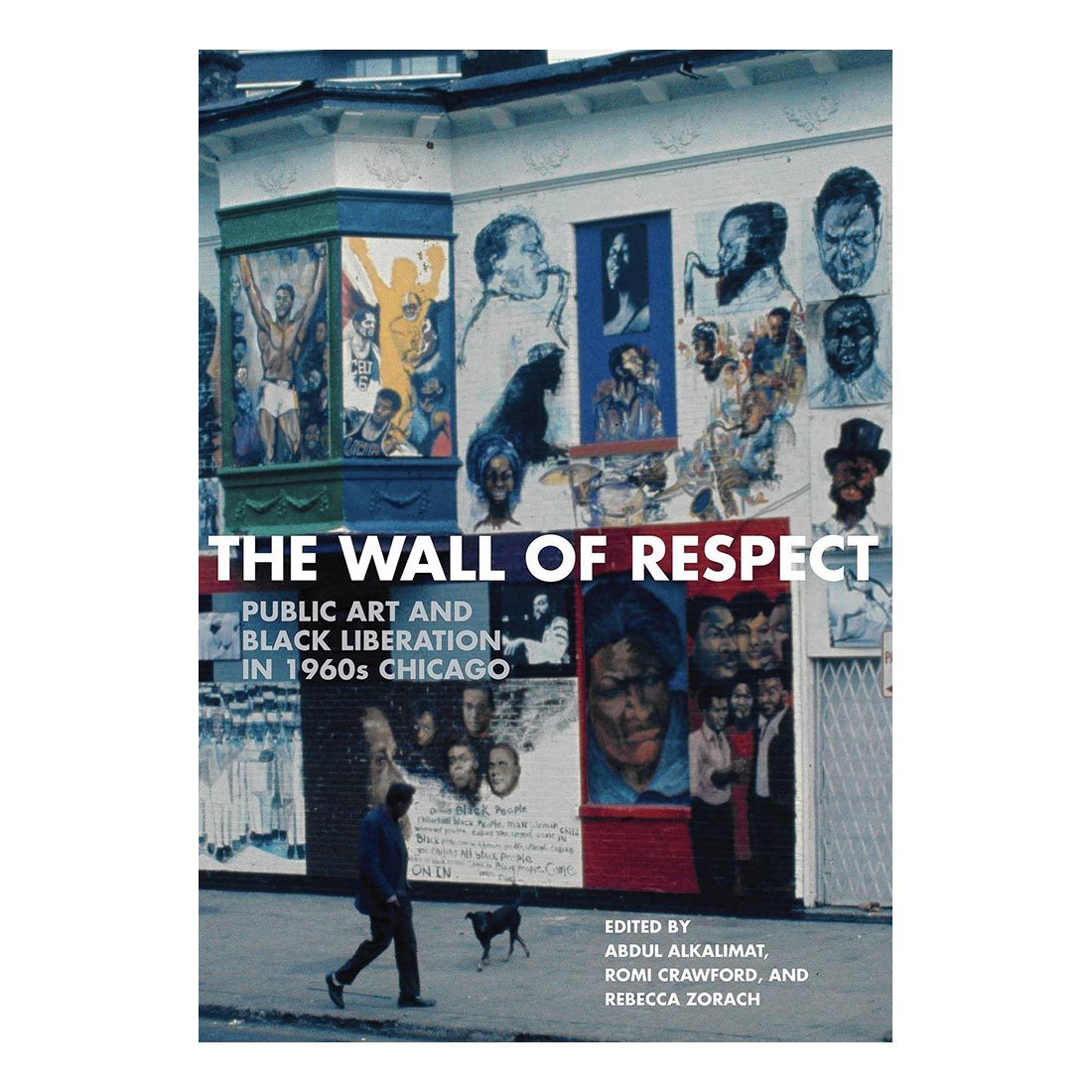
Wall of Respect on a book cover.
Lit.:“Wall of respect.” Ebony, 49, Dec. 1967. ; Cockcroft, Eva: Towards a people ́s art. E.P.Dutton, N.Y. 1977. See> Brigade painting.
Warzaw (TTP) scene in Poland seems to have an elegant, sweeping style. In trainpieces done in Warzaw, Parasite has good couloring in dark earth-tones, Islam has hardedged and streamlike letters. See also:>Aerosol School and Szwedszi pod murami! (Bibliography).
Washington Heights (TTP) This neighbourhood on the north tip of Manhattan was the home of > Taki,> Thor and lots of other pioneer taggers in New York, and it was in this black, Puerto Rican and Irish working-class community the rapid development from tags to pieces began. And> Top Cat moved to this place in c: 1969 with new impulses from the early writer scene in Philadelphia. It was also close to the South Bronx (where the> hip hop movement started in the mid-70:s). After the Bronx was tagged up, the attack on the subway system began, which united writers from all parts of the city; Brooklyn, Queens, and beyond.
WC (Writers Corner) (TTP) The first meetingsplace for writers in N.Y were the Writers Corner 188 (WC 188) on 188 Street and Audubon Avenue. And there were others too, like 149:th Street an Grand Concourse (WC 149), The Brooklyn Bridge subway station on Mahattan and the Atlantic Avenue . They existed as social meeting points until c: 1983, when those places were the target for police harassement. But at the same time there were, thanks to >Vulcan, Halls of Fame coming up as an alternative, the 1:st one on Park Avenue and 106:nd Street. the HoF concept soon went worldwide.
Weird (TTP) Swedish-egyptian writer of AiO crew, active since the mid-80:s  doing hardcore graffiti characters and canvas work in big scale, often with arabic influence. The huge mural “Fascinating” 1989 he did with Circle, and with Circle he also did a piece in the midst of the Egyptian desert!
doing hardcore graffiti characters and canvas work in big scale, often with arabic influence. The huge mural “Fascinating” 1989 he did with Circle, and with Circle he also did a piece in the midst of the Egyptian desert!
Represented at the big Peoples Art exhibition at Kulturhuset, Stockholm 1992/93. Alongside this he created a successful media career as a journalist. The ”Fascinate” painting is now carefully conservated as a offcal cultural memory.
WG (TTP) Oldschool N.Y.-writer, original member of the>UGA
Whole Car (TTP) The spray painting of a complete side of one subway car,> T-2-B and> E-2-E.
Whole Car (TTP) The spray painting of a complete side of one subway car,> T-2-B and> E-2-E.
Whole Train (TTP) A complete train set, each one of them a>whole-car. The length of a set differs (see> Freedom Train,> X-mas Train, > VIM ) but 10 cars might be an average length.
Whole Train (TTP) A complete train set, each one of them a>whole-car. The length of a set differs (see> Freedom Train,> X-mas Train, > VIM ) but 10 cars might be an average length.
Wildstyle, the history of (TTP) Wildstyle is the most unique contribution of all in TTP , and it has no earlier equivalent in the history of Art. We do not know for sure who invented the mysterious Wildstyle lettering. It could have an unknown author, or it could be a collective work. The background and reasons for the phenomena are described like this by Chalfant & Prigoff:
“There is a pressure on him [the writer] to make his style more complex, partly to enhance his reputation as a virtuoso and partly to discourage other writers from ‘biting’ or stealing it.”
There are two versions of the origins of the invention, the first is told by Bama to Castleman:
“It was some guy who lived ‘way up in the Bronx who thought it up first. He went crazy later on. I think he ́s dead now.”
The second version is, according to Jack Stewart:
“…several of them [the writers] claim to have invented the ‘Wild Style’ lettering, including Blade 1, Pel and Phase II.”
Stewart mentions an interesting forerunner to the style, “tumble letters”, and that Blade 1 claims to have done such letters in 1974. Tracy 168 was first with the name “Wildstyle” and ran a crew called this in 1974, but he did not invent the style. So again: Wildstyle could have a single, unknown author or it could have been a collective work. The latter seems more likely as this style constitutes an amalgam of different graphic characteristics (see > visual structure), all of them with an individual historic background. But at least the date is known – Wildstyle did not appear before 1977. When it did, it was the culmination of an intense and rapid stylistic development and the beginning of a new era. The letters had learned to dance!
Wildstyle, the visual structure of (TTP) ua_wil6.jpgJacobson (1996)
- FORM. 1.1.1 Fusions. 1.1.2 Ligatures. 1.2 Extensions. 1.3 Ornamentation. 1.4 Slicing and fragmentation. 1.5 Enlarging, reducing and zooming.
- PLACING. 2.1 Inclination. 2.1.1 Opposed inclination. 2.2 Overlapping.
- EXPRESSION OF RYTHM AND MOVEMENT. 3.1 Vivacity.
Below: ”Relic” wildstyle, Norrköping 1998.

Weindl (1996) also describes other characteristics, such as transparency and angled ribbons. But those are some of the more important graphic elements which make up Wildstyle together and give it the characteristic, “wild” , dancing and enigmatic look. They are discussed further in Jacobson, Staffan: Den Spraymålade Bilden. Graffitimåleriet som bildform, konströrelse och läroprocess. Aerosol Art Archives, Lund University, Lund 1996 and in Weindl, Astrid (ed.): Theorie des Style. Die befreiung des alphabets. Selbstverlag, München 1996. Below: b/w facsimile from the animated intro of C. Ahearns film ”Wildstyle”, by Zephyr. Straight letters rapidly transform into wild letters.
Wilson, Wes American graphic artist and cartoonist, important in the creation of the psychedelic letter design in 1960s San Francisco. Litt.: Noveau Frisco. Time, april 7, 1967, p. 50-53. Below: (left) Wes Wilson 1967, (right) Alfred Roller, Austria 1902.
Writers’ further careers (TTP) What happens then to the writers? The only systematic survey known to me on “what happens then” after an active writing carrier, was done by Martin Fredriksson, Lund 1998. Martin investigated 23 well-known former graffiti-writers active in 1988-92, and asked them what they where doing today. 2 persons had “an ordinary job”, the other 21 all had skilled jobs in aesthetic, creative and artistic branches. So: an overwhelming majority of this small sample became artists. Martin’s conclusion is that writing (and even scribbling) very often leads to a creative profession. There have been lots of “reunions” too, but as the writers are getting older (Futura for instance was born in 1955) the answer get increasingly interesting. More research is clearly needed.
Lit.: Fredriksson, Martin: Klotter leder till kreativa yrken. Paper, Malmö Sweden 1998.
X-mas Train and Freedom Train.The world’s first wole train (11 cars) was done in July 7, 1976 by Cain, Mad 103 och Flame One. It went to history as ”The Freedom Train”.The second whole train, 10 cars, was painted in december 1977 by Lee, Mono, Doc och Slave of Fabulous Five Crew. and is remembered as the ”Xmas Train” (below, photo courtesy Jack Stewart).
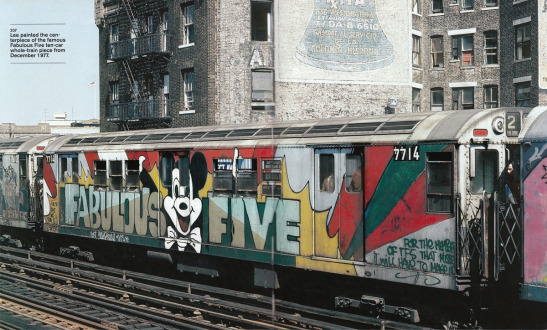
Zappo Zappo was one of the very first wrters in Sweden. Lee is his American counterpart. Zappo is campaigning against social unjustces, enviromental pollution and he also have a strong Christian bias. > Politics in TTP. Soft subjects, no aggressiveness, only patos. Cooperaton wth Amen. His pictures are full of love. Bekow: ”Admire Nature” by Zappo.

Zephyr Old School writer from N.Y.

Ziggy. Skllled artist since many years in cooperaton with Disey, lately many solo exhibtons. Courtesy Ziggy (2015).
Zero Tolerance. For many years, N Y Subway was a ”running art exhibton” with people from all countries to visiiit, a tourist attractiion. The Anti-grafft campaign originally started by Sanford D. Garelik as part of his election for Mayors offce in 1973. He ”declared war” against graffti as ”)t may be the worst pollution we have to combat”. New York Tmes (earlier a proponent of graffiti) followed in line. Miljon dollars built a fence wth razor wires around the subway lay ups,, and guards were everywhere. The Buff was cleaning the cars wth strong chemicals and the transit police were catching writers. Nothing of this worked. The whole subway fleet was painted white; the wrters continue painting, now on a fresch surface. The train paintings continued up to 1989, when the writers swift to tagging on housfronts. T.he Broken Wndows philosofi had failed. In Europe the same thng happend: Zero Tolerance failed every time. Today it is no more. The last cities who get rid of this moral panic was Minsk and Stockholm, 2014. Instead of Zero Tolerance came Harm Reduction and legal walls can now be seen in every major city. Today Aerosol Art is socially accepted worldwiide, it can cope wth new circumstances, avoid sell-out and has all the way preserved its rebellius sole. The broader Street Art phenomenen, Banksy et al, has no subcultural profile but blend together with Aerosol Art very well. Below: Graffiti Triump by Zappo.
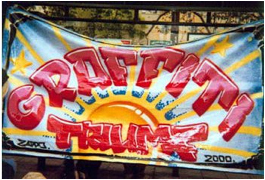
***
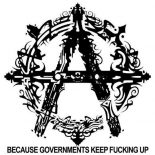


I LOVE U !!!!!!!
GillaGilla
Love you too, darliing movie star! ❤
GillaGilla
Pingback: AFA SKAPAR TRYGGHET – POLISEN GÖR DET INTE … | Konst & Politik
This is a good tip especially to those new to the blogosphere.
Brief but very accurate info… Many thanks for sharing this one.
A must read article!
GillaGilla
Thank You Aynax and good luck!
GillaGilla
Pingback: ANARKISTISK ORGANISERING. | Konst & Politik
Hey, thanks for the article post. Fantastic.
GillaGilla
Thanx!
GillaGilla
The next Submarin piece after Bremenhaven c.a 1993 by OTK 3 was a piece in the Amsterdam Harbor on two sides of a Submarin, c:a 2003. No other details are known to me, but there are photografic evidences. ./Users/staffanjacobson/Desktop/13759704045_651f542598_b.jpg
GillaGilla
world is changing
GillaGilla
Right!
GillaGilla
Best view i have ever seen !
GillaGilla
Best view i have ever seen !
GillaGilla
Thank you cordially!
GillaGilla
Thanks!
GillaGilla
Terrific article
GillaGilla
Thanks!
GillaGilla
Thanx – made me happy!
GillaGilla
Thanx Garry! Made me happy ❤ .
GillaGilla
Best view i have ever seen !
GillaGillad av 1 person
Thanx sweetheart!
GillaGilla
Thanks cordially! ❤
GillaGilla
good show, I love konstochpolitik.org !
https://konstochpolitik.org/2019/07/31/dictionary-of-aerosol-art-under-redigering-bilder-tillkommer/
GillaGilla
Thank You Lorene! ❤
GillaGilla
I am truly happy to read this website posts which consists of lots of useful facts, thanks for providing such information.
GillaGilla
[url=http://slkjfdf.net/]Iitaxu[/url] Iwoxiqe zti.nrwr.konstochpolitik.org.qye.mp http://slkjfdf.net/
GillaGilla
Howdy very nice web site!! Man .. Beautiful .. Superb ..
I will bookmark your blog and take the feeds additionally? I am glad to search out numerous useful information right here within the publish,
we’d like work out more techniques in this regard,
thanks for sharing. . . . . .
GillaGilla